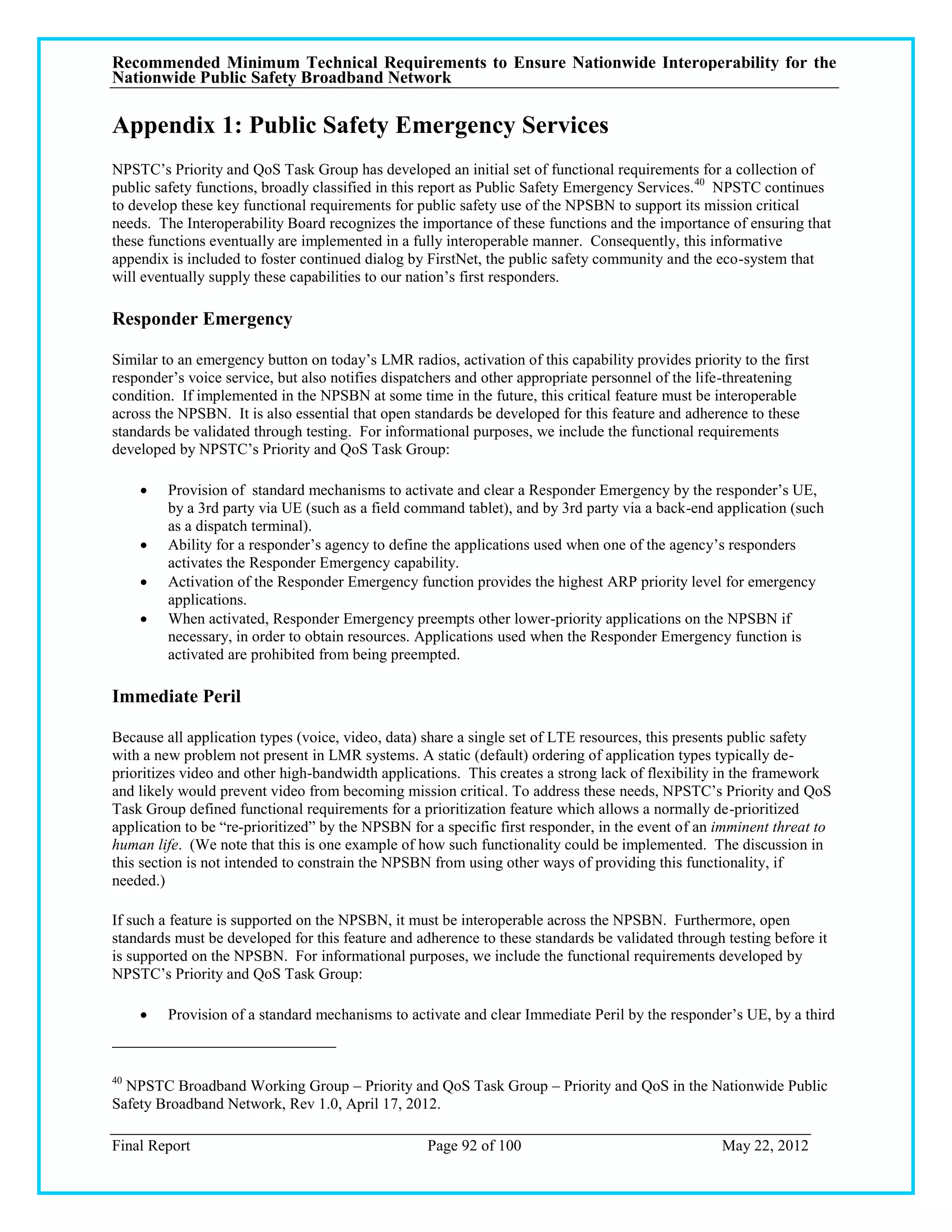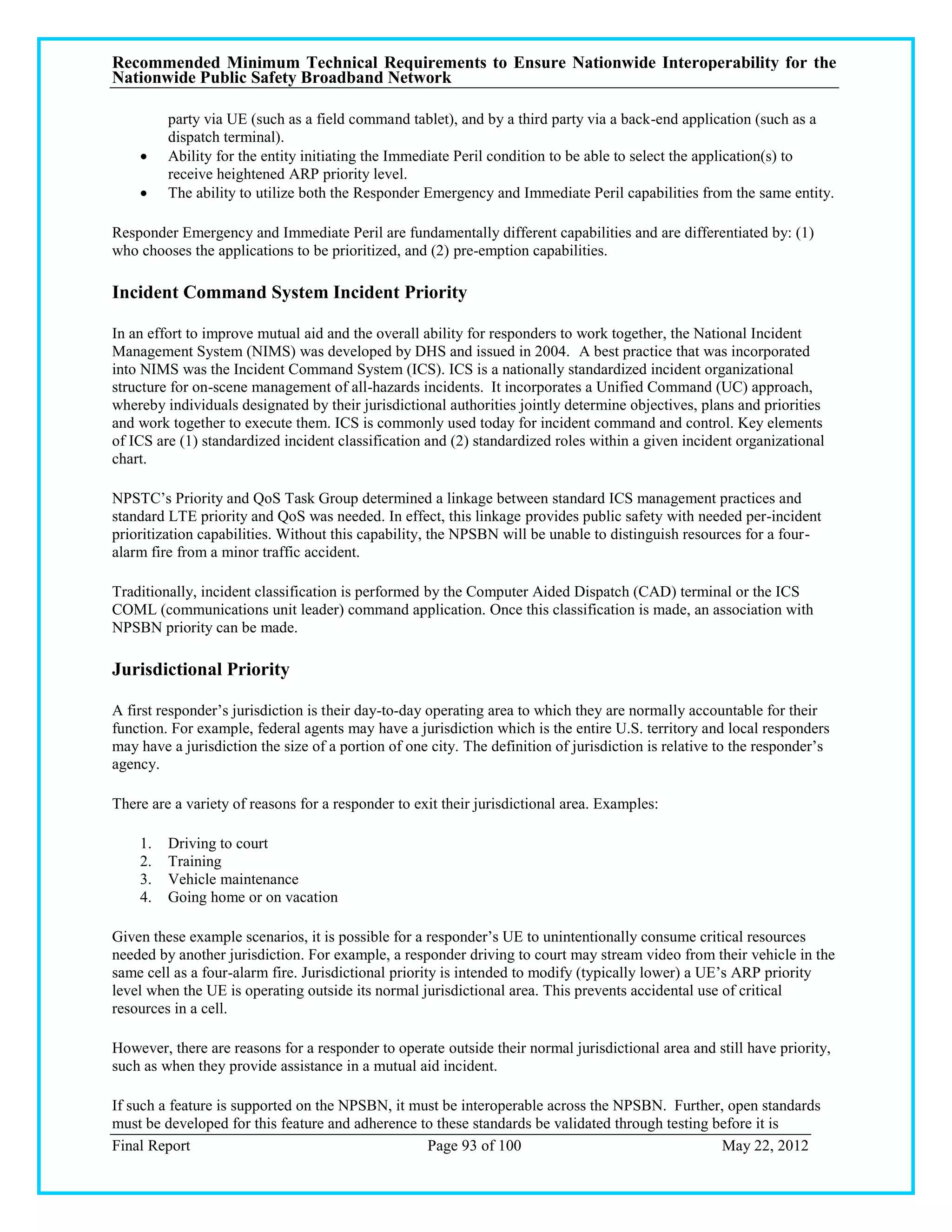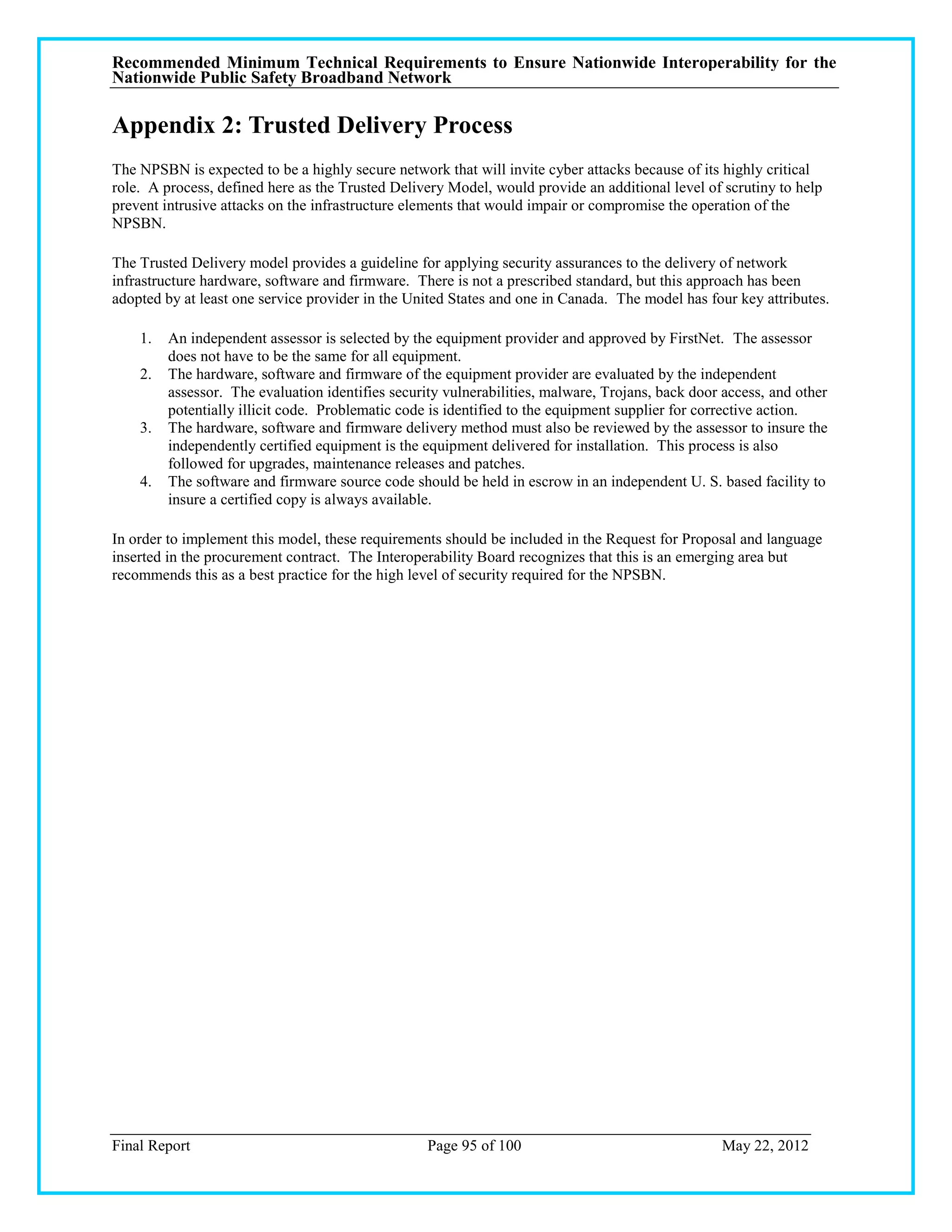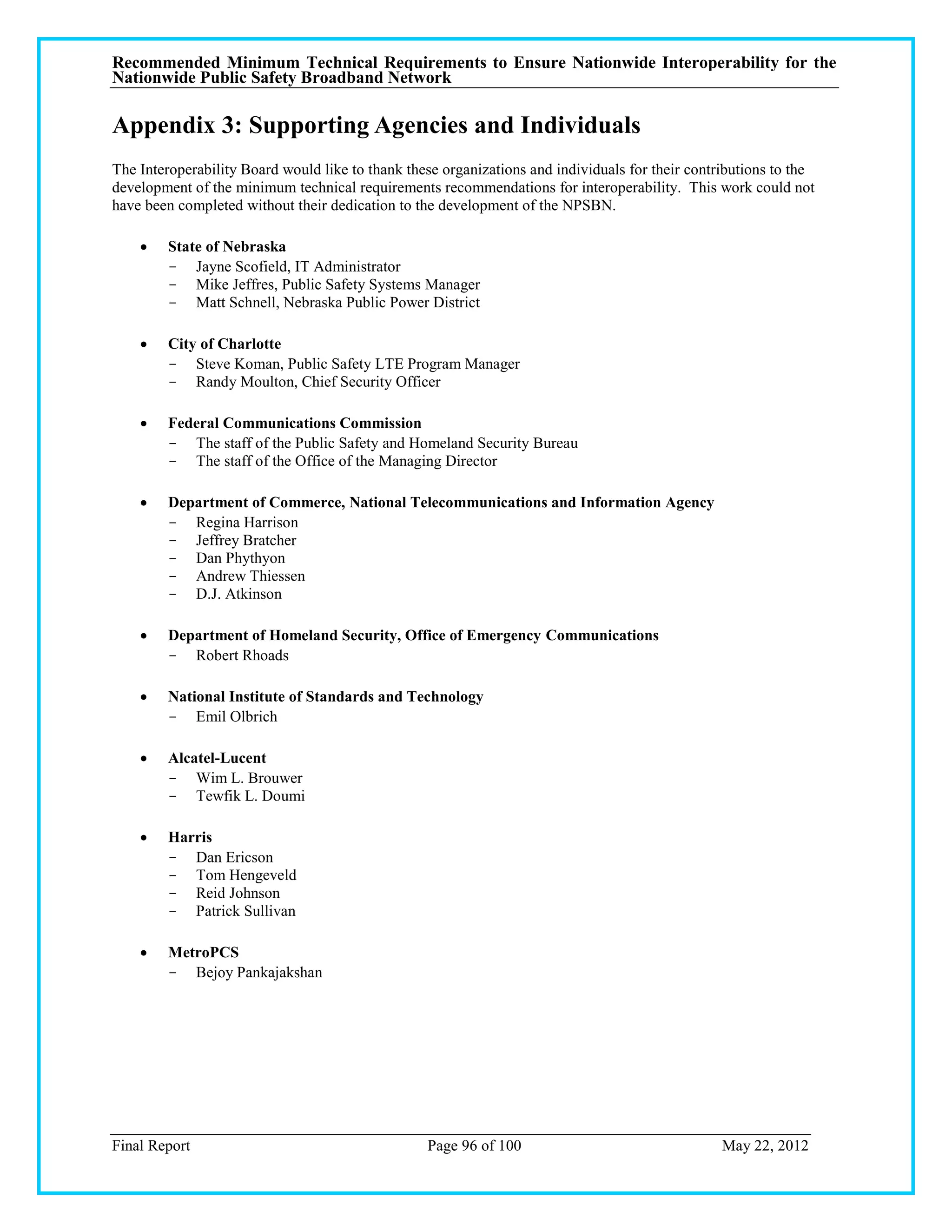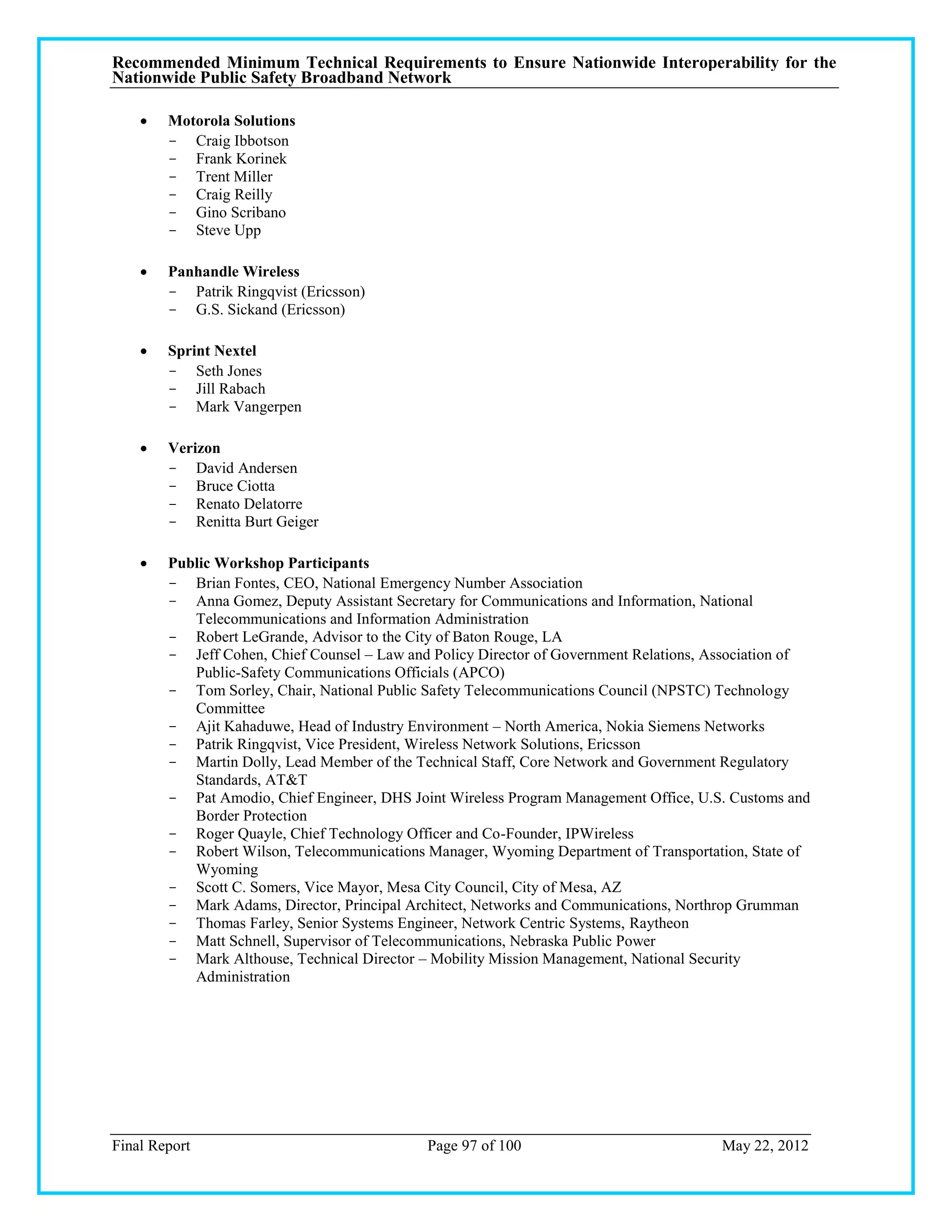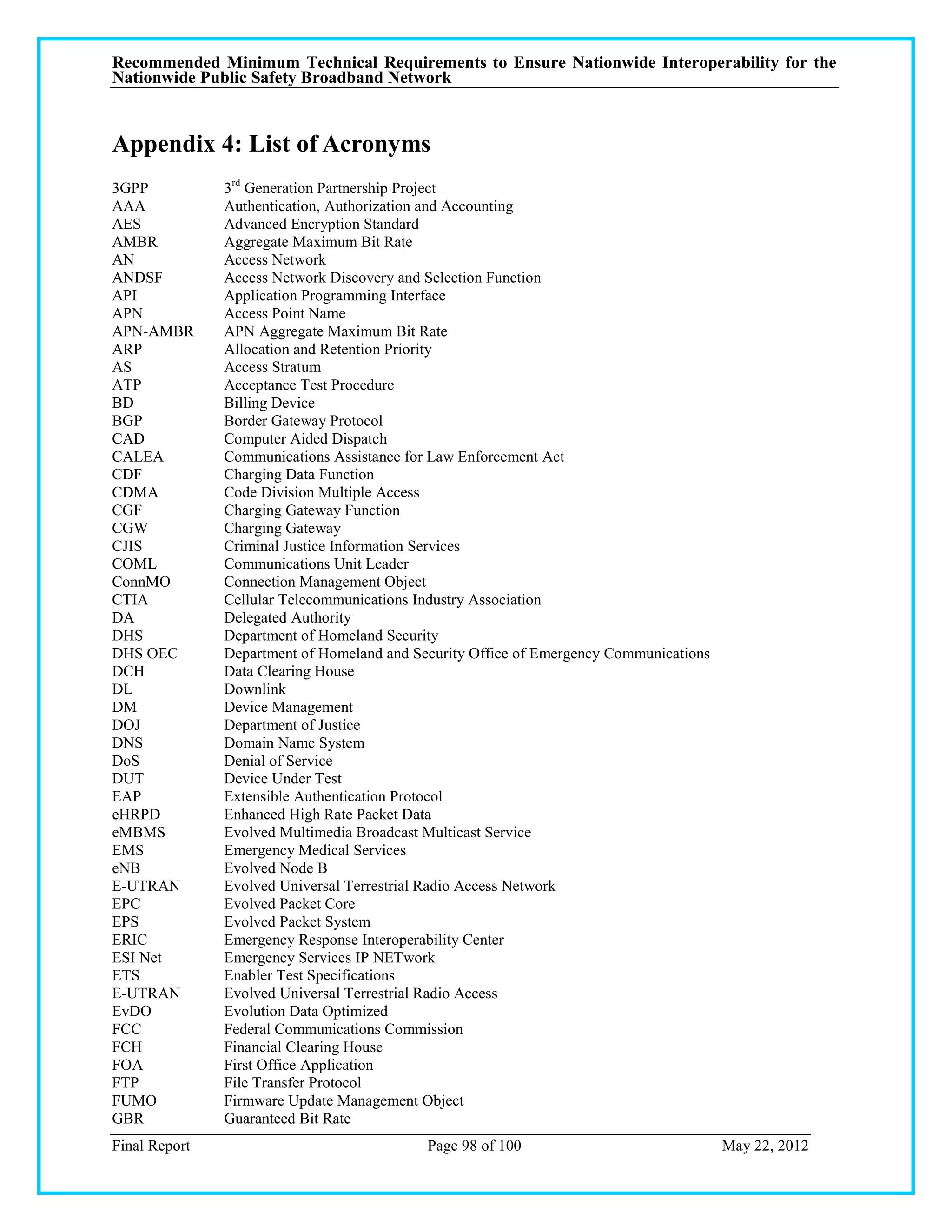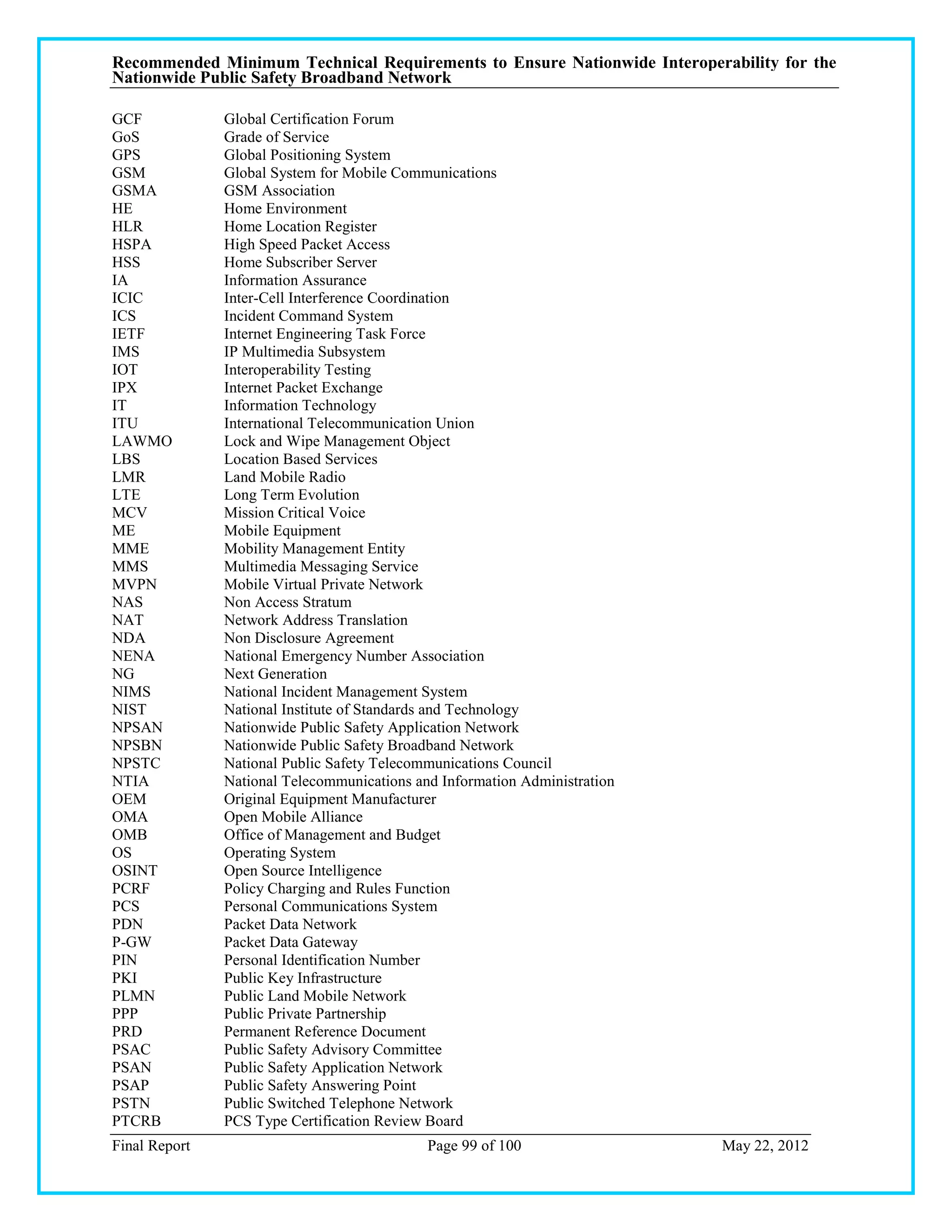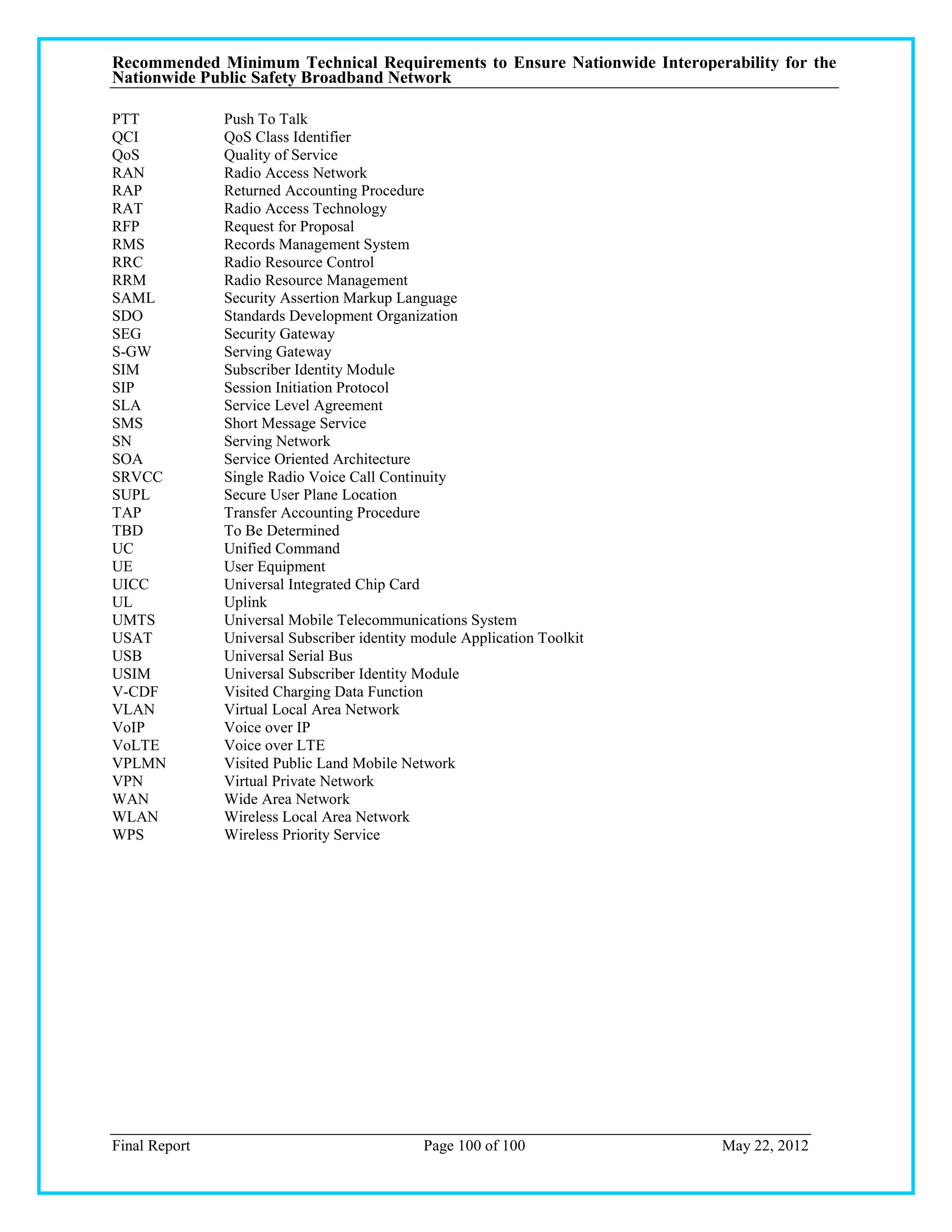The document provides recommendations for minimum technical requirements to ensure nationwide interoperability for the Nationwide Public Safety Broadband Network (NPSBN). It recommends that the NPSBN comply with 3GPP LTE standards, including adopting various 3GPP interfaces and guidelines. It also recommends requirements for user equipment and device management, testing at various levels, approaches for network evolution, standards for handover and mobility, priorities for quality of service and security measures. The recommendations are intended to enable interoperability across public safety networks and with commercial networks.
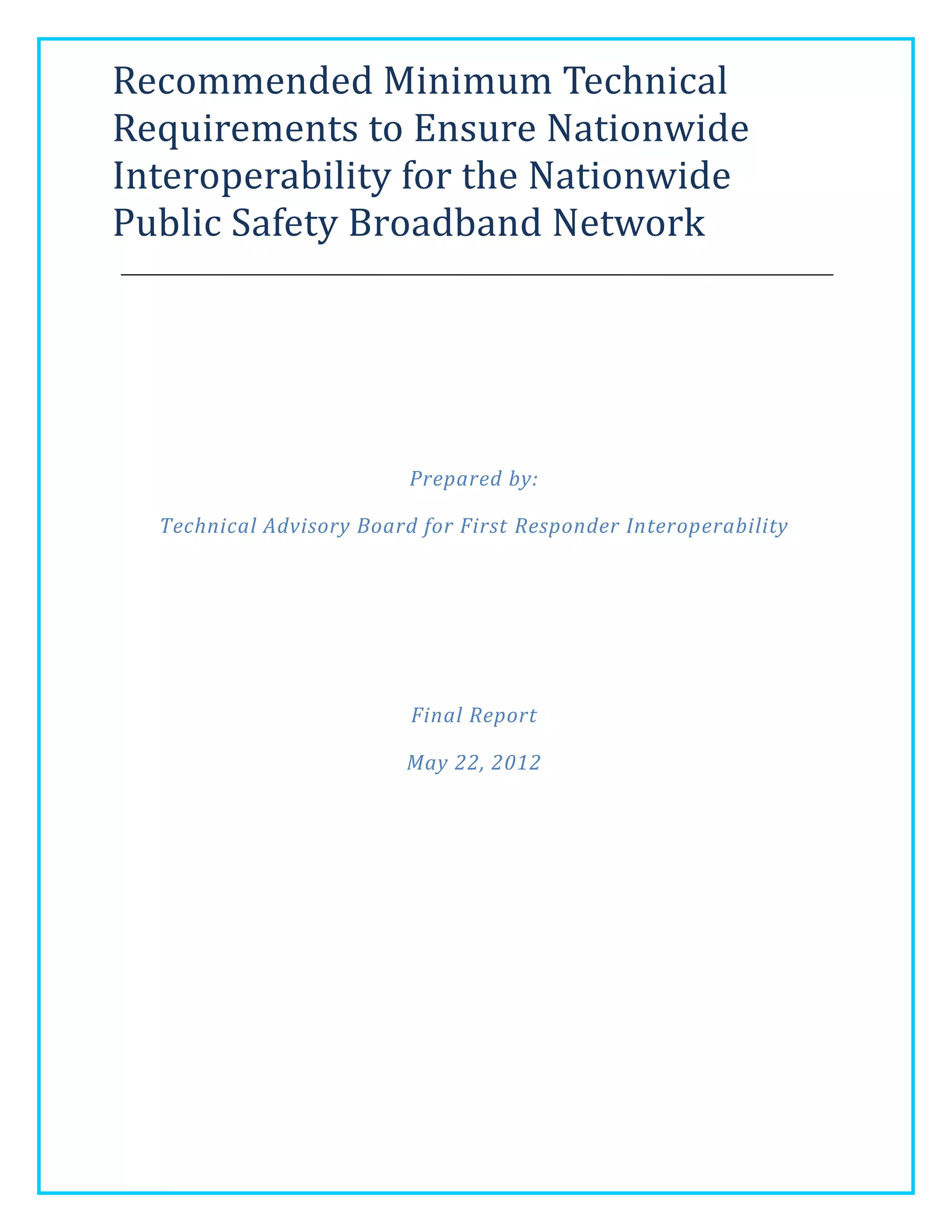
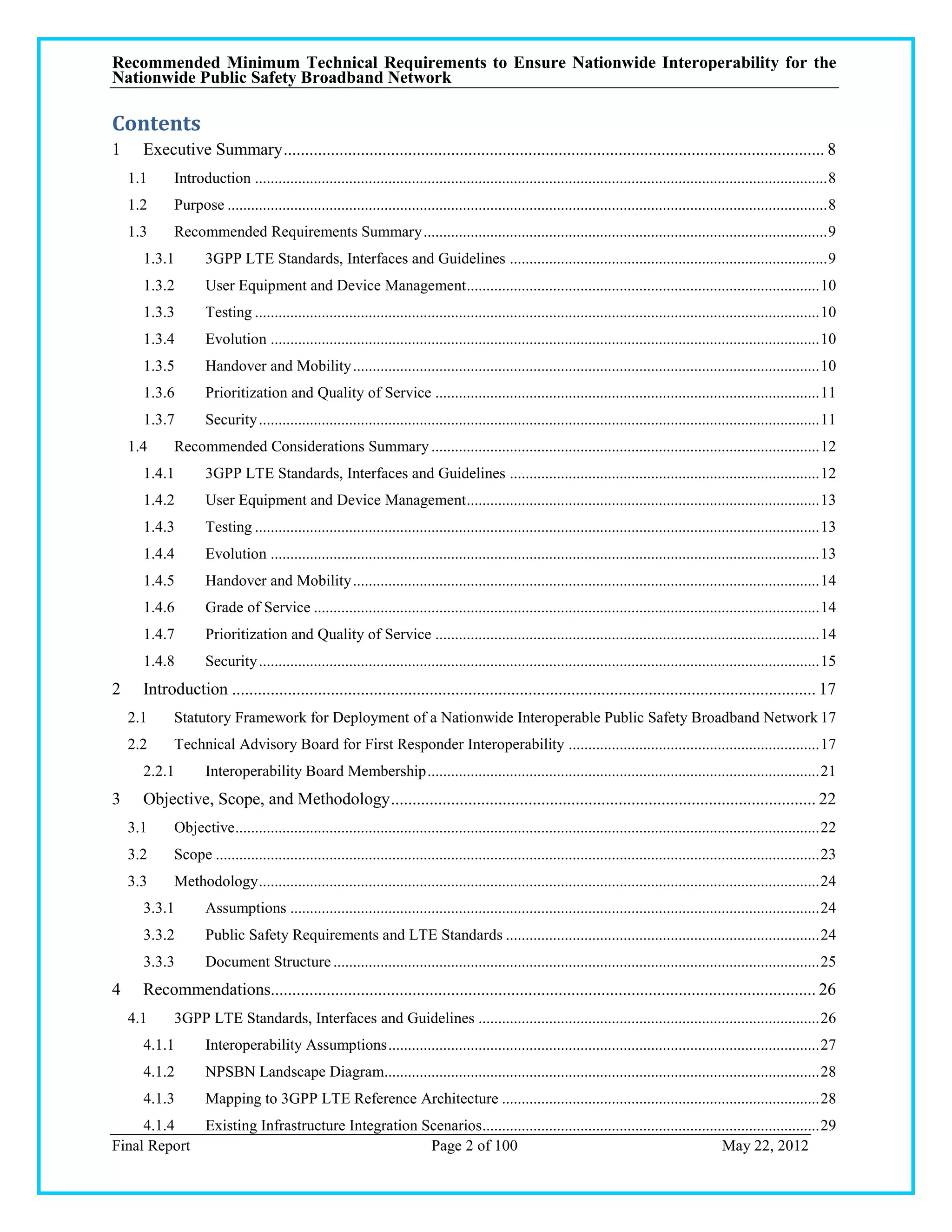
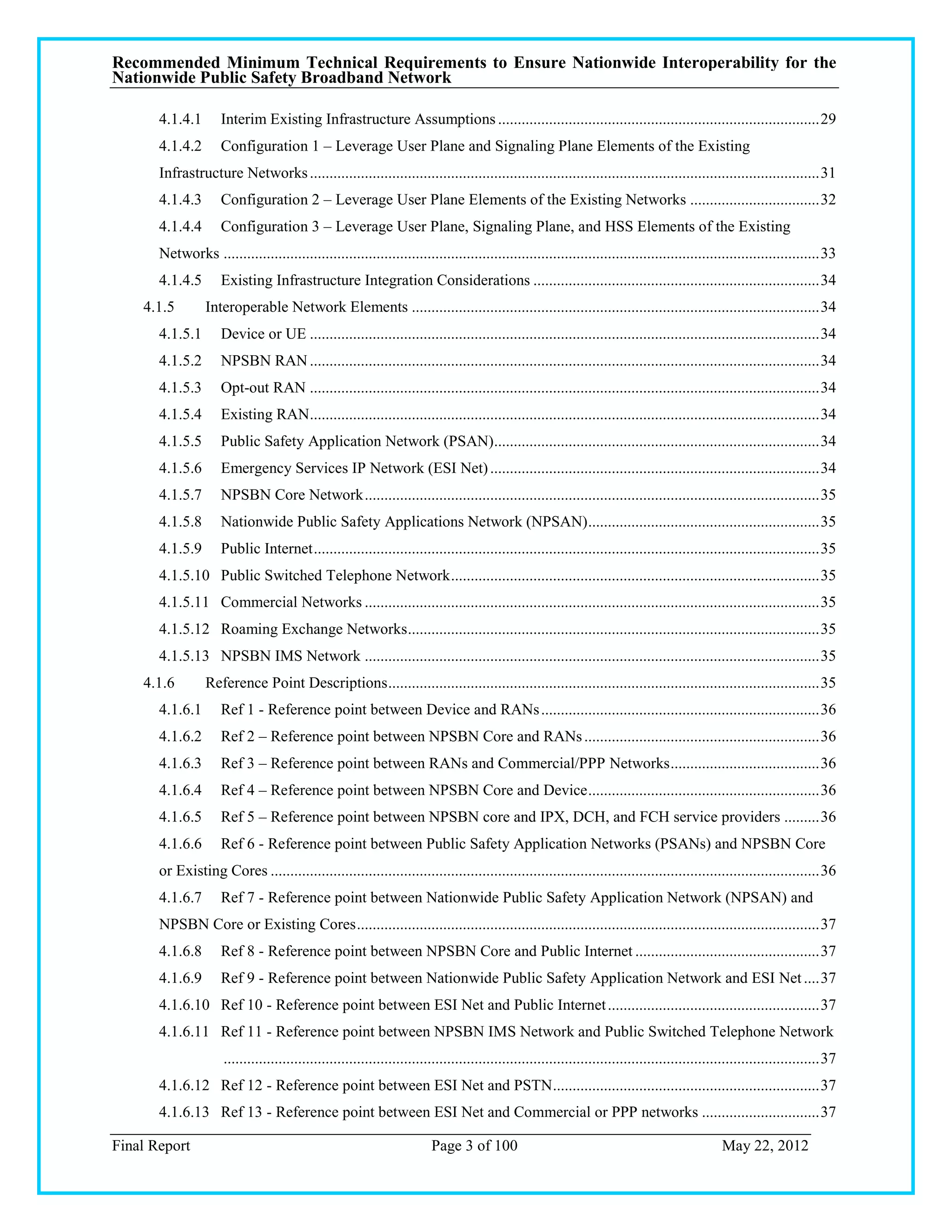
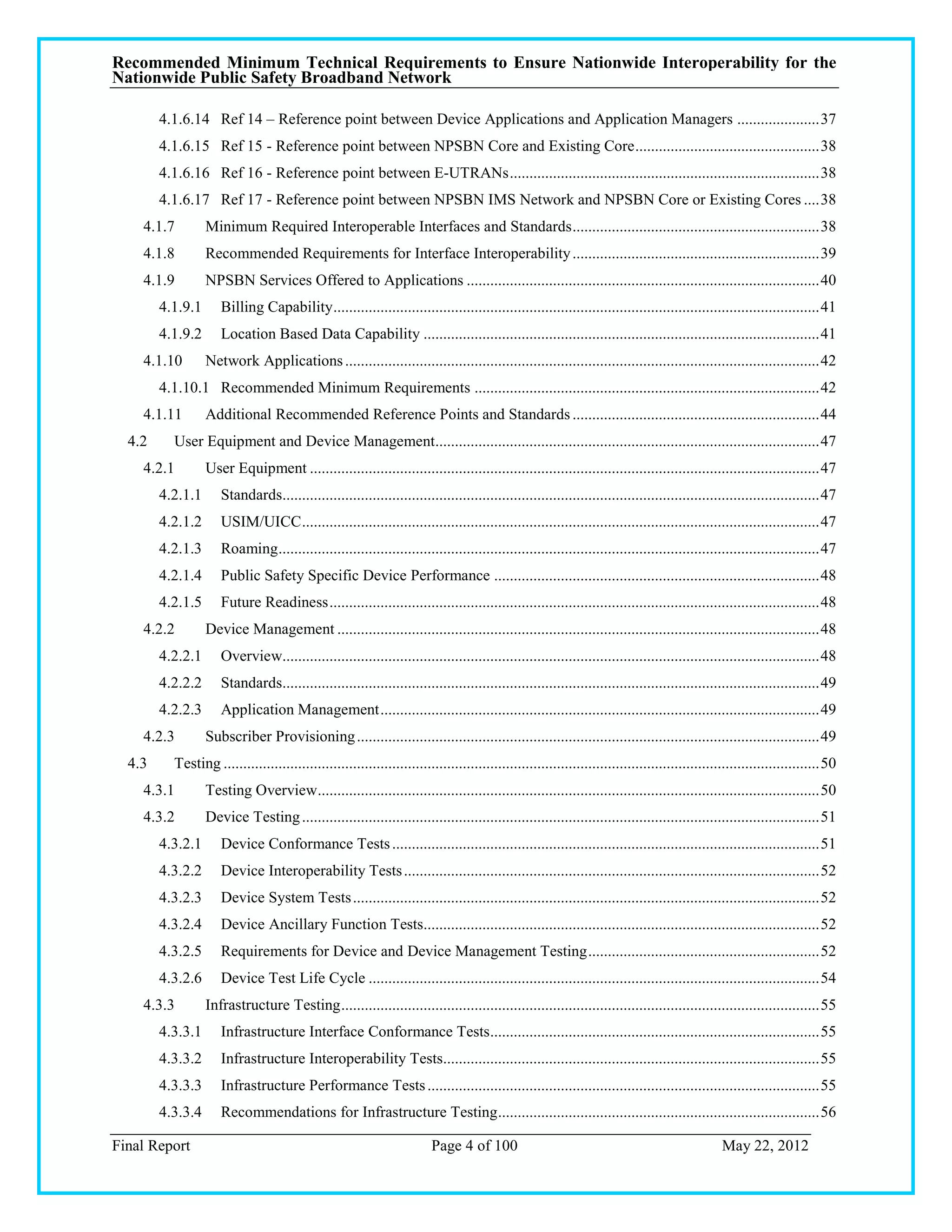
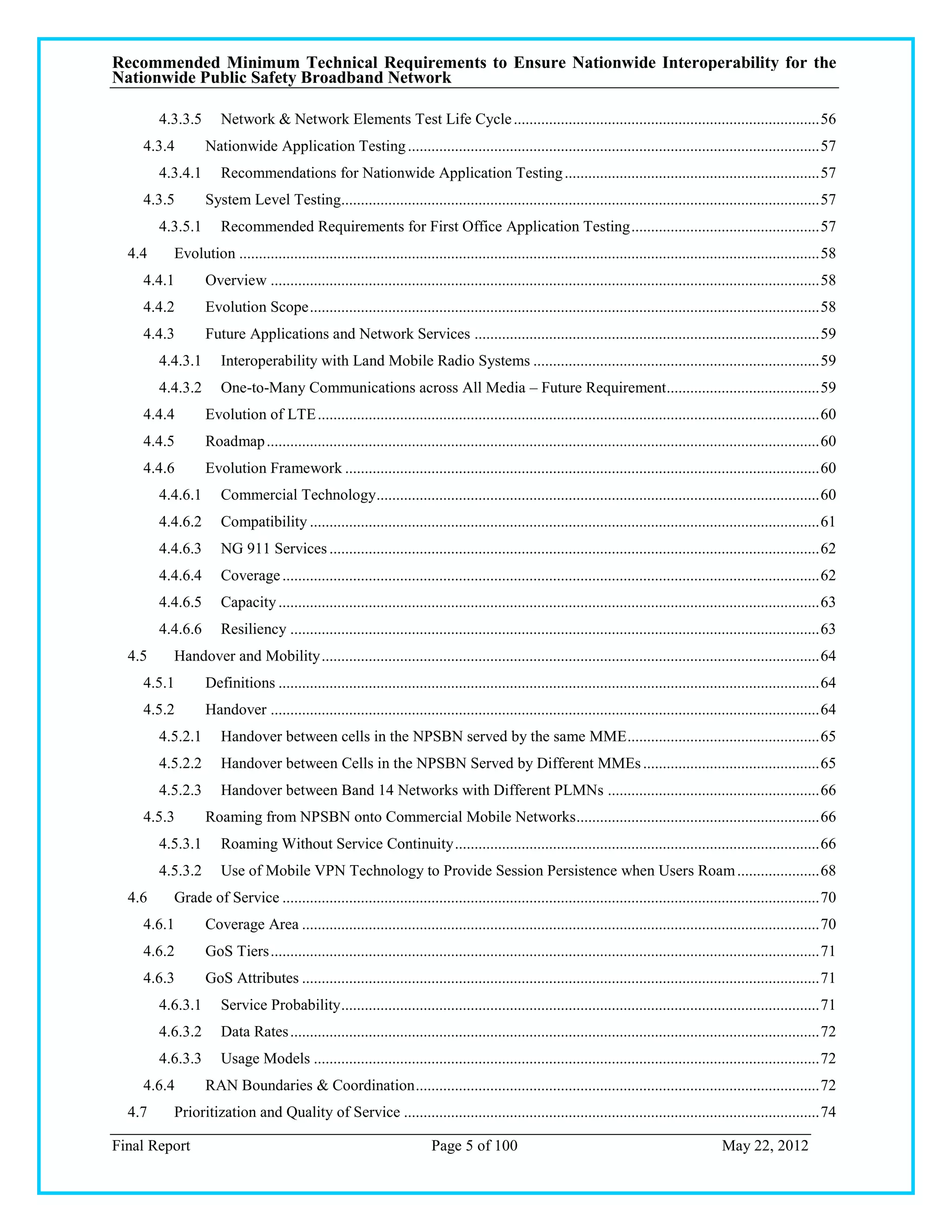
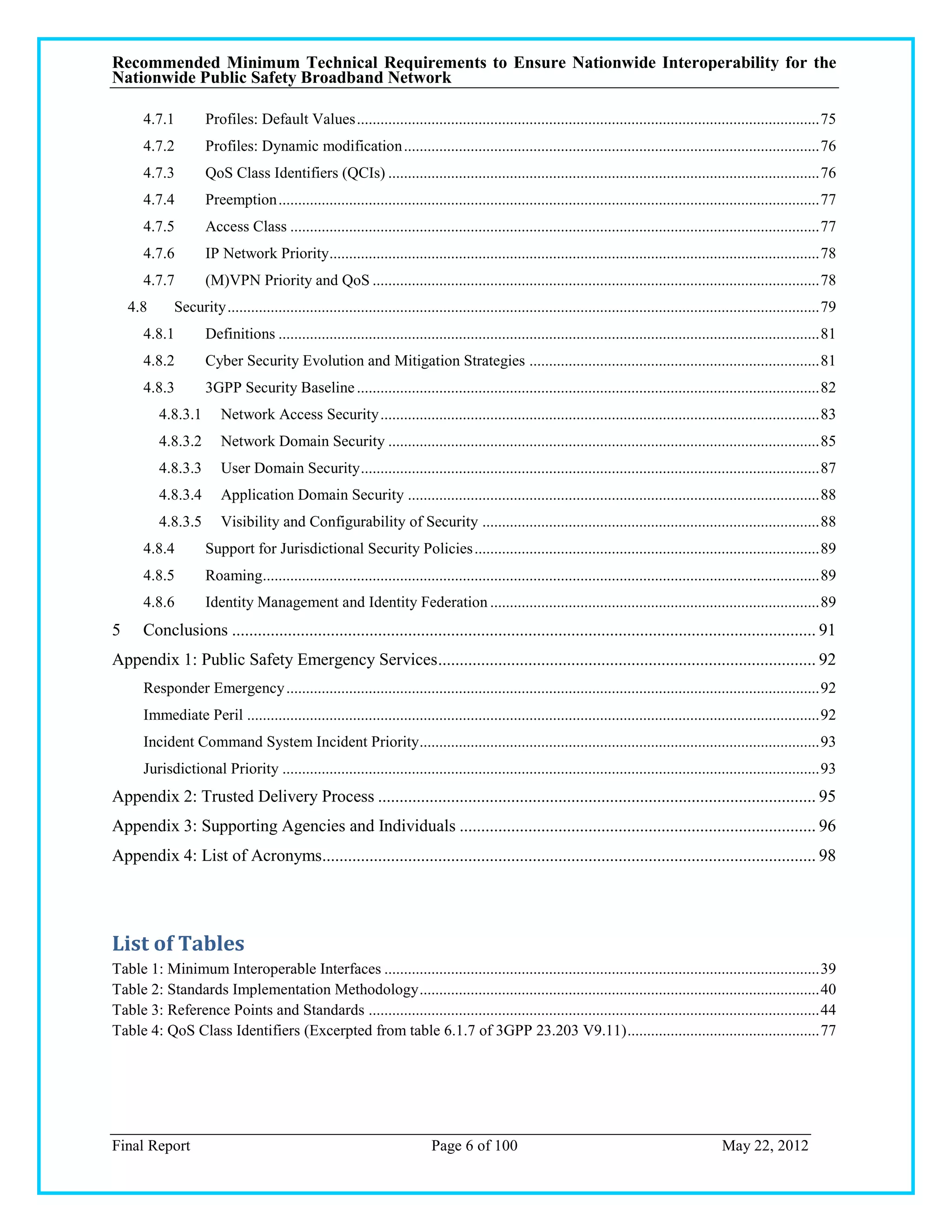

![Recommended Minimum Technical Requirements to Ensure Nationwide Interoperability for the
Nationwide Public Safety Broadband Network
1 Executive Summary
1.1 Introduction
This report fulfills the statutory reporting requirements of the Technical Advisory Board for First Responder
Interoperability pursuant to Title VI – ―Public Safety Communications and Electromagnetic Spectrum Auctions‖ of
the Middle Class Tax Relief and Job Creation Act of 2012 (Spectrum Act). 1 Pursuant to the Spectrum Act, the
Federal Communications Commission (FCC) established the Technical Advisory Board for First Responder
Interoperability (Interoperability Board). The duties of the Interoperability Board, in consultation with the NTIA,
NIST, and the Office of Emergency Communications of the Department of Homeland Security, are twofold:
(A) Develop recommended minimum technical requirements to ensure a nationwide level of interoperability
for the Nationwide Public Safety Broadband Network (NPSBN); and
(B) Submit to the Commission [FCC] for review
In fulfillment of these duties, this report presents recommendations in the following areas:
3GPP LTE Standards, Interfaces and Guidelines
User Equipment and Device Management
Testing
Evolution
Handover and Mobility
Grade of Service
Prioritization and Quality of Service
Security
1.2 Purpose
Across the United States, the public safety community responds to routine and emergency situations at a moment‘s
notice regardless of the severity. These types of situations occur daily in every city and town in the country. The
response of the public safety community relies on a communications network. Coordinated response, across agency
lines, including multiple disciplines, is necessary to protect the communities and citizens the public safety
community is charged to serve. In times of emergency, people look to their public safety officials to act swiftly and
correctly, in order to do the things necessary to save lives, help the injured, and restore order. Most disasters will
occur without warning. All require a rapid and flawless response. There is no room for error. Whether the event is
a fire, natural disaster, vehicular collision, act of terrorism or the apprehension of a suspect, the key piece of that
response is the ability to communicate. The communications network spans cities, counties and in some cases state
borders. Without reliable and interoperable communications, the safety of our nation‘s first responders becomes
jeopardized and the ability to perform their critical mission is compromised.
Two-Way Voice radio has been the predominant form of communication employed by public safety to date. With
the advent of wireless broadband, we are at the beginning of the next major epoch in mission critical
communication for first responders. The future wireless broadband network will offer additional data, video and
voice services to further improve the effectiveness and safety of first responders. The report of the Interoperability
Board specifies the ―Minimum Technical Requirements‖ necessary to achieve a national interoperable broadband
network for our nation‘s first responders. As specified in the Spectrum Act, FirstNet will use these
recommendations to help develop and maintain the NPSBN, a goal which can only be met with through extensive
and on-going cooperation among States and communities.
1
Middle Class Tax Relief and Job Creation Act of 2012, Title VI – Public Safety Communications and
Electromagnetic Spectrum Auctions.
Final Report Page 8 of 100 May 22, 2012](https://image.slidesharecdn.com/interopboardfinalreport052212-13388963580201-phpapp02-120605064116-phpapp02/75/FCC-Interop-Board-Final-Report-05-22-12-8-2048.jpg)
![Recommended Minimum Technical Requirements to Ensure Nationwide Interoperability for the
Nationwide Public Safety Broadband Network
This work is critically important to all first responders, and the future FirstNet organization that will develop,
implement and manage the network. However, we must also remember that technologies are used by people. That
component is the human factor. Whatever the technology, it will have to fit in the hands of those who will use it to
protect and serve. It will have to be as simple to use as today‘s smart phones. It will have to be ruggedized and able
to withstand the rigors of public safety use. The applications will need to be reliable and easy to use, whether a first
responder is in pursuit of a subject, responding to a medical emergency, directing traffic or reporting to the scene of
a disaster. The NPSBN will serve first responders who are part of the ―internet generation‖. This generation of
users grew up with mobile broadband technology; they adapt to it quickly and they understand the enormous
capability that it affords. They aren‘t as concerned with who builds it as they are with what applications are
available. Does it just work? Does it work everywhere? Is it automatic? What is the latest application that will
assist me in my job? Will it be as reliable, resilient and predictable in times of emergency as the land mobile radio
systems are today? Can I bet my life on it?
The underlying technology is one aspect of achieving interoperability; however, interoperability can only truly be
established and preserved over time through vigilant policies, governance, and practices associated with creation,
evolution and operation of the network by FirstNet.
1.3 Recommended Requirements Summary
In all cases where these recommendations reference specific 3GPP standards (e.g. 3GPP TS 36.101), the
intended meaning is that the standard to be applied is contained in Release 9 of the 3GPP standards, or the
future evolved equivalent of that standard that applies to future releases.
1.3.1 3GPP LTE Standards, Interfaces and Guidelines
[1] Hardware and software systems comprising the NPSBN SHALL implement interfaces consistent with
Table 2: Standards Implementation Methodology.
[2] Hardware and software systems comprising the NPSBN SHALL support the interfaces enumerated in
Table 1: Minimum Interoperable Interfaces.
[3] Hardware and software systems comprising the NPSBN SHALL support management functions.
[4] Hardware and software systems comprising the NPSBN SHALL support APNs defined for PSAN usage.
[5] Hardware and software systems comprising the NPSBN SHALL support nationwide APNs for
interoperability.
[6] Hardware and software systems comprising the NPSBN SHALL enable QoS control for PSAN-hosted
applications via the 3GPP ‗Rx‘ interface.
[7] The NPSBN SHALL support IPv4, IPv6, and IPv4/v6 PDN types defined in 3GPP TS 23.401.
[8] The NPSBN SHALL support IPv4 and/or IPv6 transport for the EPS interfaces enumerated in Table 1:
Minimum Interoperable Interfaces, consistent with the FirstNet design.
[9] Any sharing agreement that FirstNet enters into SHALL implement network sharing according to 3GPP
TS 23.251 and SHALL NOT impact public safety operations.
[10] The NPSBN SHALL include the capability to collect and convey UE location data to applications using a
standardized interface in near real time.
[11] The NPSBN SHALL be capable of providing public safety subscribers with access to the global Internet.
Final Report Page 9 of 100 May 22, 2012](https://image.slidesharecdn.com/interopboardfinalreport052212-13388963580201-phpapp02-120605064116-phpapp02/75/FCC-Interop-Board-Final-Report-05-22-12-9-2048.jpg)
![Recommended Minimum Technical Requirements to Ensure Nationwide Interoperability for the
Nationwide Public Safety Broadband Network
1.3.2 User Equipment and Device Management
[12] All User Devices (UEs) deployed on the NPSBN SHALL conform to the 3GPP Release 9 Uu interface
enumerated in Table 1: Minimum Interoperable Interfaces.
[13] All User Devices (UEs) deployed on the NPSBN SHALL conform to the 3GPP TS 36.306 UE Radio
Access Capabilities, Release 9.
[14] All User Devices (UEs) SHALL support interworking of the device with the USIM/USAT applications on
the UICC in accordance with the relevant 3GPP 31.101, 31.102, and 31.111 standards.
[15] All User Devices (UEs) deployed on the NPSBN that support roaming onto commercial LTE networks
SHALL operate on any FirstNet roaming partner network using bands supported by the device.
[16] All UEs SHALL support dual IPv4/IPv6 stacks.
1.3.3 Testing
[17] Prior to IOT and System-Level testing UEs SHALL have already met 3GPP conformance and certification
requirements per an independent conformance testing organization (e.g. PTCRB).
[18] Prior to operational deployment on the NPSBN, UEs SHALL have passed FirstNet-required
Interoperability Testing (e.g. using a subset of applicable test cases from CTIA IOT and UICC functional test cases,
vendor IOT or similar commercial LTE industry practice).
[19] Prior to operational deployment on the NPSBN, UEs SHALL have passed FirstNet-required UICC
functional testing.
[20] Prior to operational deployment on the NPSBN, infrastructure equipment SHALL have passed FirstNet-
required Interface Conformance Testing (e.g. testing S1-MME conformance to 3GPP) on the interfaces specified by
FirstNet.
[21] Prior to operational deployment on the NPSBN, infrastructure equipment SHALL have passed FirstNet-
required Interoperability Testing at a system level as per the specific IOT requirements for the NPSBN.
[22] Infrastructure deployed on the NPSBN SHALL be included in the FirstNet-required FOA process as part
of the NPSBN deployment.
1.3.4 Evolution
[23] The equipment comprising the NPSBN SHALL provide backwards compatibility of interfaces, from time
of deprecation, for a minimum of two full major release/upgrades of the network. This requirement may be waived
(i.e., interface obsolescence accelerated) if FirstNet can ascertain from the user community that there are no
dependencies on a given interface.
1.3.5 Handover and Mobility
[24] The NPSBN SHALL support user mobility across the entire NPSBN (including Opt-out states).
[25] The NPSBN SHALL support S1 and SHALL preferentially support X2 handover between adjacent
NPSBN cells (including cells owned by opt-out states) whose proximity supports a handover opportunity.
Final Report Page 10 of 100 May 22, 2012](https://image.slidesharecdn.com/interopboardfinalreport052212-13388963580201-phpapp02-120605064116-phpapp02/75/FCC-Interop-Board-Final-Report-05-22-12-10-2048.jpg)
![Recommended Minimum Technical Requirements to Ensure Nationwide Interoperability for the
Nationwide Public Safety Broadband Network
[26] If roaming between the NPSBN and commercial LTE networks is implemented, the NPSBN SHALL
follow GSMA PRD IR.88.
[27] If roaming between the NPSBN and commercial 3GPP 2G/3G networks is implemented, the NPSBN
SHALL follow 3GPP TS 23.002 to support roaming into 3GPP 2G/3G networks.
[28] If roaming between the NPSBN and commercial 3GPP2 (eHRPD) networks is implemented, the NPSBN
SHALL follow 3GPP 23.402 to support roaming into 3GPP2 (eHRPD) networks.
[29] The NPSBN SHALL support the use of mobile VPN technology to support mobility between the NPSBN
and other networks.
1.3.6 Prioritization and Quality of Service
[30] The NPSBN SHALL provide the ability for national, regional, and local applications to dynamically
change a UE‘s prioritization and QoS using the 3GPP ‗Rx‘ interface.
[31] The NPSBN SHALL support all 9 QCI classes specified in table 6.1.7 of 3GPP 23.203 v9.11 or future
equivalents.
[32] QoS mechanisms in the NPSBN SHALL comply with 3GPP TS 23.203.
[33] The NPSBN SHALL support the usage of all 15 ARP values defined in 3GPP 23.203.
[34] The NPSBN SHALL support the ARP pre-emption capability and vulnerability functions as defined in
3GPP 23.203.
[35] The NPSBN SHALL implement a nationwide scheme for assigning Access Classes to public safety users
and secondary users following the 3GPP recommendations in TS 22.011, Section 4.2.
[36] The NPSBN SHALL implement a nationwide scheme for assigning QoS Class Identifier priority to IP
network and backhaul priority across the entire NPSBN.
[37] The NPSBN SHALL support the use of industry standard VPN and MVPN technology, while providing
priority and Quality of Service for encapsulated applications.
1.3.7 Security
[38] The NPSBN SHALL use a nationwide common security profile for user plane and control plane traffic
between UEs, eNBs and MMEs, in accordance with 3GPP LTE Network Access Domain protocols. The profile
SHALL be based on 3GPP TS 33.401, and will be determined by FirstNet based on a system design and other
considerations as it deals with evolving cyber threats. As a minimum, the profile SHALL include specification of
ciphering algorithms (for example, use of AES-128 vs. SNOW 3G).
[39] The nationwide common security profile SHALL include ciphering of control plane traffic in order to
provide for interoperable cyber protection of the network. Ciphering of user plane traffic is optional and is based on
policy decisions that involve FirstNet and user agencies.
[40] To enable interoperable authentication, the USIM and HSS SHALL be capable of supporting the same key
derivation functions, such as Milenage per 3GPP TS 35.205, 35.206.
[41] Network Domain Security SHALL be implemented in accordance with 3GPP TS 33.210, which stipulates
the use of IPSec to protect IP communication between administrative domains (including all network connections
Final Report Page 11 of 100 May 22, 2012](https://image.slidesharecdn.com/interopboardfinalreport052212-13388963580201-phpapp02-120605064116-phpapp02/75/FCC-Interop-Board-Final-Report-05-22-12-11-2048.jpg)
![Recommended Minimum Technical Requirements to Ensure Nationwide Interoperability for the
Nationwide Public Safety Broadband Network
used to interconnect the domains).
[42] The NPSBN SHALL comply with TS 33.310 as the authentication framework for Public Key
Infrastructure to authenticate these network interfaces.
[43] In order to ensure secure and interoperable interfaces between the NPSBN and external elements (e.g. all
SGi, Rx and Srvs services as shown in Figure 2), these interfaces SHALL be protected with a FirstNet-approved
security mechanism.
[44] User Domain Security SHALL be implemented in accordance with 3GPP TS 33.102, TS 31.101, and TS
22.022.
[45] USIM-based applications that require messaging between the USIM and network components SHALL
implement Application Domain Security in accordance with 3GPP TS 33.102 and TS 31.111.
[46] In such cases where visibility is required for devices on the NPSBN, the implementations SHALL comply
with 3GPP TS 33.102 and TS 22.101.
1.4 Recommended Considerations Summary
This section contains recommendations for consideration by the FCC and FirstNet as they develop finalized
requirements to be included in RFPs. These recommendations for consideration are distinct from the recommended
requirements in the previous sections, in that they are not considered by the Interoperability Board to be in scope as
described in Section 3.2.
1.4.1 3GPP LTE Standards, Interfaces and Guidelines
(1) Hardware and software systems comprising the NPSBN SHOULD support integration of existing network
elements via the necessary commercial standards-defined LTE interfaces enumerated in Table 1: Minimum
Interoperable Interfaces.
(2) Billing information from the NPSBN SHOULD be provided to each local and/or regional entity for the
NPSBN services.
(3) The NPSBN SHOULD support existing Public Safety applications, deployed regionally or within
agencies.
(4) The NPSBN SHOULD provide a method to connect a device to a packet data network where a ―home
page‖ application is hosted with location specific content.
(5) The NPSBN SHOULD provide a method where a ―home page‖ application is available via an alternate
access network, other than the NPSBN. This is a recommendation that the home page be made available and
location-aware while roaming or over Wi-Fi.
(6) The NPSBN SHOULD provide a specification for locating a ―home page‖ based on current or manual
location.
(7) The NPSBN SHOULD support use of field-deployed server applications.
(8) The NPSBN SHOULD support devices that are reachable via the global internet and can be used to host
field based server applications (i.e. deployable servers).
Final Report Page 12 of 100 May 22, 2012](https://image.slidesharecdn.com/interopboardfinalreport052212-13388963580201-phpapp02-120605064116-phpapp02/75/FCC-Interop-Board-Final-Report-05-22-12-12-2048.jpg)
![Recommended Minimum Technical Requirements to Ensure Nationwide Interoperability for the
Nationwide Public Safety Broadband Network
(9) The NPSBN SHOULD allow the devices outside of their normal jurisdiction to connect to a local packet
data network and to the device‘s home packet data network to carry out incident objectives.
(10) The NPSBN SHOULD provide the ability for users to send and receive Short Message Service (SMS) and
Multimedia Messaging Service (MMS) messages.
(11) Voice Sessions SHOULD be handed off within the NPSBN with limited delay and loss of audio during the
transition. Because the devices and device capabilities for this feature will develop over time, this feature is a future
evolution capability.
(12) The NPSBN SHOULD support Voice over LTE (cellular voice) capabilities using GSMA PRD IR.92.
1.4.2 User Equipment and Device Management
(13) The NPSBN SHOULD allow the integration of high power LTE UEs as they become available, based on
the methodology contained in Table 2: Standards Implementation Methodology.
(14) User Devices and Device Management solutions SHOULD support remote management capabilities over-
the-air, including software update, discovery, device platform configuration, lock, unlock, wipe, and security
configuration.
(15) The software systems that comprise the NPSBN SHOULD support the ability to enable local entities to
install, update and manage their own applications. This may include security, transport and local APN provisioning.
(16) The software systems that comprise the NPSBN SHOULD provide published and version-controlled
subscriber provisioning interfaces to enable end-to-end subscriber provisioning by the local entities. These
interfaces SHOULD be verified during interoperability testing.
1.4.3 Testing
(17) Prior to operational deployment on the NPSBN, infrastructure equipment SHOULD have passed FirstNet-
required Performance Testing of individual interfaces, nodes and overall system as per the specific performance
requirements of the NPSBN.
(18) Nationwide applications on the NPSBN SHOULD have passed FirstNet-required security testing to proper
security levels (e.g. Criminal Justice Information Services [CJIS]) to ensure protection of FirstNet and public safety
information.
1.4.4 Evolution
(19) The NPSBN SHOULD allow for connection and operation of IP-based LMR voice interoperability
gateways using open interfaces as they are developed.
(20) The NPSBN SHOULD be constructed and evolved in adherence to a multi-year roadmap.
(21) Infrastructure equipment procured for the NPSBN SHOULD support backwards compatibility with
deployed LTE devices.
(22) Infrastructure equipment in the NPSBN SHOULD be upgradeable to minimally two major 3GPP releases
(i.e. n+2, where n is the release available at deployment provided that the equipment does not need to implement a
new air interface specification).
Final Report Page 13 of 100 May 22, 2012](https://image.slidesharecdn.com/interopboardfinalreport052212-13388963580201-phpapp02-120605064116-phpapp02/75/FCC-Interop-Board-Final-Report-05-22-12-13-2048.jpg)
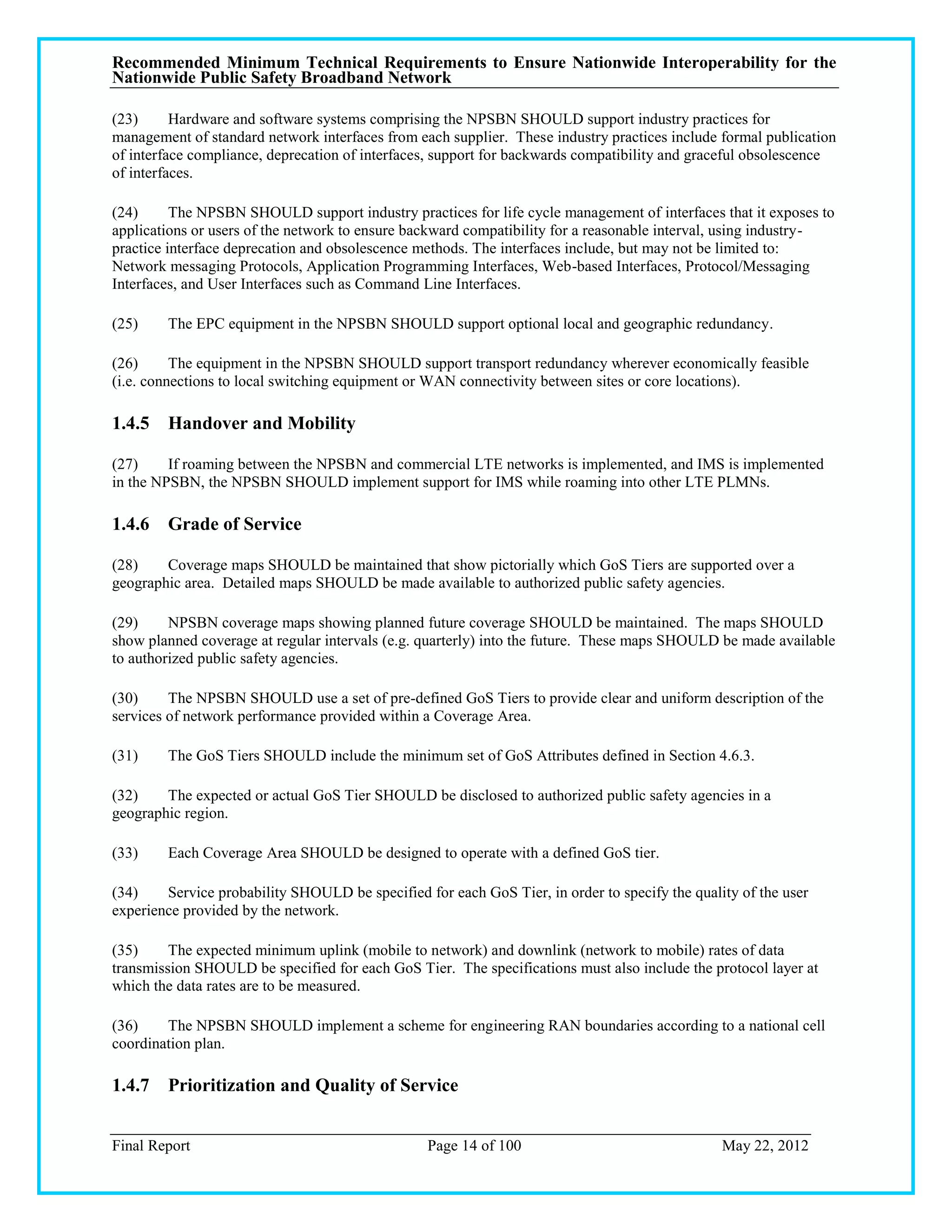
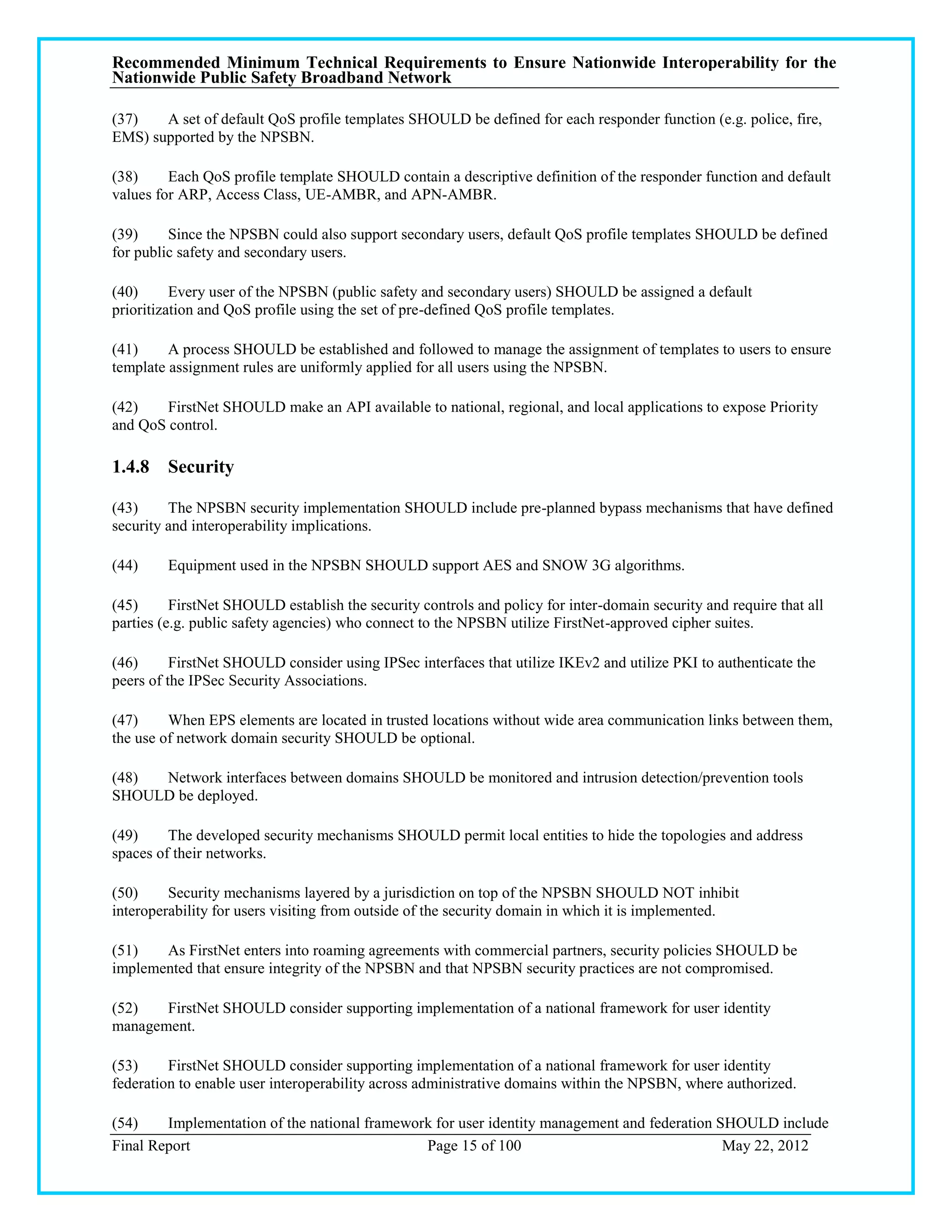
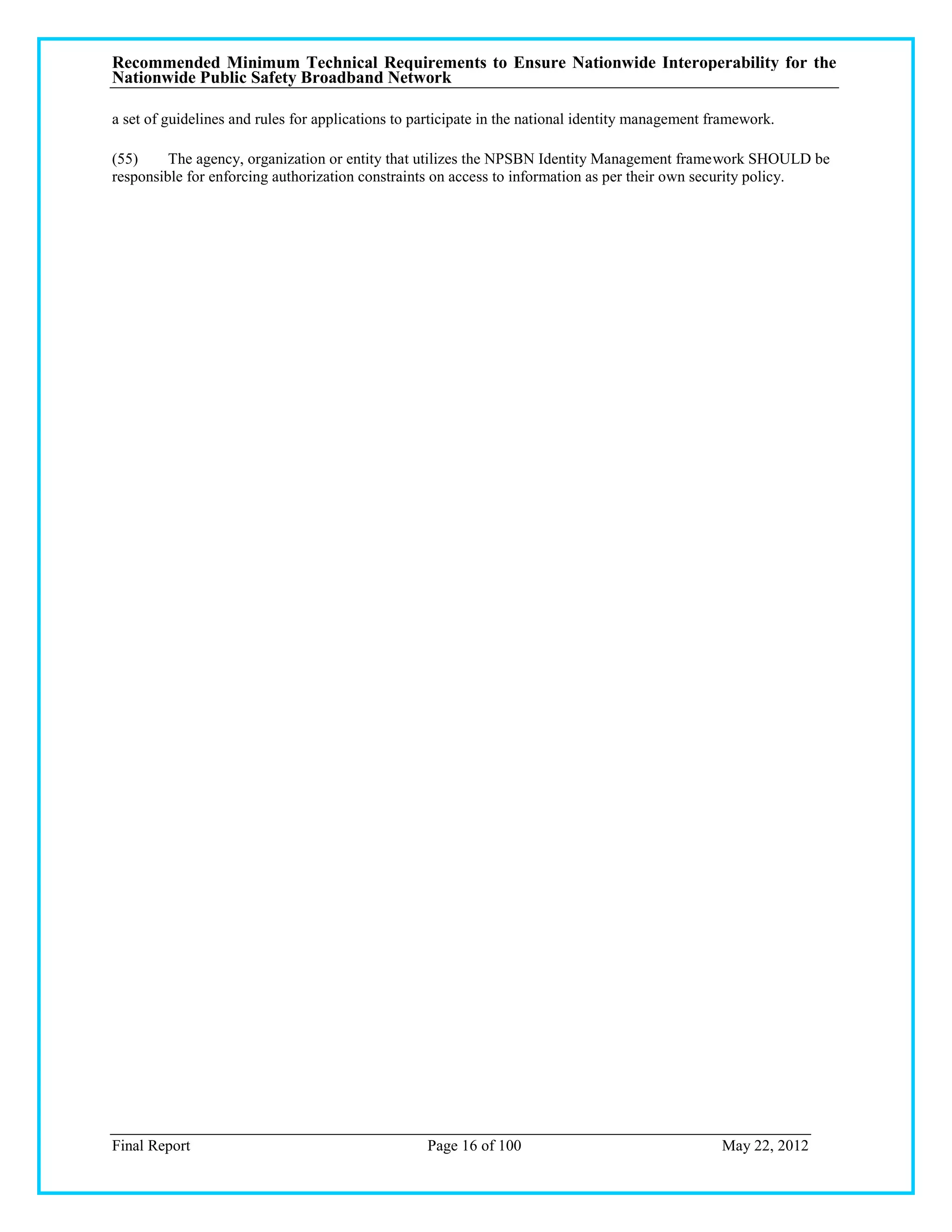
![Recommended Minimum Technical Requirements to Ensure Nationwide Interoperability for the
Nationwide Public Safety Broadband Network
2 Introduction
2.1 Statutory Framework for Deployment of a Nationwide Interoperable
Public Safety Broadband Network
The Spectrum Act established the First Responder Network Authority (―FirstNet‖) as ―an independent authority
within [the National Telecommunications and Information Administration (NTIA)]‖ 2 to ―ensure the establishment
of a nationwide, interoperable public safety broadband network.‖3 FirstNet is also the spectrum licensee for the re-
allocated D Block for public safety services and the existing public safety broadband spectrum, collectively referred
to as Band 14.4
Under the Spectrum Act, the FCC was responsible for selecting the membership of the Technical Advisory Board
for First Responder Interoperability (Interoperability Board),5 which was tasked to develop recommended
―minimum technical requirements for interoperability‖ 6 for the FCC to submit to the FirstNet (with possible
revisions). The Interoperability Board will ―terminate 15 days after the date on which the Commission transmits
the recommendations to the First Responder Network Authority‖. 7
FirstNet will then use the minimum technical requirements for interoperability to develop and issue RFPs for the
construction and operation of the NPSBN, ―without materially changing them.‖ FirstNet has been funded up to $7
Billion from incentive auctions to be deposited in a Network Construction Fund. To pay for operating expenses,
FirstNet is authorized to assess user fees and fees associated with leasing network capacity and infrastructure.
The Spectrum Act also provides a process by which a State may choose to ―Opt Out‖ of the planned FirstNet
deployment in its jurisdiction and operate its own radio access network. As a component of this process the FCC
will evaluate the State‘s alternative plan using the minimum technical requirements for interoperability as a
component of its evaluation. The FCC will determine whether the State‘s plan or the FirstNet plan will be used for
the construction and operation of the radio access network (RAN) network within the State. States that successfully
opt out must be interoperable with the NPSBN.
2.2 Technical Advisory Board for First Responder Interoperability
The Spectrum Act required that the FCC Chairman establish the Interoperability Board within 30 days of
2
Middle Class Tax Relief and Job Creation Act of 2012, Title VI (Public Safety Communications and
Electromagnetic Spectrum Auctions), Section 6204 (a).
3
Middle Class Tax Relief and Job Creation Act of 2012, Title VI (Public Safety Communications and
Electromagnetic Spectrum Auctions), Section 6202 (a).
4
Middle Class Tax Relief and Job Creation Act of 2012, Title VI (Public Safety Communications and
Electromagnetic Spectrum Auctions), Section 6201(a).
5
Middle Class Tax Relief and Job Creation Act of 2012, Title VI (Public Safety Communications and
Electromagnetic Spectrum Auctions), Section 6203 (Public Safety Interoperability Board), (a).
6
Middle Class Tax Relief and Job Creation Act of 2012, Title VI (Public Safety Communications and
Electromagnetic Spectrum Auctions), Section 6203 (Public Safety Interoperability Board), (c)(1).
7
Middle Class Tax Relief and Job Creation Act of 2012, Title VI (Public Safety Communications and
Electromagnetic Spectrum Auctions), Section 6203 (Public Safety Interoperability Board), (f).
Final Report Page 17 of 100 May 22, 2012](https://image.slidesharecdn.com/interopboardfinalreport052212-13388963580201-phpapp02-120605064116-phpapp02/75/FCC-Interop-Board-Final-Report-05-22-12-17-2048.jpg)
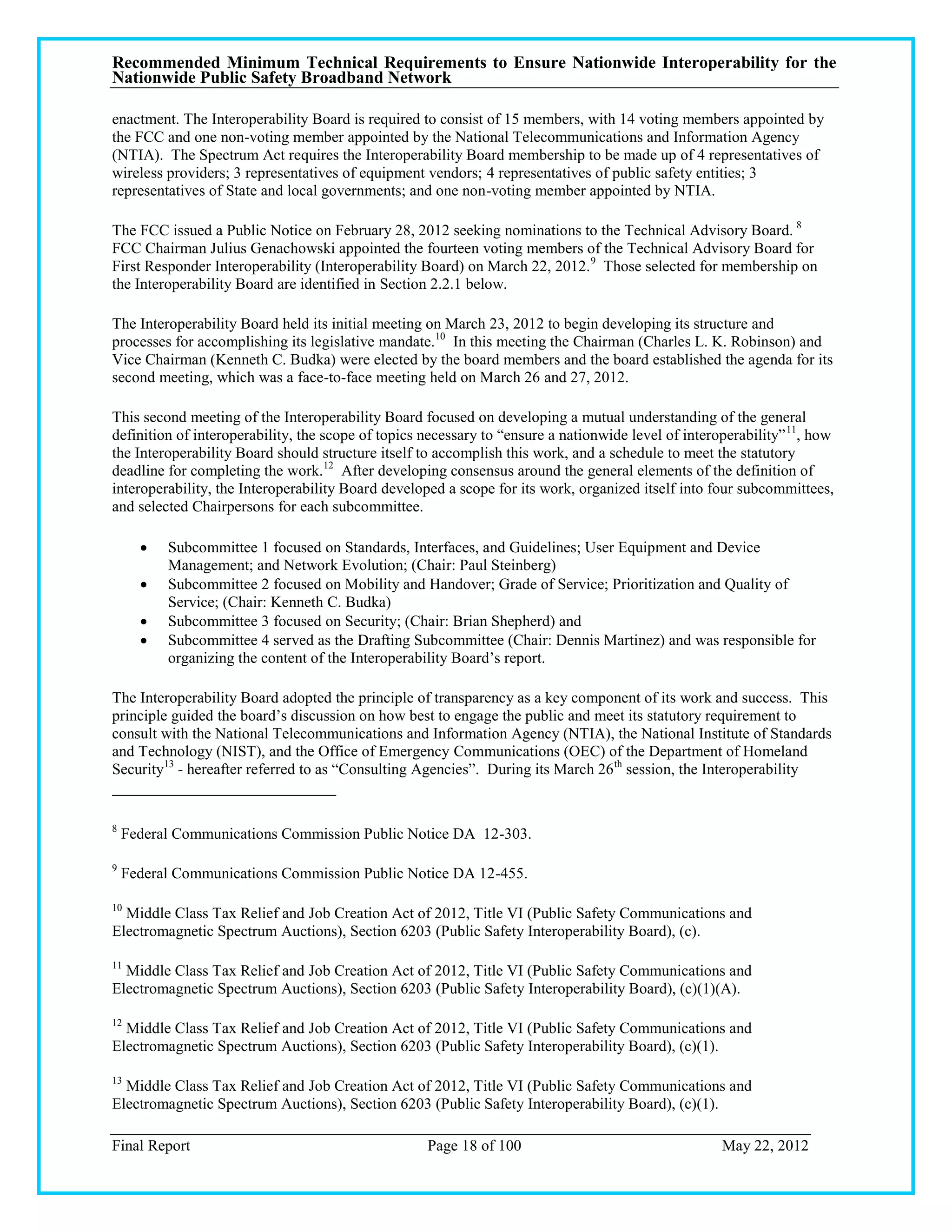

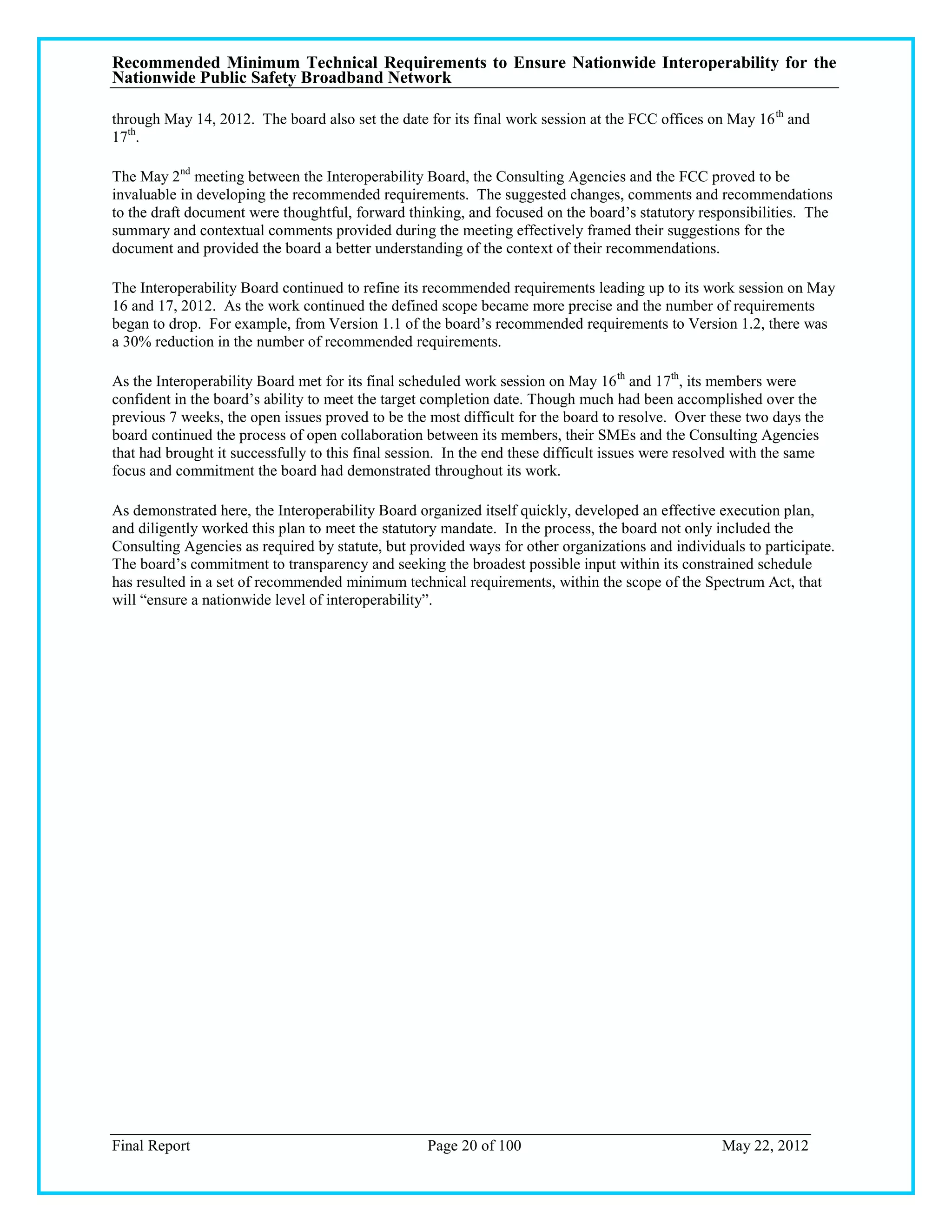
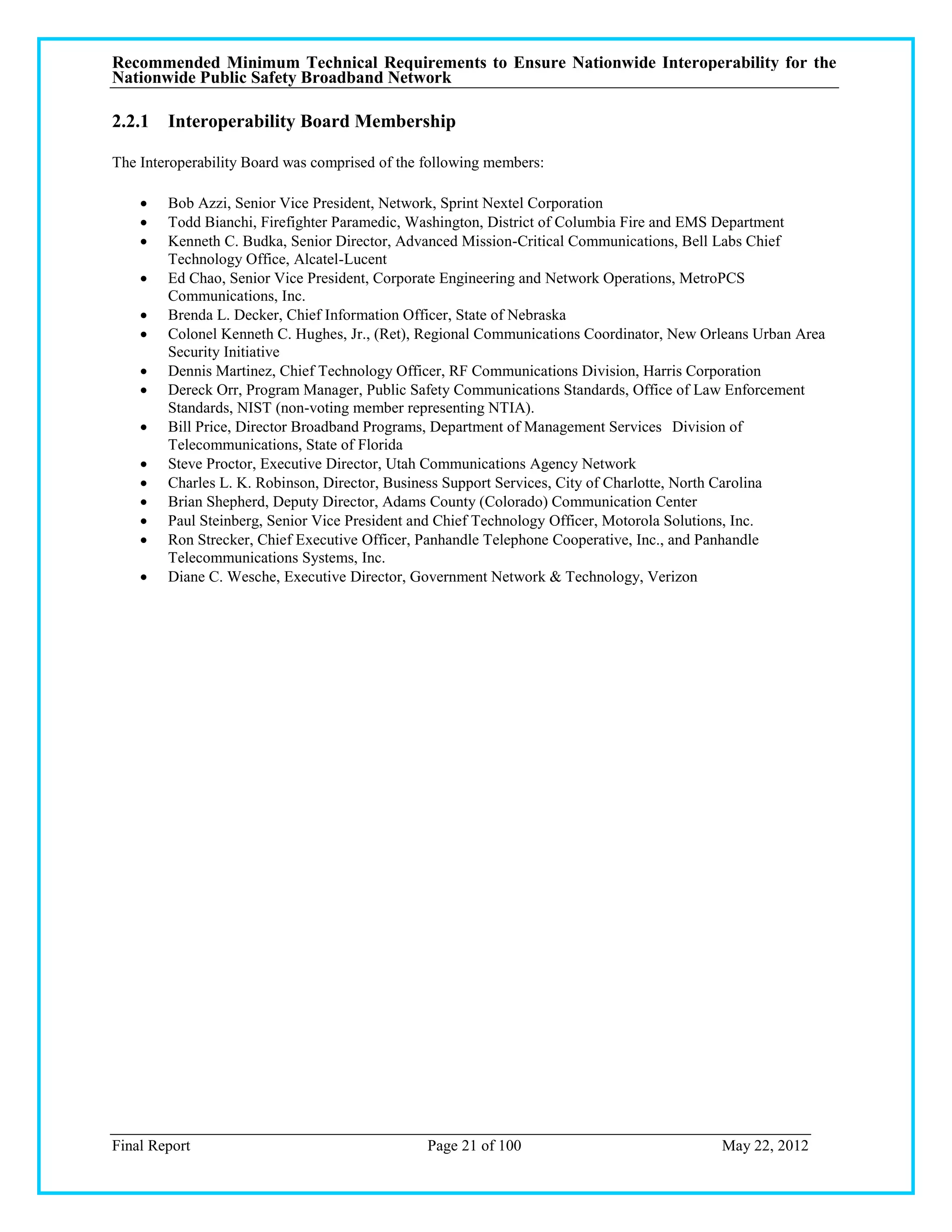
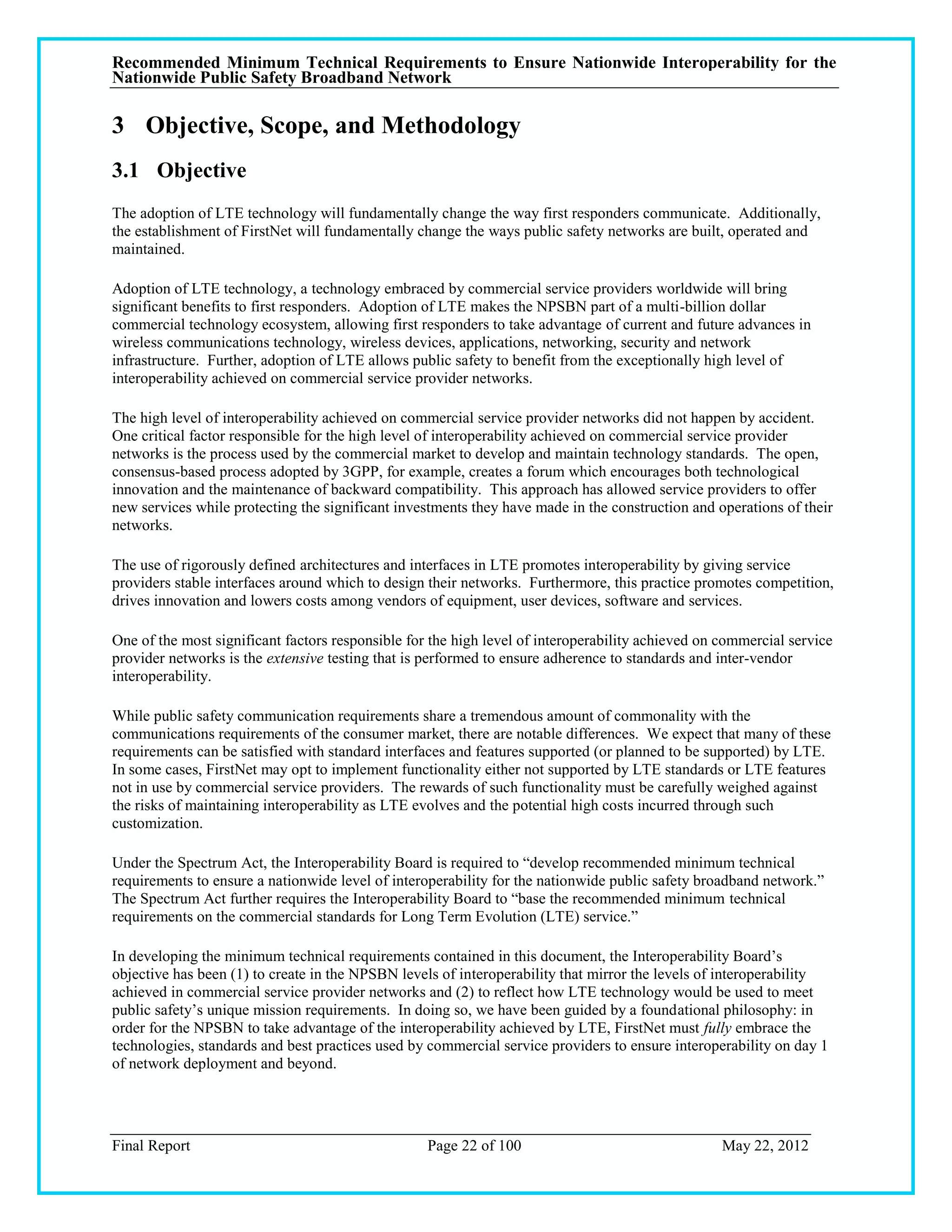
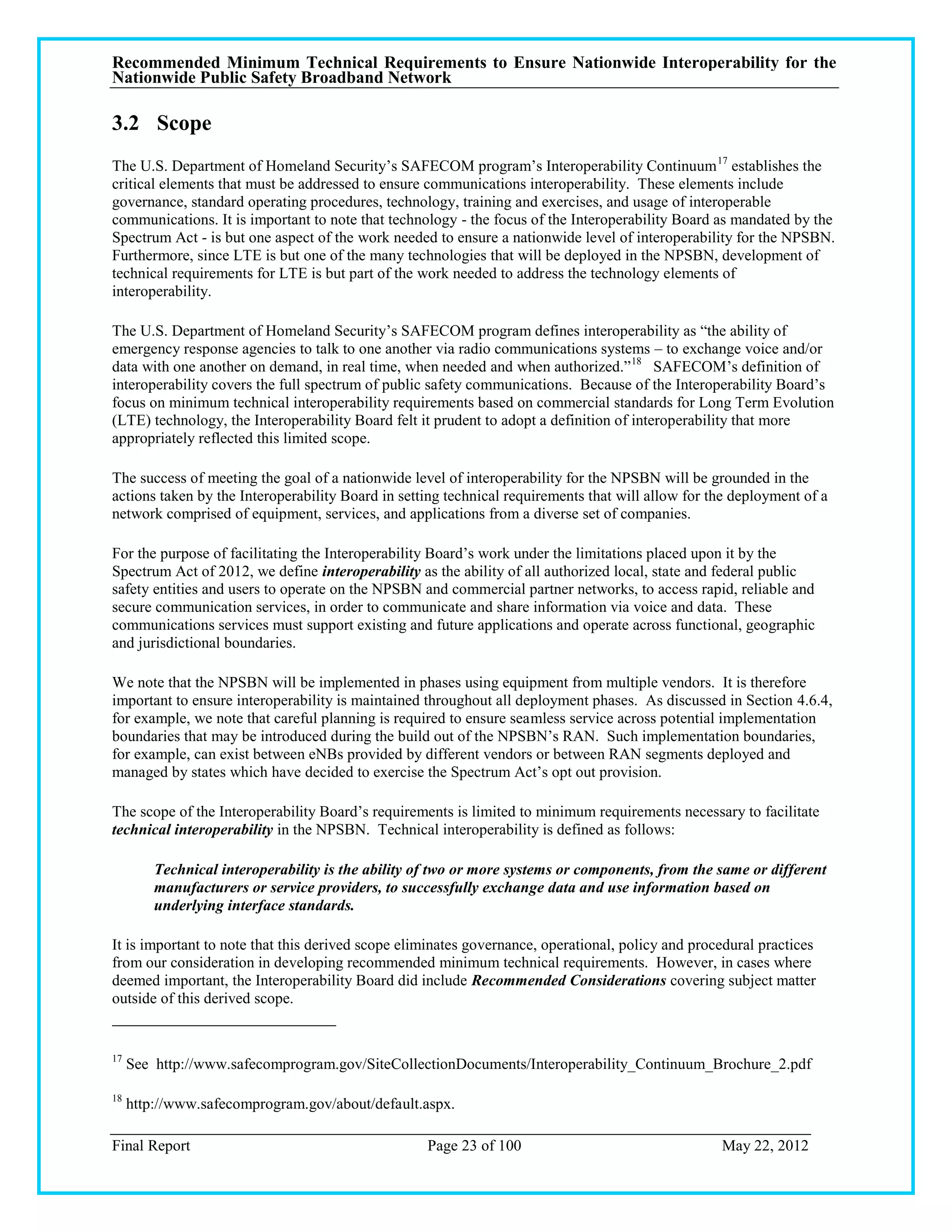
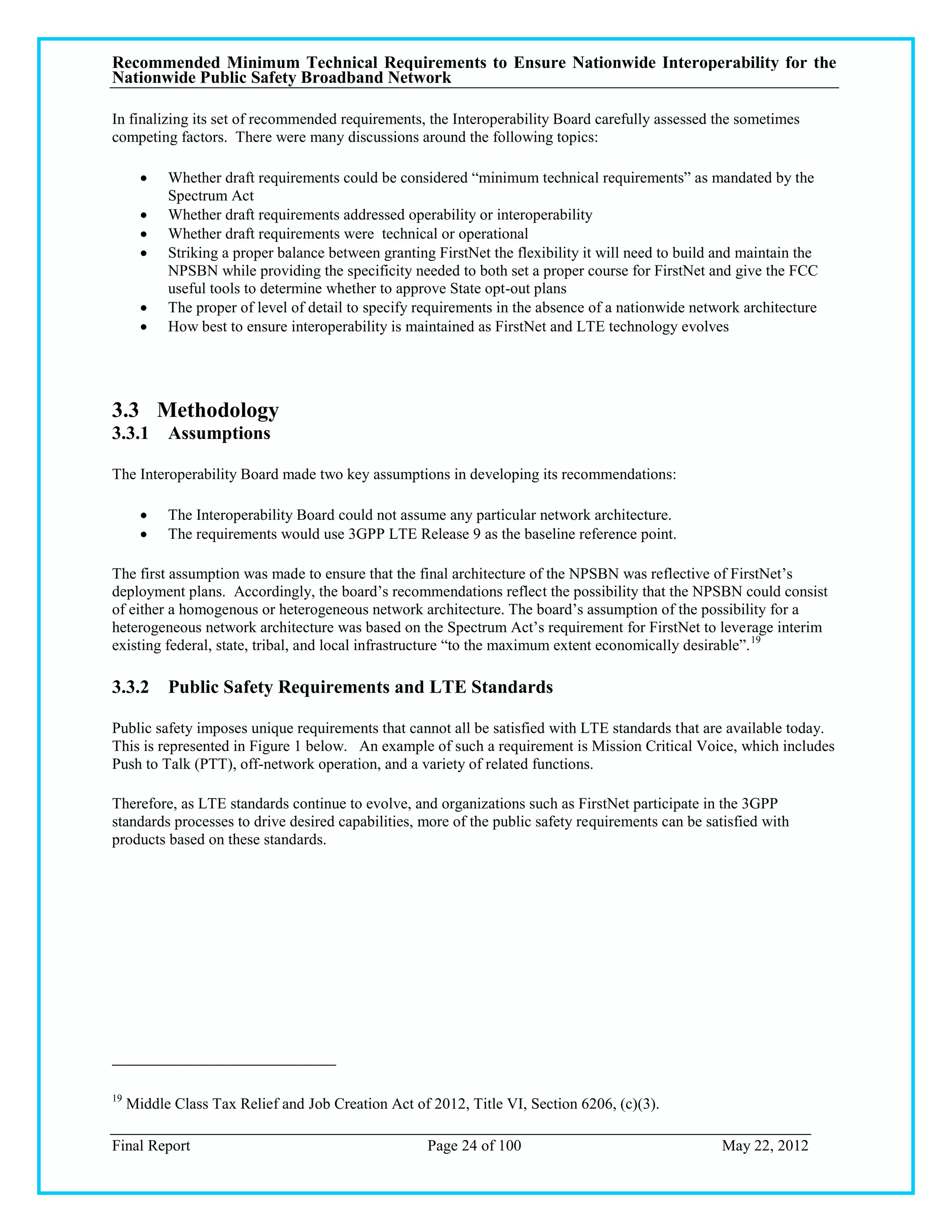
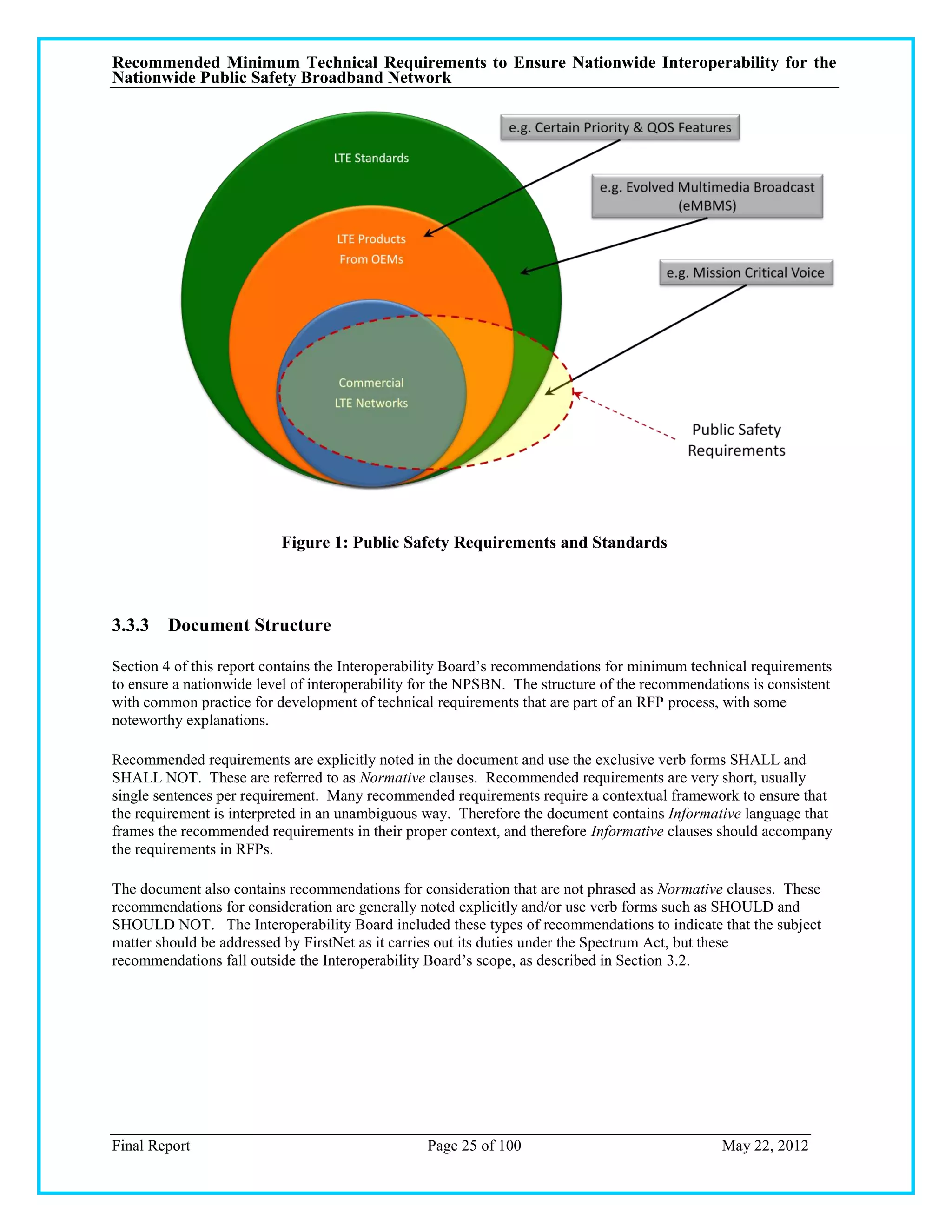

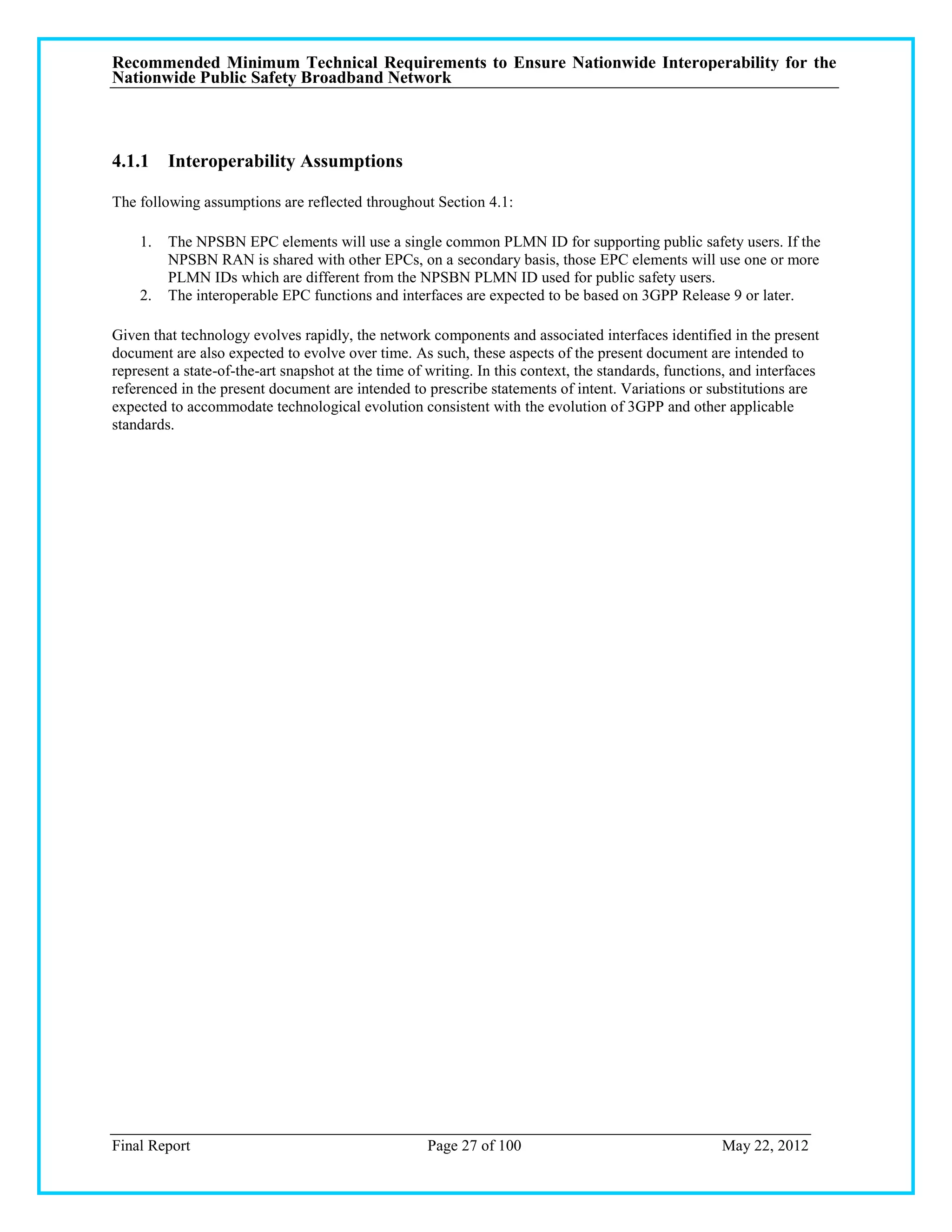
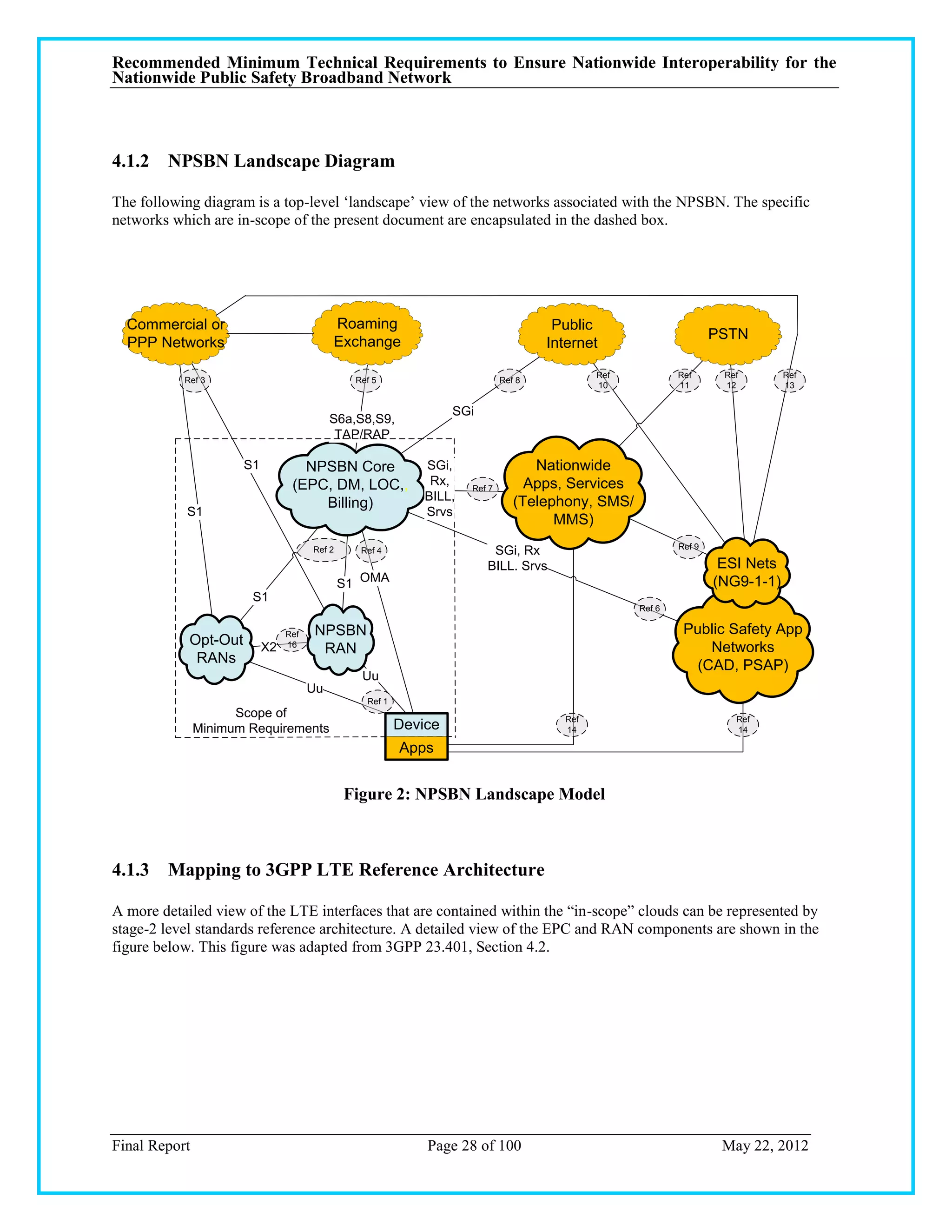
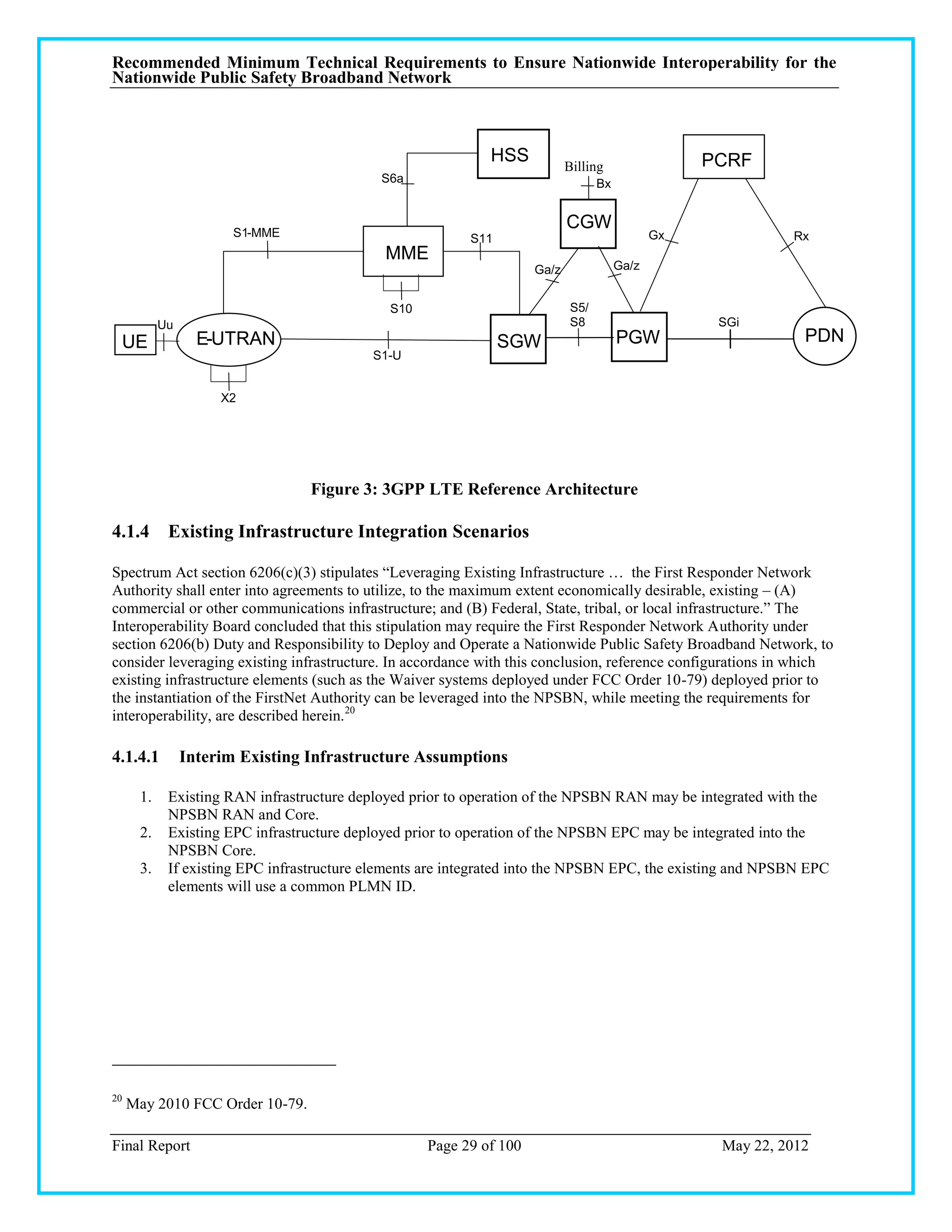
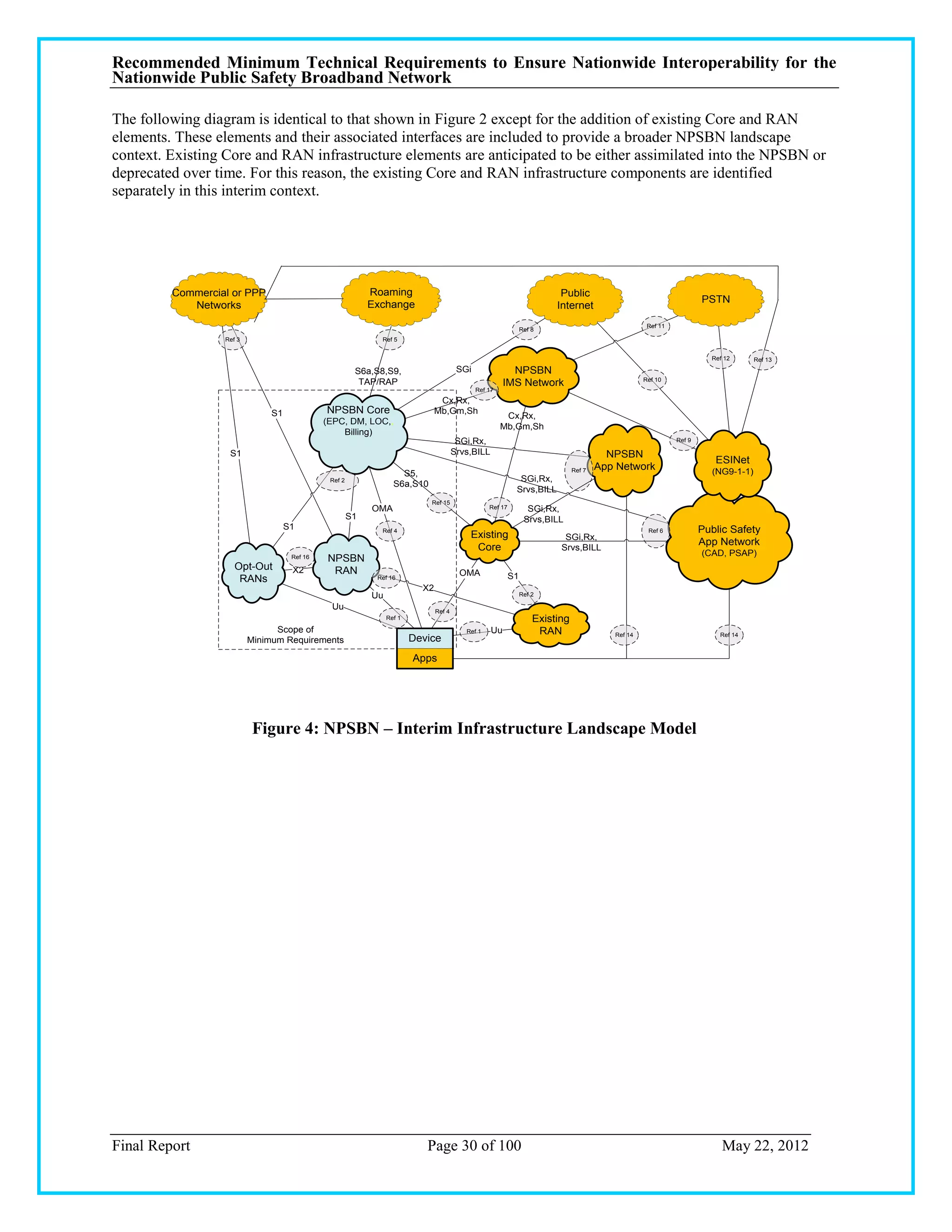
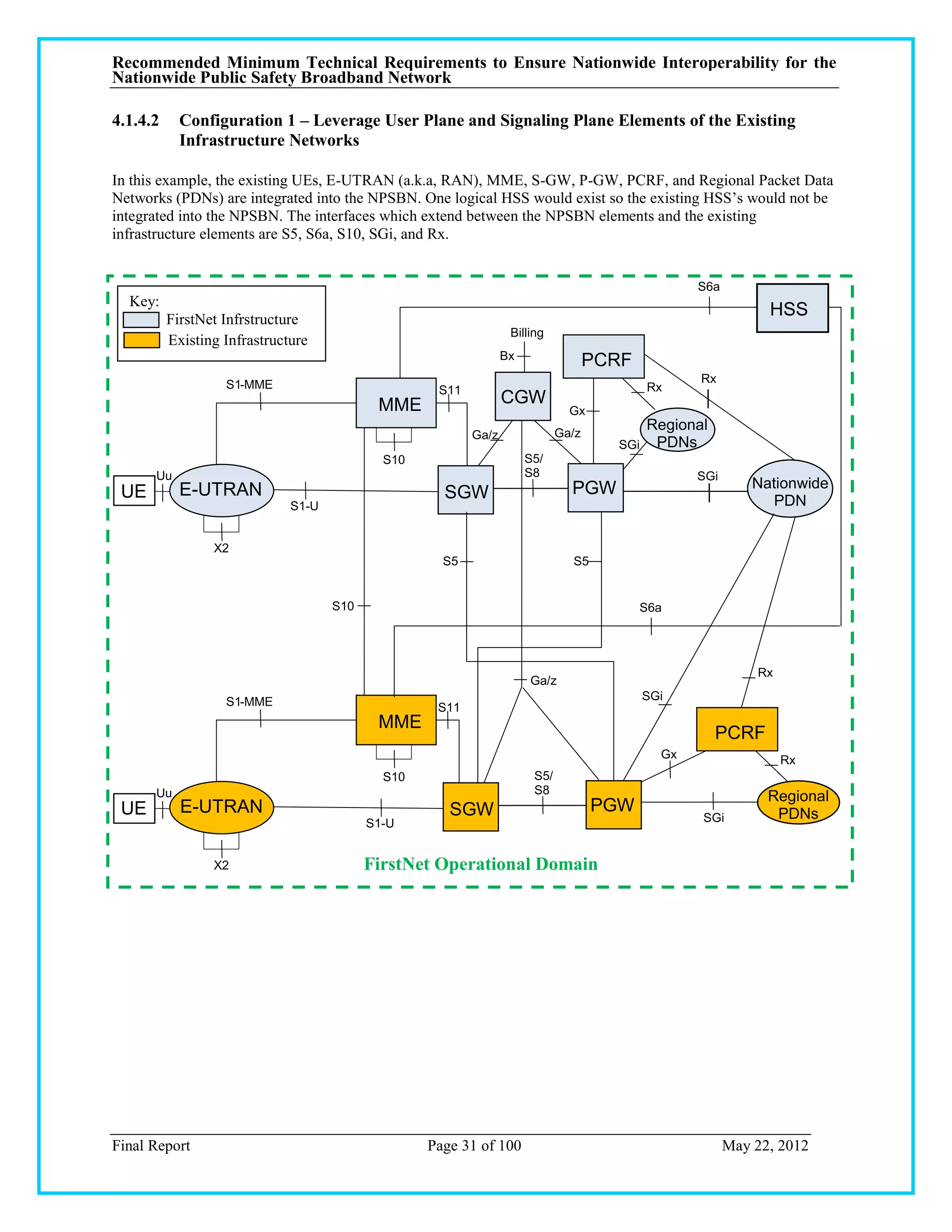

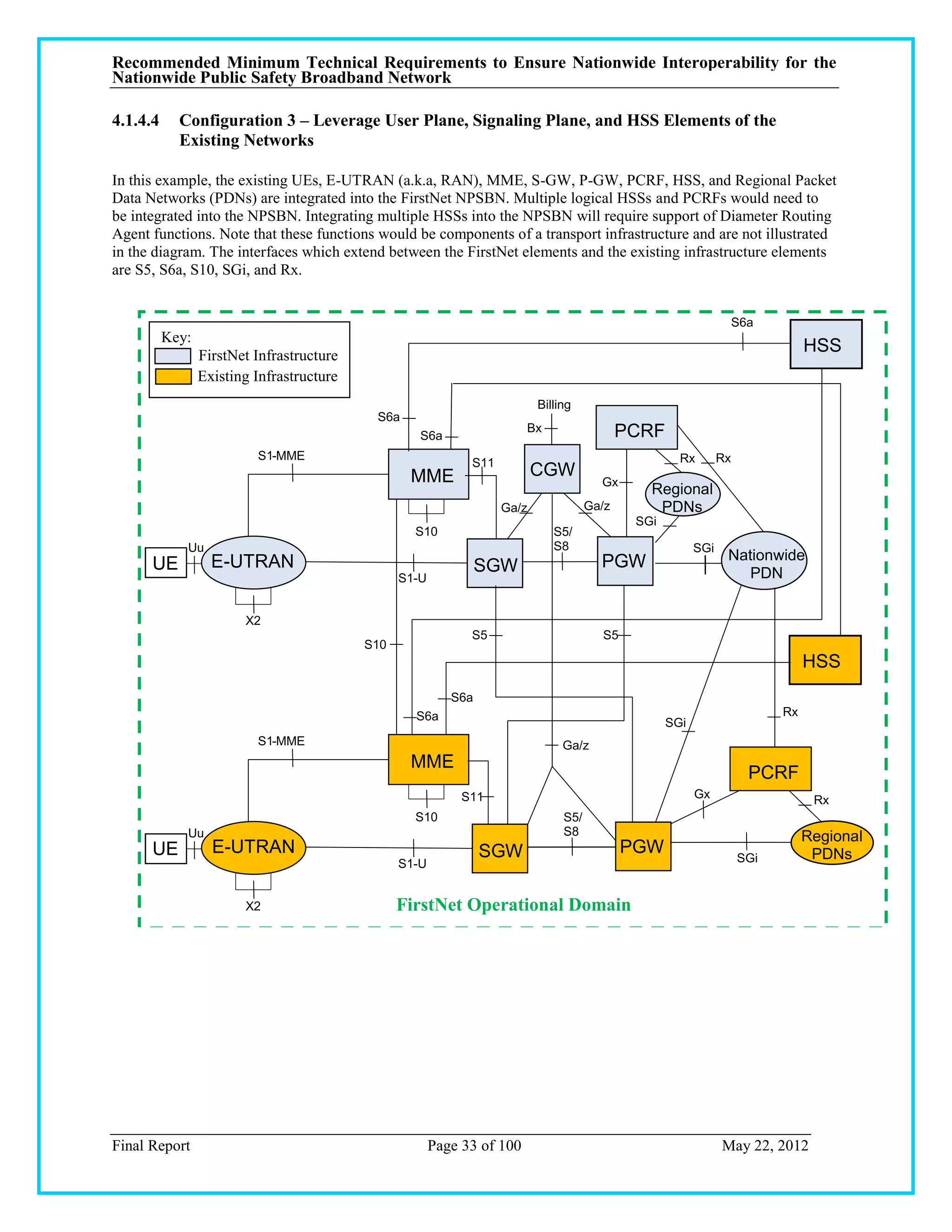
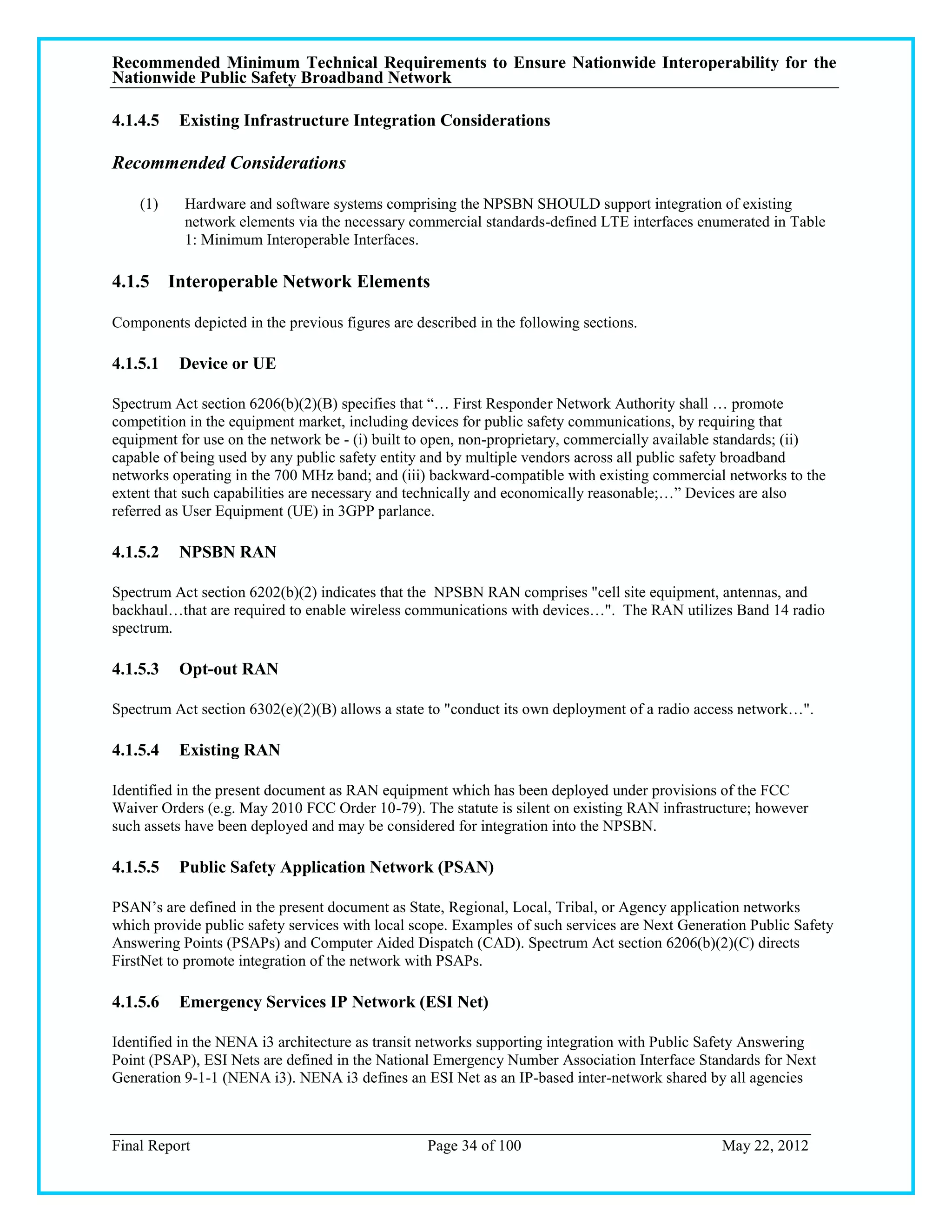
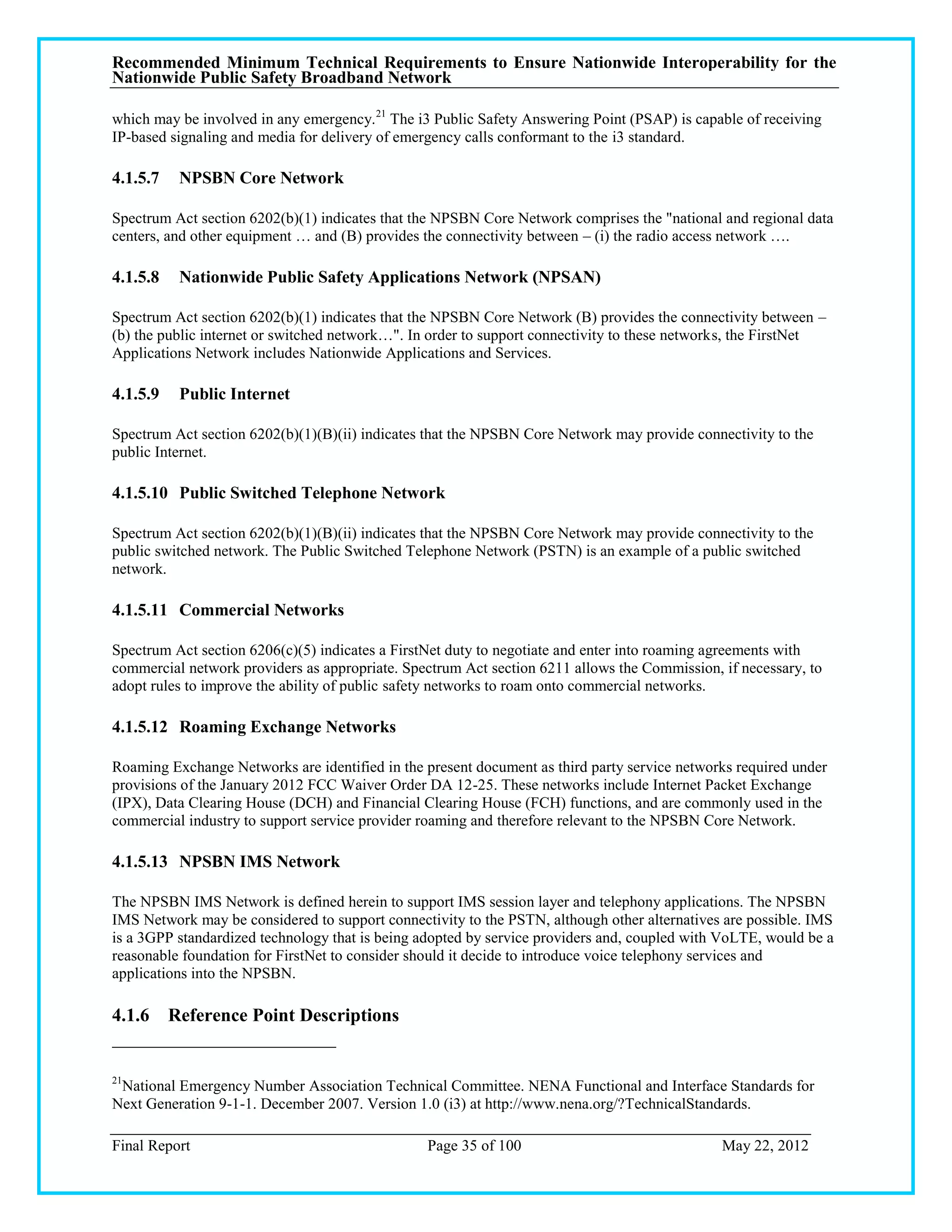
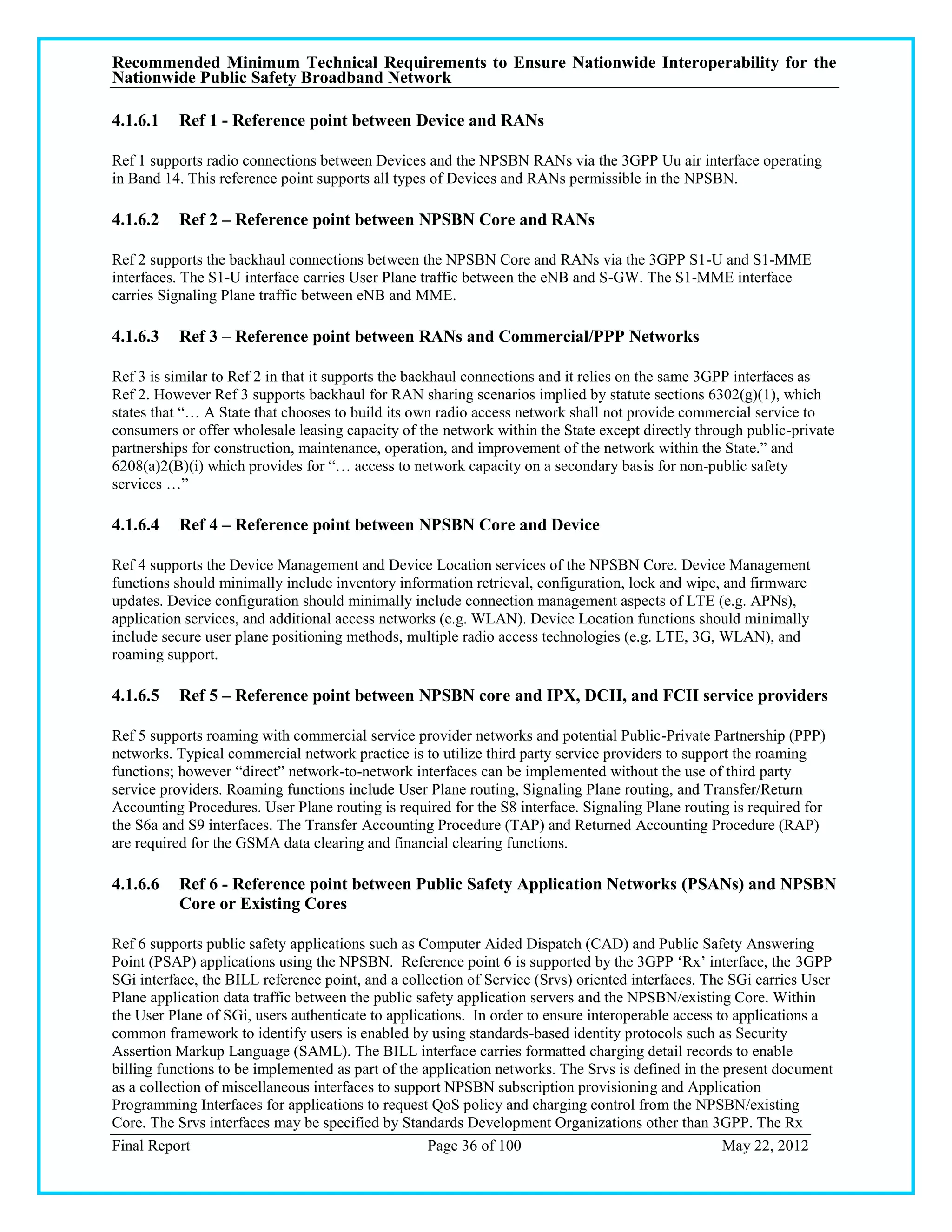
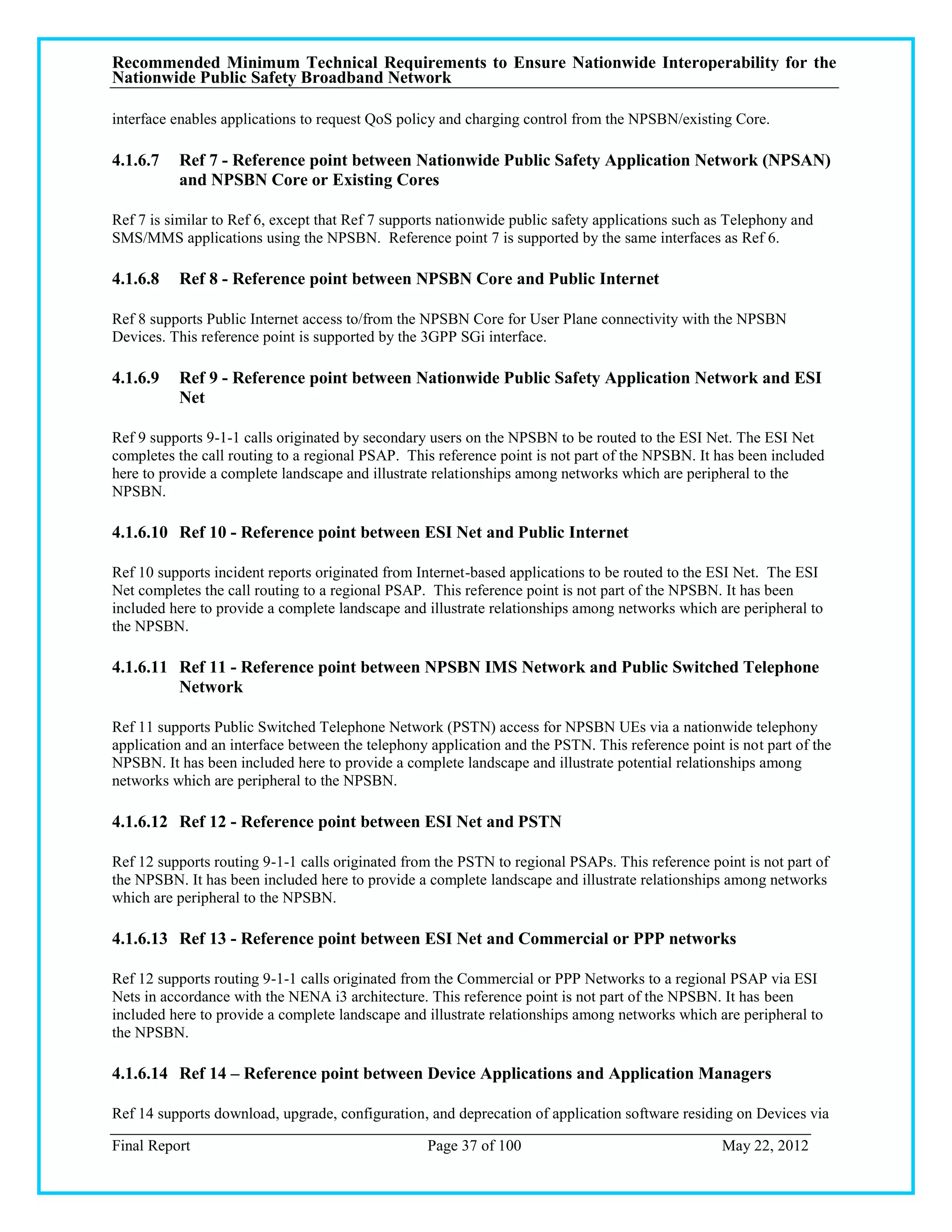
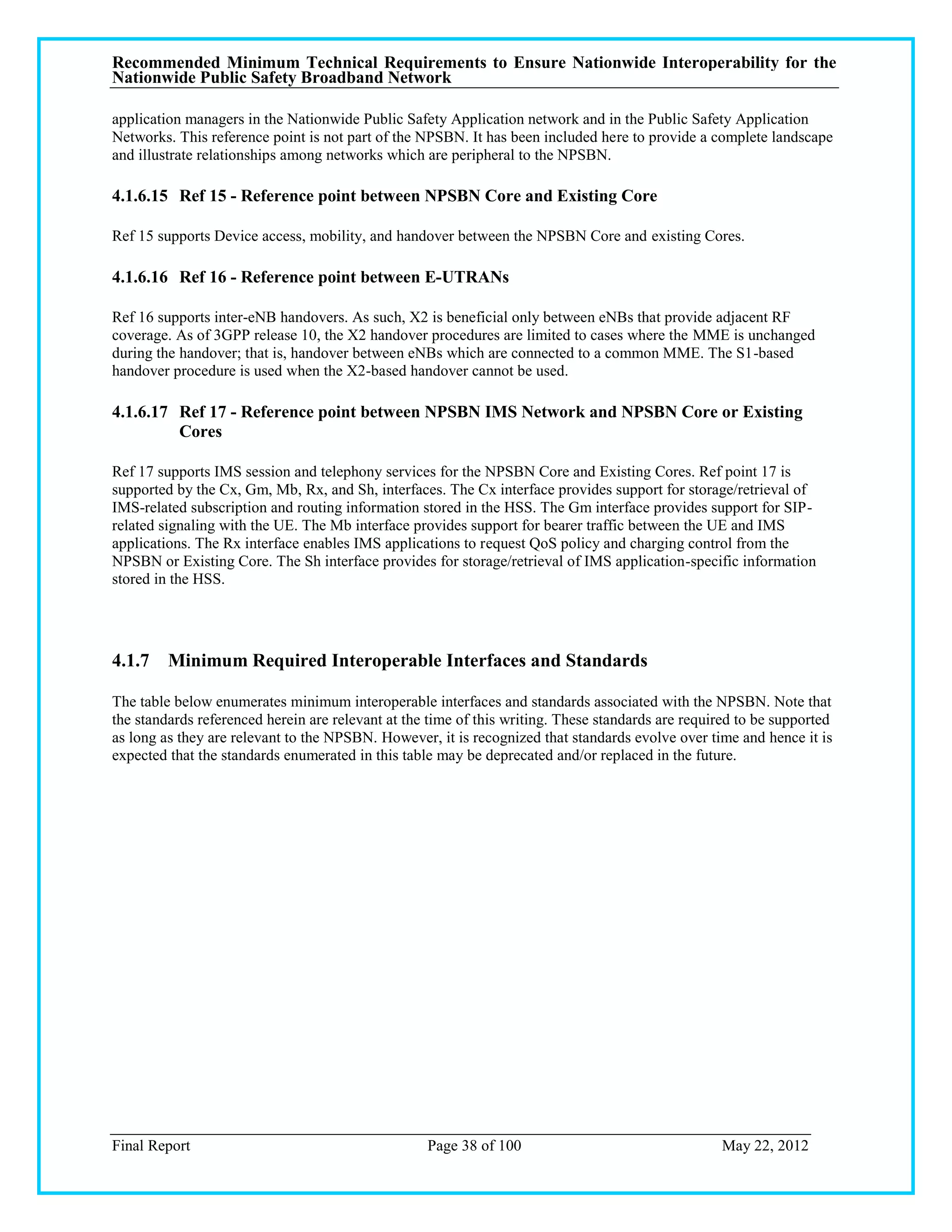
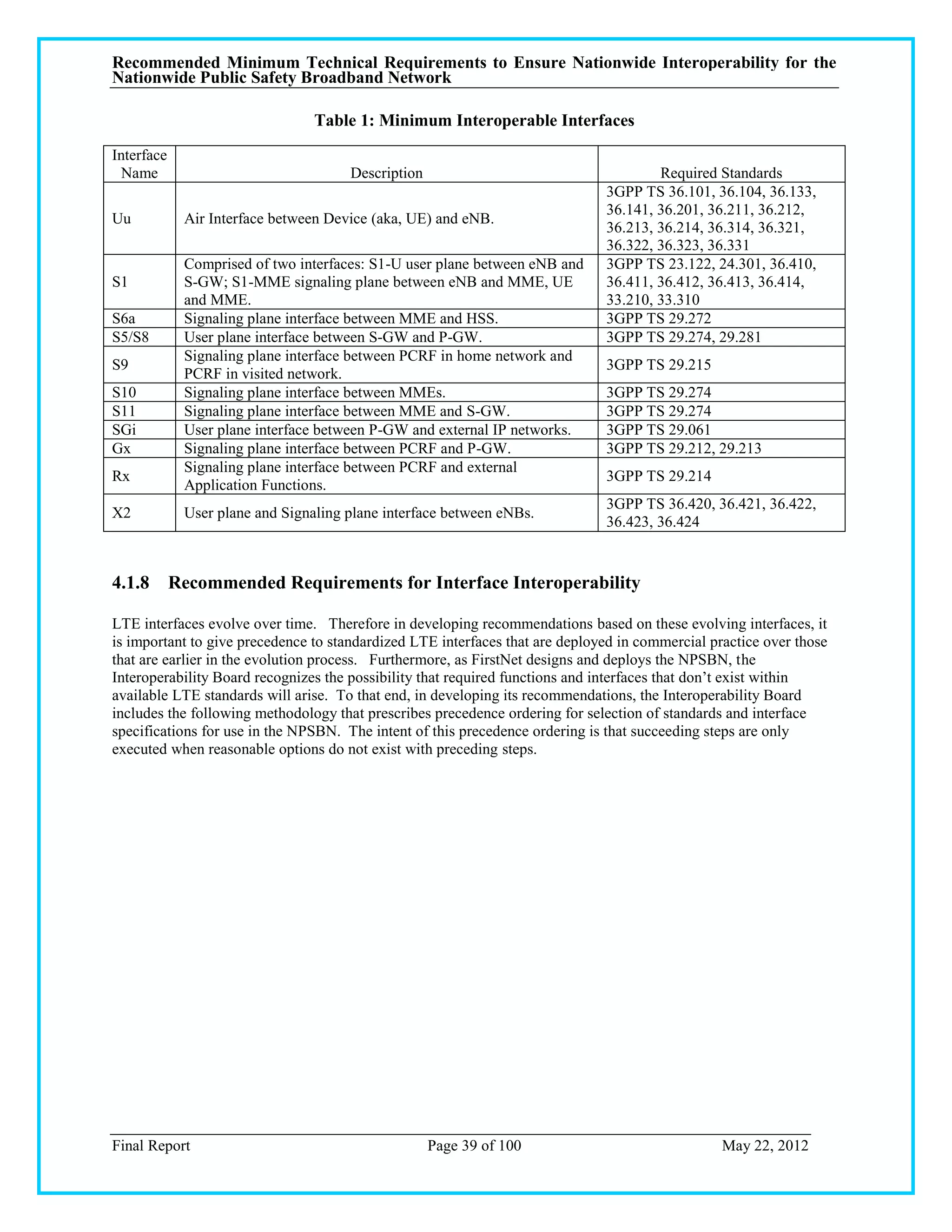
![Recommended Minimum Technical Requirements to Ensure Nationwide Interoperability for the
Nationwide Public Safety Broadband Network
Table 2: Standards Implementation Methodology
Step 1. Implementation based on open, consensus-based, non-proprietary, commercially
available standards, commonly used by commercial service providers
Step 2. Implementation based on open, consensus-based, non-proprietary, commercially
available standards established for use by commercial service providers
Step 3. Implementation based on the development and adoption of open, consensus-based,
non-proprietary, commercially available standards within recognized standards setting
organizations, through direct participation in these standards-setting activities by
FirstNet
Step 4. FirstNet may implement a solution based on open specifications available to all
authorized parties
[1] Hardware and software systems comprising the NPSBN SHALL implement interfaces consistent with
Table 2: Standards Implementation Methodology.
[2] Hardware and software systems comprising the NPSBN SHALL support the interfaces enumerated in
Table 1: Minimum Interoperable Interfaces.
[3] Hardware and software systems comprising the NPSBN SHALL support management functions.
[4] Hardware and software systems comprising the NPSBN SHALL support APNs defined for PSAN
usage.
[5] Hardware and software systems comprising the NPSBN SHALL support nationwide APNs for
interoperability.
[6] Hardware and software systems comprising the NPSBN SHALL enable QoS control for PSAN-hosted
applications via the 3GPP ‗Rx‘ interface.
[7] The NPSBN SHALL support IPv4, IPv6, and IPv4/v6 PDN types defined in 3GPP TS 23.401.
[8] The NPSBN SHALL support IPv4 and/or IPv6 transport for the EPS interfaces enumerated in Table 1:
Minimum Interoperable Interfaces, consistent with the FirstNet design.
[9] Any sharing agreement that FirstNet enters into SHALL implement network sharing according to 3GPP
TS 23.251 and SHALL NOT impact public safety operations.
4.1.9 NPSBN Services Offered to Applications
The NPSBN would benefit from implementing a set of common nationwide network services which can be
accessed by applications and used in a standard and interoperable manner. Examples of such services are Billing,
Short Message Service (SMS) messaging, Location, Presence, and Device Management. These services are
typically not directly visible to end-users, but rather made available to end-user applications or administrative-user
applications.
In the commercial service provider environment, these services are typically based on standards; however, each
network service provider tends to select unique standard options that best fits its needs. As a result, there are
multiple standards-based options to realize such services. For this reason, there are multiple ‗state-of-the-art‘
practices that could be leveraged by the NPSBN. This situation will require FirstNet to select specific standards-
based options to implement these services. After specific options are selected, these services can be deployed while
maintaining interoperability within the NPSBN context. While not universal among service providers at this
writing, IMS offers a useful standards framework for FirstNet to consider for implementation of these services.
Final Report Page 40 of 100 May 22, 2012](https://image.slidesharecdn.com/interopboardfinalreport052212-13388963580201-phpapp02-120605064116-phpapp02/75/FCC-Interop-Board-Final-Report-05-22-12-40-2048.jpg)
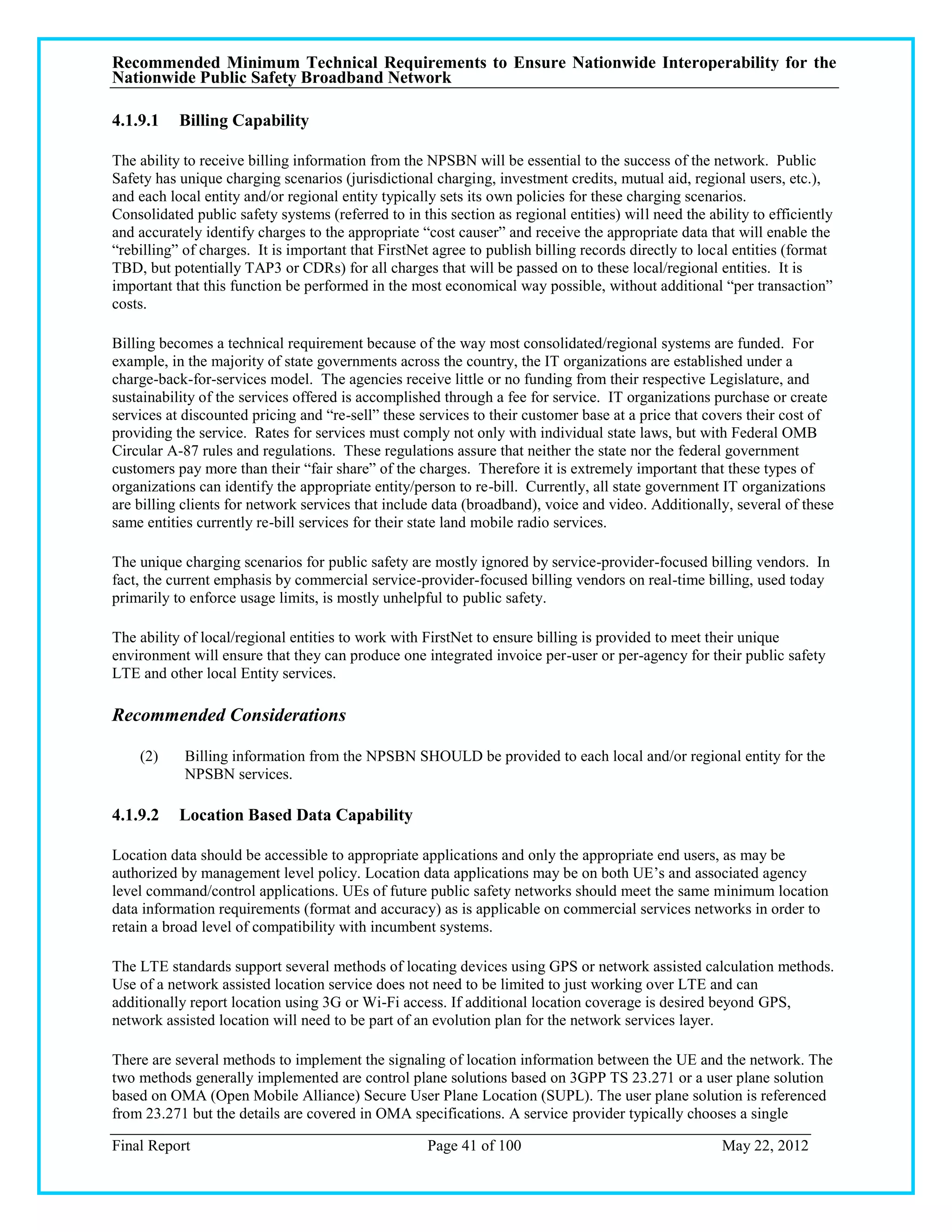
![Recommended Minimum Technical Requirements to Ensure Nationwide Interoperability for the
Nationwide Public Safety Broadband Network
method to deploy in their network.
Recommended Requirements
[10] The NPSBN SHALL include the capability to collect and convey UE location data to applications using
a standardized interface in near real time.
4.1.10 Network Applications
4.1.10.1 Recommended Minimum Requirements
A number of the applications specified by the National Public Safety Telecommunications Council (NPSTC)
Broadband Task Force indicated below can be supported with best-effort IP data access – a service that will be
available on all initial and subsequent LTE network deployments. In the commercial world, such applications are
known as ―Over the Top Applications‖, referring to their ability to run on top of a best-effort IP data service without
requiring additional integration effort at the network transport layers. Data applications currently used by public
safety agencies that run over commercial service provider networks, for example, operate as ―Over the Top
Applications.‖ These applications can be readily migrated to the public safety wireless broadband network,
leveraging existing applications, procedures, processes and expertise. All Over the Top Applications can be further
enhanced through the use of priority services, services that require the exchange of signaling messages between the
LTE network and application to allow the application to request a specific priority treatment. The use of Over the
Top applications will have an impact on network capacity requirements and perhaps other aspects of the LTE
network as it evolves. LTE is further anticipated to greatly increase mobile video usage within the public safety
workflow. Enhanced support for this and other applications through the introduction of QoS, priority services or
other supplemental security services that are required by public safety must be considered as part of the network
evolution plan.
Recommended Considerations
(3) The NPSBN SHOULD support existing Public Safety applications, deployed regionally or within
agencies.
4.1.10.1.1 Internet Access
The NPSTC Broadband Task Force report recommends that support of internet access be required on all LTE
networks deployed. This access can come directly or via access to a home network with internet connectivity.
Many of the home network services are only available on the agency private network and would better be served
with private connectivity to the agency. Private connectivity allows for priority/QoS to be applied. Connectivity
through the internet normally implies best effort only.
Recommended Requirements
[11] The NPSBN SHALL be capable of providing public safety subscribers with access to the global
Internet.
4.1.10.1.2 Information “Home page”
The NPSBN may be required to provide public safety a universal method to obtain a "home page" for visitors to the
system. This "home page" will facilitate access to and distribution of available applications, alerts, incident specific
information, system status information, and information that the service provider deems important to share with
visitors to the system.
Final Report Page 42 of 100 May 22, 2012](https://image.slidesharecdn.com/interopboardfinalreport052212-13388963580201-phpapp02-120605064116-phpapp02/75/FCC-Interop-Board-Final-Report-05-22-12-42-2048.jpg)
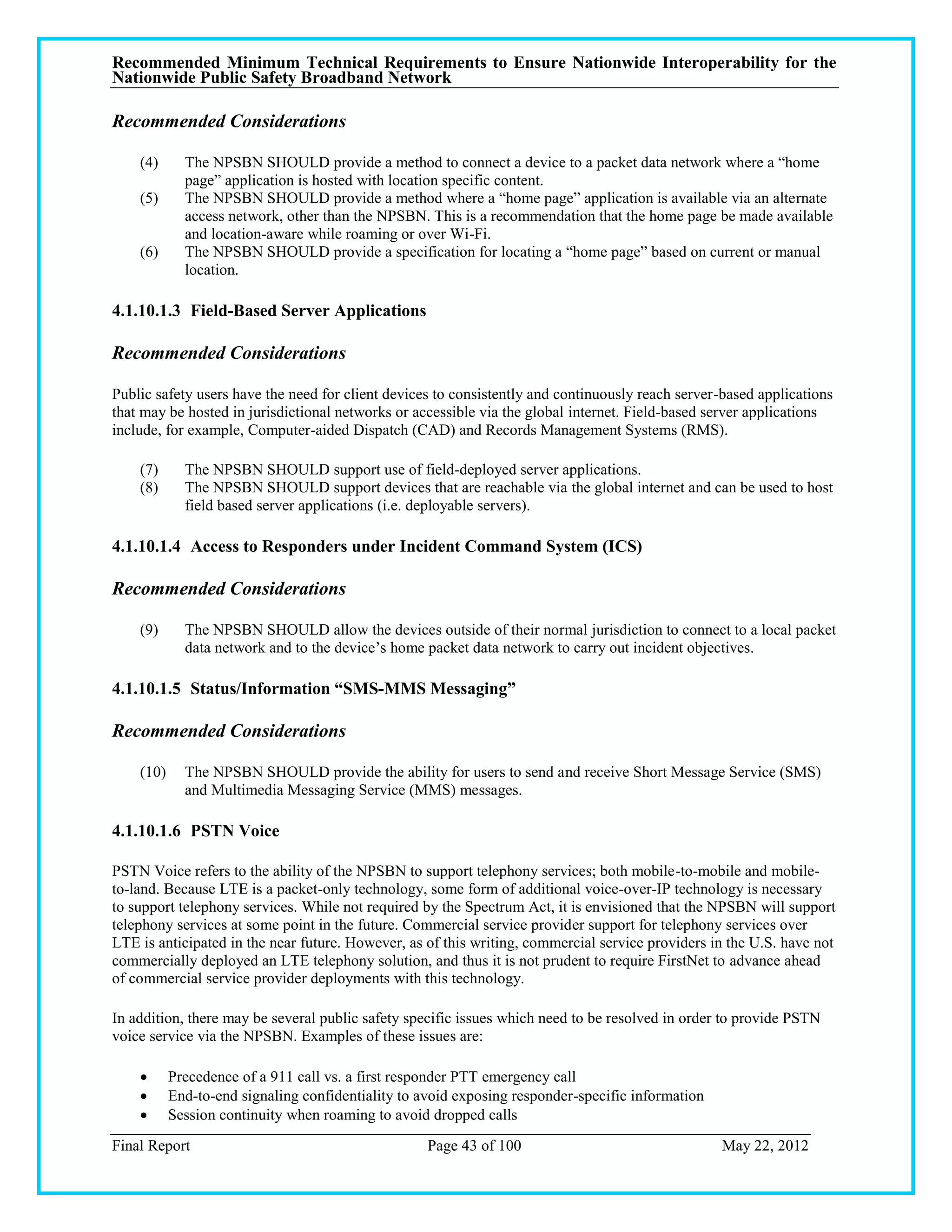
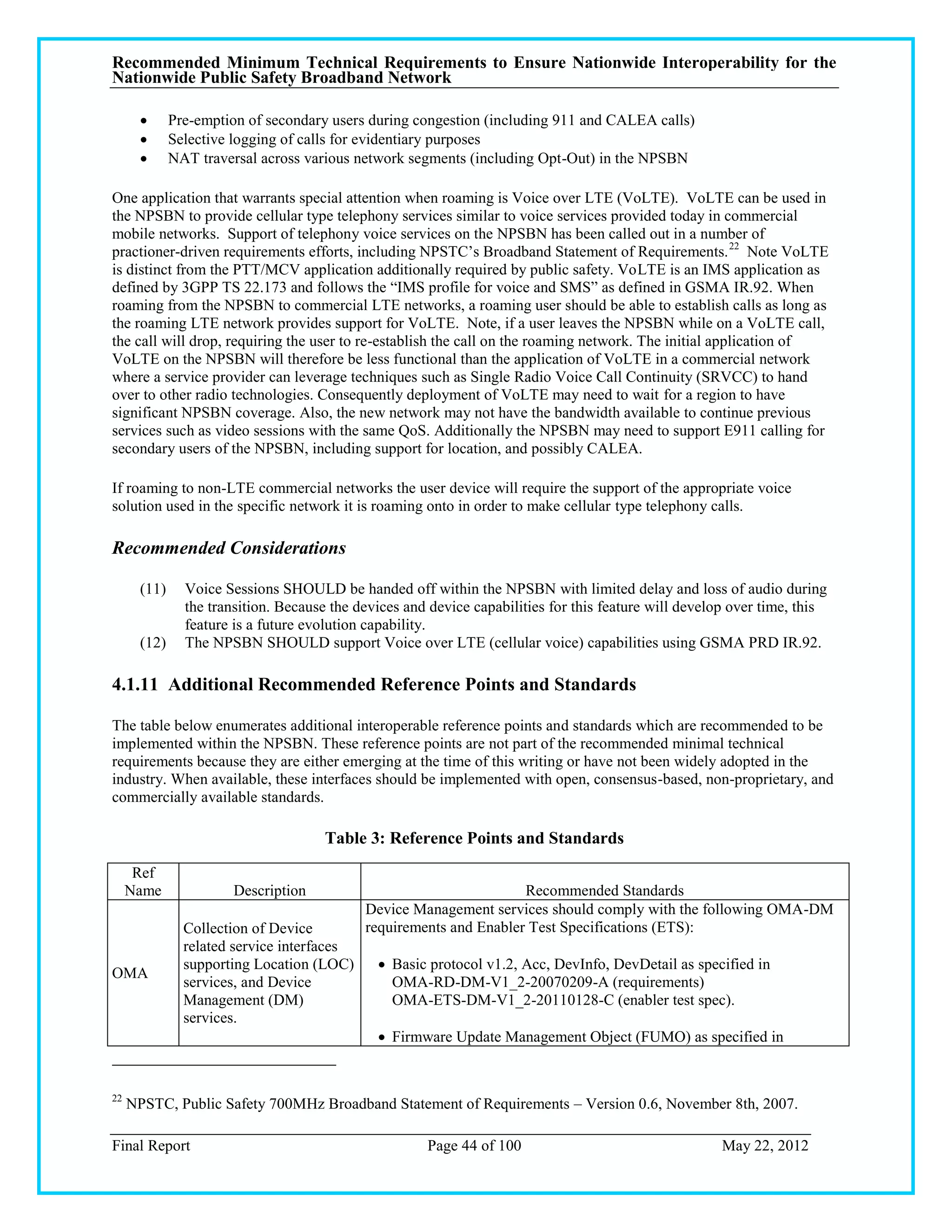
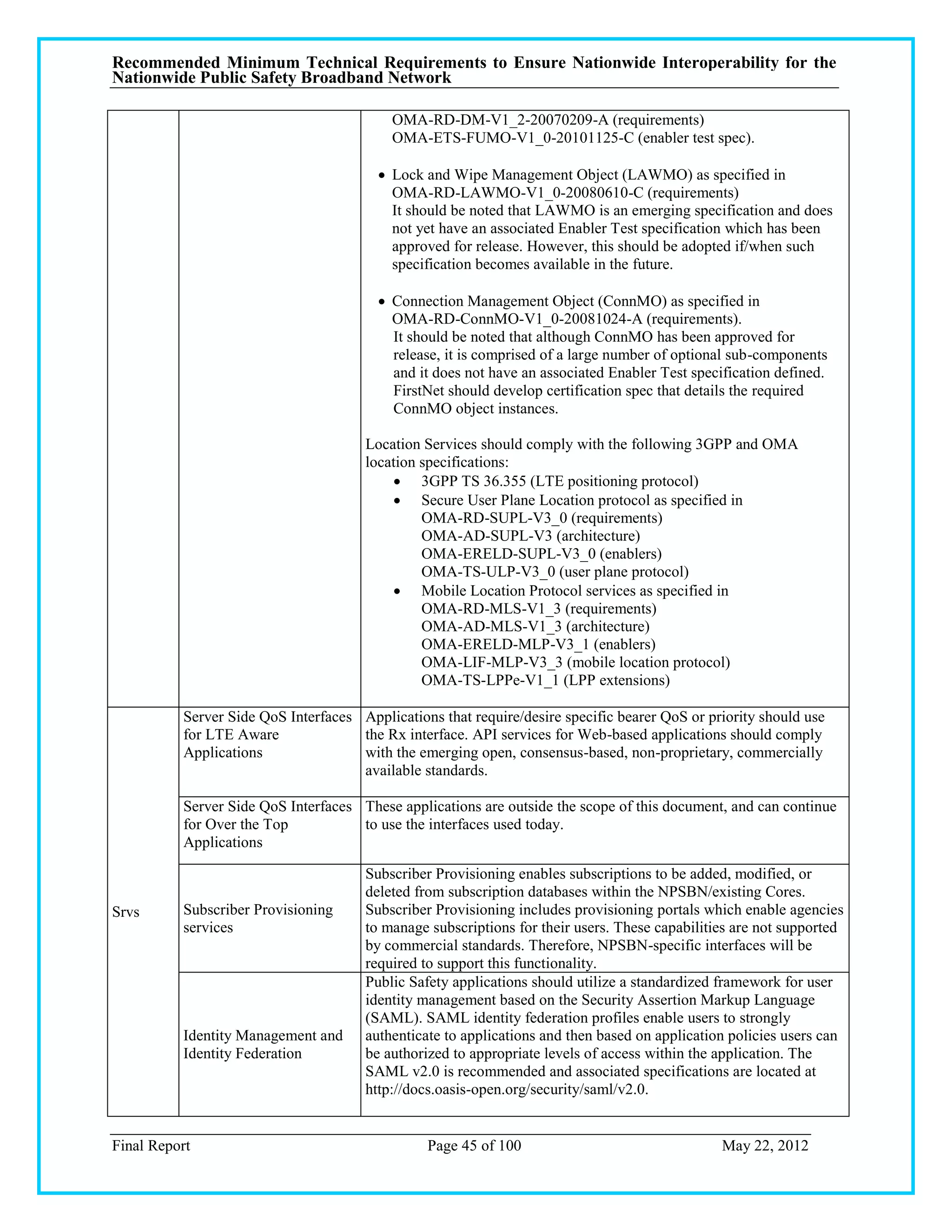
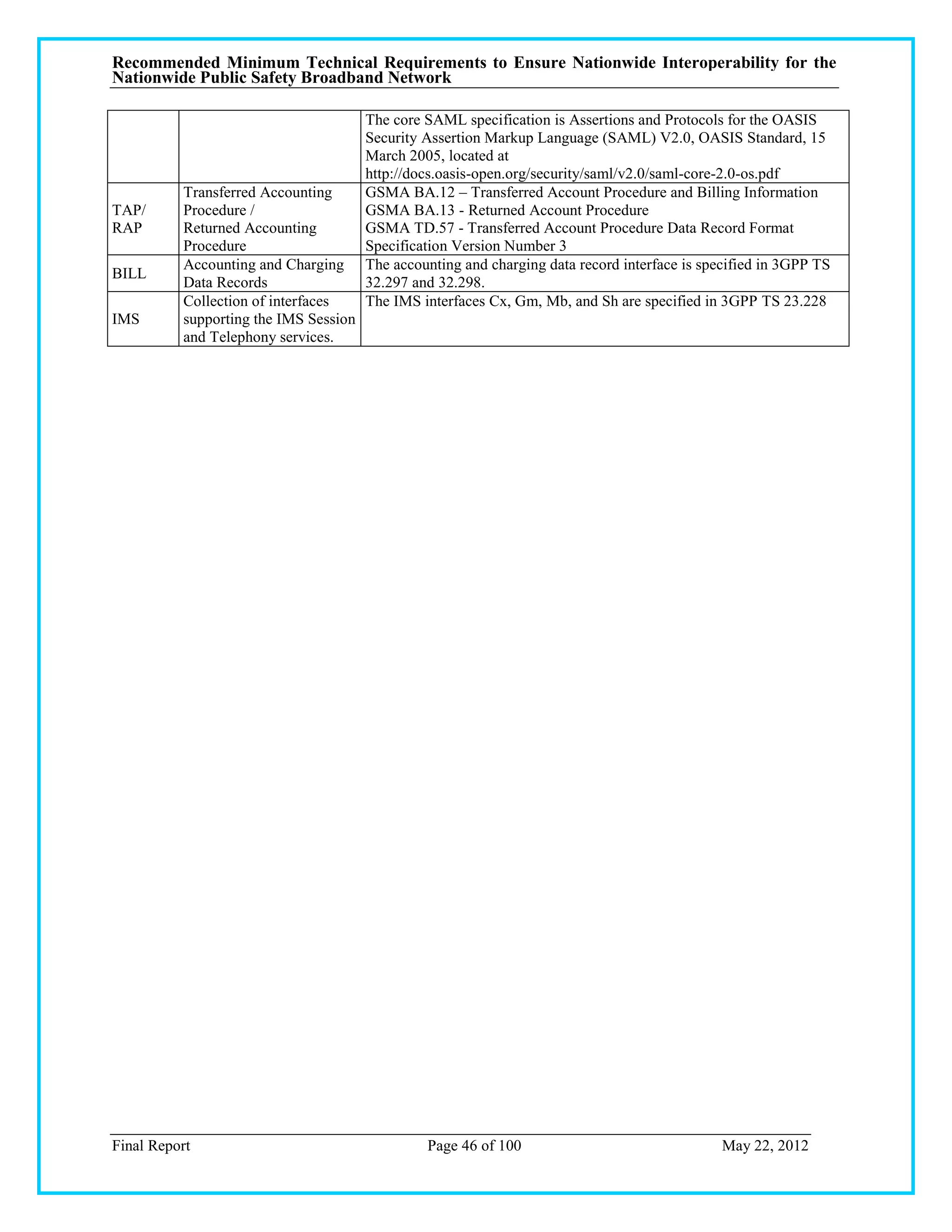
![Recommended Minimum Technical Requirements to Ensure Nationwide Interoperability for the
Nationwide Public Safety Broadband Network
4.2 User Equipment and Device Management
Interoperability in the areas of user equipment and device management is important to the success of the NPSBN.
The ability to use devices across the different types of broadband networks (e.g. NPSBN and Commercial Roaming
Partner networks) is critical for ubiquitous first responder broadband capabilities. The ability to procure mobile
broadband devices from a variety of sources will yield significant cost, functional, and performance benefits. The
ability to remotely manage devices over-the-air will simplify operations related to devices.
4.2.1 User Equipment
4.2.1.1 Standards
3GPP provides extensive standards relevant for LTE devices and necessary for interoperability over reference point
1 (see Section 4.1.6.1).
Recommended Requirements
[12] All User Devices (UEs) deployed on the NPSBN SHALL conform to the 3GPP Release 9 Uu interface
enumerated in Table 1: Minimum Interoperable Interfaces.
[13] All User Devices (UEs) deployed on the NPSBN SHALL conform to the 3GPP TS 36.306 UE Radio
Access Capabilities, Release 9.
4.2.1.2 USIM/UICC
In the network architecture of 3GPP, user equipment devices, or user equipment (UE), consist of at least two
physically separate elements. The first element is a physically secure element—an Integrated Circuit card, or smart
card, called the Universal Integrated Circuit Card (UICC)—that hosts authentication applications, such as the
Universal Subscriber Identity Module (USIM), used for accessing services provided by the mobile network. The
second element is Mobile Equipment (ME), which includes the radio interface and other mobile network access
functions.
FirstNet should leverage existing UICC IOT standards as described by 3GPP PCS Type Certification Review Board
(PTCRB) and add specific test cases to enable any specific baseline standardization for the USIM/USAT
applications that run on any UICC that will be installed in a public safety device. This will enable public safety
entities to source their own UICC (SIM cards) independently and thus will avoid the creation of single source
(monopoly) and any perceived bottlenecks for UICC availability. Such a process will also allow the market forces
to drive the cost of UICC while making sure that UICC elements have been completely tested to work in
commercial service provider networks and the NPSBN.
Recommended Requirements
[14] All User Devices (UEs) SHALL support interworking of the device with the USIM/USAT applications
on the UICC in accordance with the relevant 3GPP 31.101, 31.102, and 31.111 standards.
4.2.1.3 Roaming
FirstNet subscribers should be able to obtain service on commercial LTE and 2G/3G networks. FirstNet should
establish interoperability requirements related to band class support and network selection for selected classes of
UEs. For example, FirstNet might specify handheld User Devices should support Public Safety LTE, one or more
Commercial LTE band, and either 3GPP or 3GPP2 bands. These requirements should be verified during Device
Certification as defined in Section 4.3.2.
FirstNet should ensure that its devices enable FirstNet to enter roaming agreements and public-private partnership
Final Report Page 47 of 100 May 22, 2012](https://image.slidesharecdn.com/interopboardfinalreport052212-13388963580201-phpapp02-120605064116-phpapp02/75/FCC-Interop-Board-Final-Report-05-22-12-47-2048.jpg)
![Recommended Minimum Technical Requirements to Ensure Nationwide Interoperability for the
Nationwide Public Safety Broadband Network
arrangements with any commercial service provider and allow FirstNet users to obtain service in those commercial
networks. A device that is capable of obtaining such service in certain bands shall operate on all FirstNet roaming
partner networks operating in those bands and not be locked to a subset of FirstNet roaming partner networks
operating in those bands.
Recommended Requirements
[15] All User Devices (UEs) deployed on the NPSBN that support roaming onto commercial LTE networks
SHALL operate on any FirstNet roaming partner network using bands supported by the device.
4.2.1.4 Public Safety Specific Device Performance
Section 4.6 outlines the Grade of Service required for public safety, including coverage areas for the NPSBN. In
order to meet the necessary grade of service, public safety entities may require devices with higher than typical
transmit power (e.g. vehicular modems) to expand coverage and minimize the required number of eNBs. This can
also have an impact on Grade of Service for low power UEs.
The need to support a mixture of high and low power mobile broadband devices creates unique coverage, capacity,
and interference scenarios for the NPSBN. These issues are unique to public safety broadband and not typically
experienced in a commercial service provider LTE deployment, thus requiring special consideration by the FirstNet.
Recommended Considerations
(13) The NPSBN SHOULD allow the integration of high power LTE UEs as they become available, based
on the methodology contained in Table 2: Standards Implementation Methodology.
4.2.1.5 Future Readiness
It is widely accepted that migration to IPv6 is inevitable for the NPSBN.
Recommended Requirements
[16] All UEs SHALL support dual IPv4/IPv6 stacks.
4.2.2 Device Management
4.2.2.1 Overview
The ability to remotely manage devices over-the-air will simplify operations related to devices. Commercial LTE
service providers use a variety of commercially available, standards-based solutions for device management.
FirstNet should follow this service provider model.
It has not been determined how device platform management and device application management responsibilities
will be divided between FirstNet and the public safety entities. The possible divisions of responsibility include:
All DM capability is performed by FirstNet, including device platform management and device application
management.
All DM capability is performed by the public safety entities, including device platform management and
device application management.
DM capabilities are divided between FirstNet and the public safety entity. For example, the NPSBN might
be responsible for managing a device platform and set of national applications, while the public safety
entity is responsible for managing a set of local applications.
Final Report Page 48 of 100 May 22, 2012](https://image.slidesharecdn.com/interopboardfinalreport052212-13388963580201-phpapp02-120605064116-phpapp02/75/FCC-Interop-Board-Final-Report-05-22-12-48-2048.jpg)
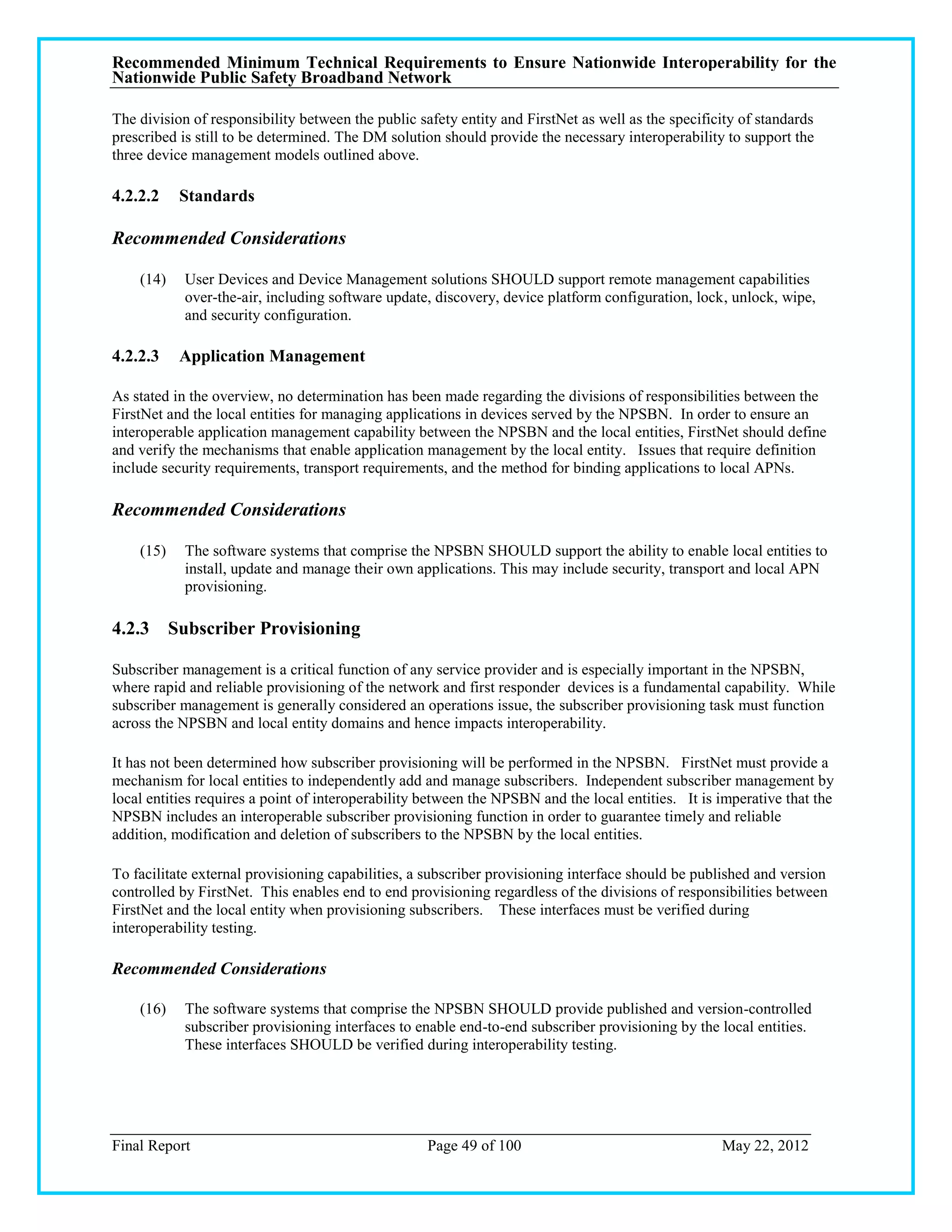
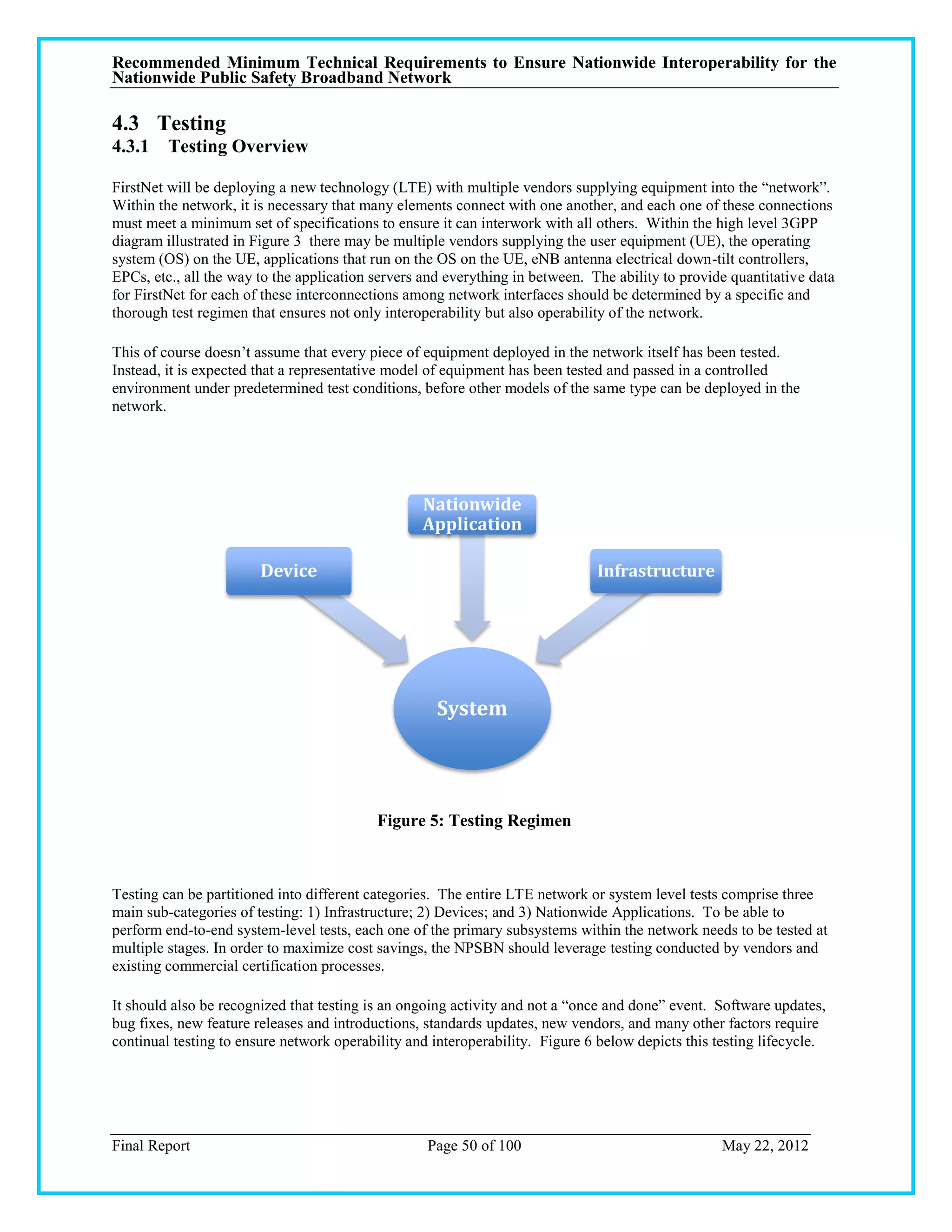
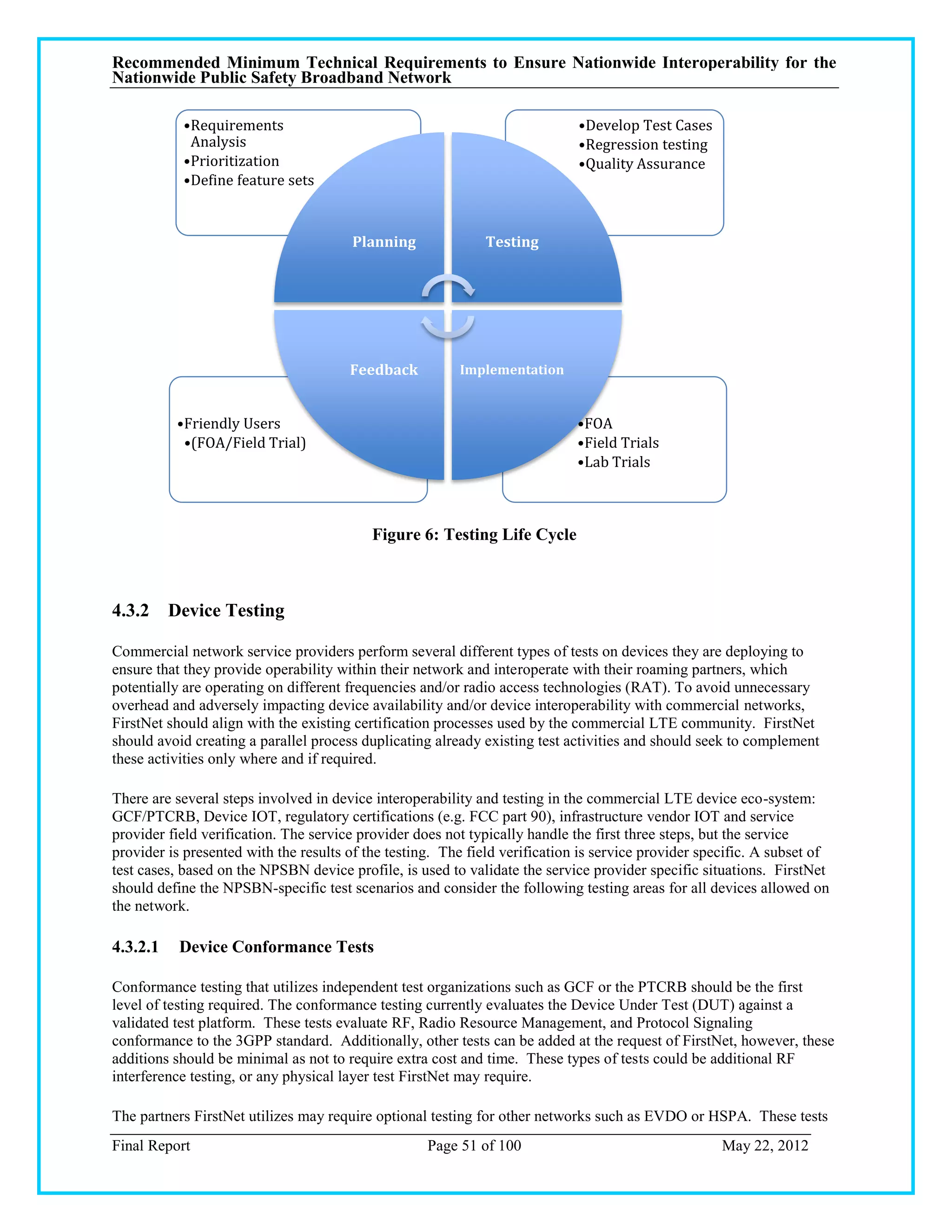
![Recommended Minimum Technical Requirements to Ensure Nationwide Interoperability for the
Nationwide Public Safety Broadband Network
should be at the discretion of FirstNet.
4.3.2.2 Device Interoperability Tests
Interoperability between a specific device and multiple infrastructure vendors also must be tested before devices are
deployed in a mixed-vendor network. FirstNet should adopt a similar process leveraging interoperability tests
performed by vendors and industry associations such as the CTIA LTE IOT Program (CPWG110615-1). Being
developed by the CTIA Certification Program Working Group, the LTE IOT Program would be appropriate to
consider. This would assure FirstNet that a newly introduced device from a device vendor will interoperate on all
of its chosen infrastructure vendors and its commercial roaming partners‘ networks. Additional tests for multiple
users, inter-LTE (other bands) and inter-RAT could also be part of this testing.
4.3.2.3 Device System Tests
Once conformance and interoperability testing is completed, another set of testing is performed before approving a
device on the network for operation. The following is an example of the testing that commercial service providers
perform on their devices as part of their certification process. Before launching a new device or allowing it to
access the network, FirstNet could adopt a similar certification process based on NPBSN defined device testing
requirements. It is recommended these testing requirements be included in addition to full lab conformance testing:
Safe-For-Network Test Plan
Field Test Plan
Common Services Test Plan (e.g. SMS, VoLTE, PTT)
Data Retry Test Plan
4.3.2.4 Device Ancillary Function Tests
Additional device tests could be performed to test the ancillary functions within the device. Other radio access
technologies may be implemented within a FirstNet device. If the device utilizes these technologies it is suggested
that they are tested. Below is an example list of device ancillary features and their respective testing or test
organization:
Bluetooth - Bluetooth Qualification Requirements23, established by the Bluetooth Special Interest Group
(Bluetooth SIG)
Wi-Fi – Use Wi-Fi Alliance® test plans24 to have certified Wi-Fi connectivity
Universal Integrated Circuit Card (UICC) - USIM/ ISIM applications on the UICC according to 3GPP TS
31.121 and TS 31.124
Location Based Services – Test to selected LBS specifications, e.g. A-GPS using 3GPP TS 34.171 and
3GPP TS 51.010-1.
4.3.2.5 Requirements for Device and Device Management Testing
[17] Prior to IOT and System-Level testing UEs SHALL have already met 3GPP conformance and
certification requirements per an independent conformance testing organization (e.g. PTCRB).
[18] Prior to operational deployment on the NPSBN, UEs SHALL have passed FirstNet-required
Interoperability Testing (e.g. using a subset of applicable test cases from CTIA IOT and UICC
23
https://www.bluetooth.org/login/default.aspx?ReturnUrl=/technical/qualification/requirements.htm
24
http://www.wi-fi.org/certification/programs
Final Report Page 52 of 100 May 22, 2012](https://image.slidesharecdn.com/interopboardfinalreport052212-13388963580201-phpapp02-120605064116-phpapp02/75/FCC-Interop-Board-Final-Report-05-22-12-52-2048.jpg)
![Recommended Minimum Technical Requirements to Ensure Nationwide Interoperability for the
Nationwide Public Safety Broadband Network
functional test cases, vendor IOT or similar commercial LTE industry practice).
[19] Prior to operational deployment on the NPSBN, UEs SHALL have passed FirstNet-required UICC
functional testing.
Final Report Page 53 of 100 May 22, 2012](https://image.slidesharecdn.com/interopboardfinalreport052212-13388963580201-phpapp02-120605064116-phpapp02/75/FCC-Interop-Board-Final-Report-05-22-12-53-2048.jpg)
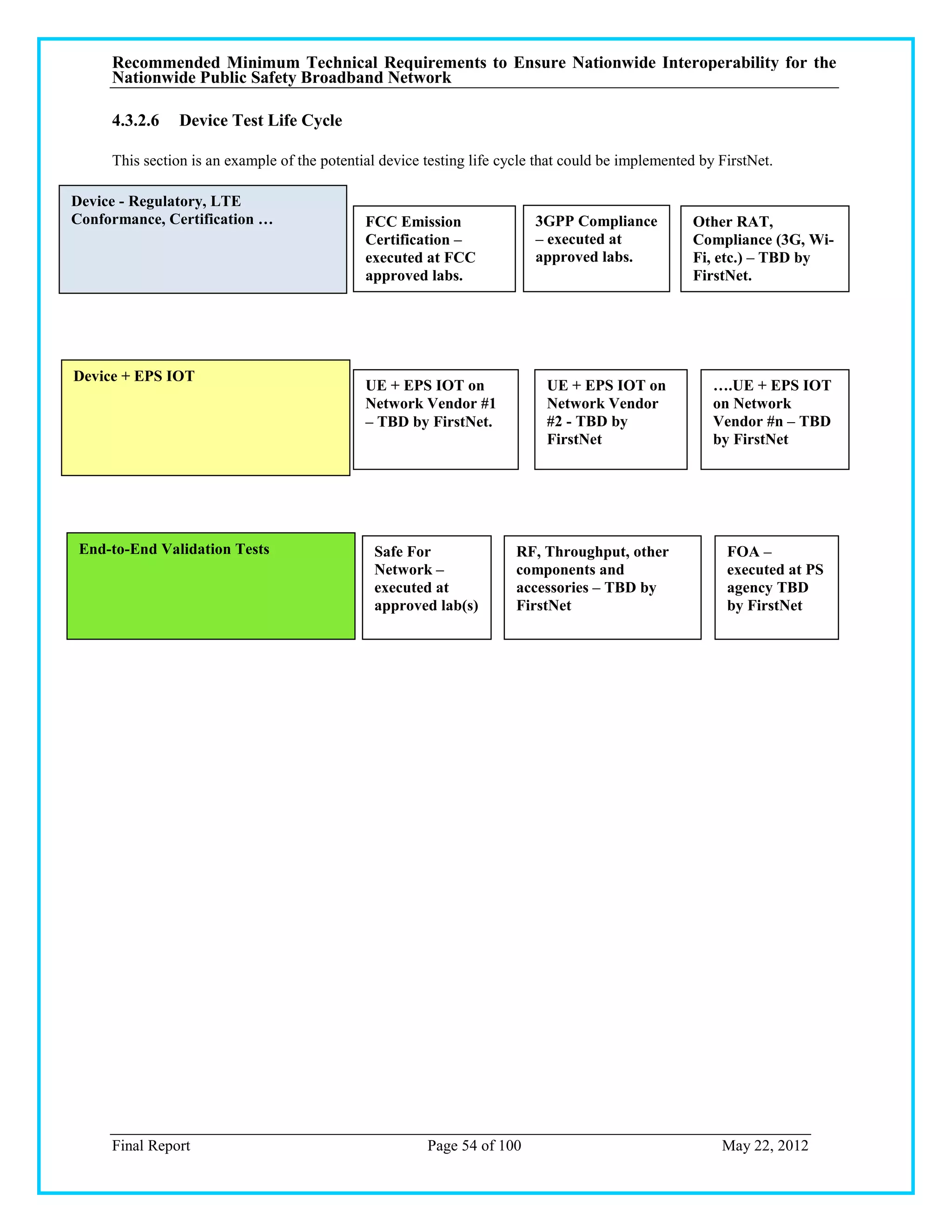
![Recommended Minimum Technical Requirements to Ensure Nationwide Interoperability for the
Nationwide Public Safety Broadband Network
4.3.3 Infrastructure Testing
Within the LTE network, the system is often split into the Radio Access Network (RAN) and Evolved Packet Core
(EPC). Entities outside of the EPC are often considered part of the Packet Data Network (PDN) and can consist of
the IP Multimedia Subsystem (IMS), APN servers, Device Management (e.g. OMA DM), IP eXchange (IPX) or
essentially any other ancillary systems that are outside of the typical 3GPP LTE diagram [ref 23.401]25. Each of
these systems have specifications or reference implementations within their appropriate Standards Development
Organizations (SDOs) such as 3GPP, IETF, and OMA. Due to the vast number of available interfaces and the
complexity required to address all of them, the context for this section will be to determine what types of tests
FirstNet should require of their vendors.
It is suggested that a set of end-to-end call flows for different scenarios be developed in conjunction with the
infrastructure vendors to facilitate better interoperability between the different network elements and the UE. This
should be only distributed to infrastructure and trusted UE / chipset vendors under Non Disclosure Agreement
(NDA). This will help to drive additional test cases for interoperability.
4.3.3.1 Infrastructure Interface Conformance Tests
These tests will assure that the subsystem under test conforms to the specifications for that equipment. An example
of this would be tests developed for the EPC S5 interface to verify conformance to 3GPP specifications. The
interfaces are usually divided into the user plane (payload) and control plane (signaling). Both portions of the
interface should be tested but typically the primary focus is on the signaling portion within the interface. Some
interfaces such as the Uu (air interface) have unique physical layer traits that should be tested in a manner similar to
the aforementioned device testing.
4.3.3.2 Infrastructure Interoperability Tests
These tests focus on the evaluation of how different vendor network elements interact with each other. In theory, if
the specifications are written perfectly and implemented perfectly, the entire network would be ―plug and play‖ and
interoperability testing (IOT) would not be required. In practice, vendors often interpret specifications differently,
are at different versions of the specification, or have implemented proprietary methodologies that may not allow
interoperability among vendors. An example of IOT is testing the S6a interface between the MME and HSS from
two different vendors.
Interoperability testing allows the network to support multiple vendors between specific interfaces. This would
allow FirstNet to leverage competition within the elements of the network and provide more choices for a cost-
benefit of features and price among different companies. Several different organizations such as the Multi Service
Forum (www.msforum.org) and the Network Vendors Interoperability Test Forum (www.nviot-forum.org) provide
a framework for system level IOT on LTE systems and can be leveraged for use by FirstNet to engage in this type
of testing.
4.3.3.3 Infrastructure Performance Tests
In order to determine how well a subsystem performs, where the limits are for scaling, and to ensure reliability, it
becomes necessary to test to evaluate the peak and loaded performance of the subsystem. This data can be then
used to check system reliability, gauge service level agreement (SLA) requirements and load balance the network.
An example of testing for this would be simulating several thousand cells on an MME and increasing the calls per
second until failure. The Interface Conformance Testing referred to below includes testing of each type of interface
deployed per vendor. Subsequent quantities of this same equipment are not tested prior to deployment.
25
www.3gpp.org/ftp/Specs/html-info/23401.htm
Final Report Page 55 of 100 May 22, 2012](https://image.slidesharecdn.com/interopboardfinalreport052212-13388963580201-phpapp02-120605064116-phpapp02/75/FCC-Interop-Board-Final-Report-05-22-12-55-2048.jpg)
![Recommended Minimum Technical Requirements to Ensure Nationwide Interoperability for the
Nationwide Public Safety Broadband Network
4.3.3.4 Recommendations for Infrastructure Testing
Recommended Requirements
[20] Prior to operational deployment on the NPSBN, infrastructure equipment SHALL have passed FirstNet-
required Interface Conformance Testing (e.g. testing S1-MME conformance to 3GPP) on the interfaces
specified by FirstNet.
[21] Prior to operational deployment on the NPSBN, infrastructure equipment SHALL have passed FirstNet-
required Interoperability Testing at a system level as per the specific IOT requirements for the NPSBN.
Recommended Considerations
(17) Prior to operational deployment on the NPSBN, infrastructure equipment SHOULD have passed
FirstNet-required Performance Testing of individual interfaces, nodes and overall system as per the
specific performance requirements of the NPSBN.
4.3.3.5 Network & Network Elements Test Life Cycle
This section is an example of the potential infrastructure testing life cycle that could be implemented by FirstNet.
Network Element - Regulatory, LTE FCC Emission
Conformance, Certification … Certification – 3GPP Compliance
executed at approved – shall be executed
lab or by the vendor by the vendor.
Statement of compliance
& submitted to FCC.
End-to-End Multi-Vendor IOT and ATP - RF, Multi-Vendor FOA – executed
Controlled Field User Trial. Throughput, IOT – executed at FirstNet site
Mobility,etc. – by a FirstNet location(s)
executed by the approved lab.
vendor at
FirstNet site
location
Final Report Page 56 of 100 May 22, 2012](https://image.slidesharecdn.com/interopboardfinalreport052212-13388963580201-phpapp02-120605064116-phpapp02/75/FCC-Interop-Board-Final-Report-05-22-12-56-2048.jpg)
![Recommended Minimum Technical Requirements to Ensure Nationwide Interoperability for the
Nationwide Public Safety Broadband Network
4.3.4 Nationwide Application Testing
Application testing for mobile devices is a complicated task since LTE devices will be in multiple forms such as
USB dongles, vehicle modems, and Smartphones. These devices typically run on different operating systems,
including Android, Windows 7, Symbian, and iOS. Typically commercial service providers utilize a common
connection manager to provide a common user interface across multiple hardware platforms and Operating
Systems. For example, a video client on an Android Smartphone and on a Windows 7 embedded modem laptop
may operate similarly to the end user but the way they operate to access the QoS to the network is typically
operating system and connection manager dependent.
FirstNet may establish specific Application Programming Interface (API) specifications for applications on the
network such as Push-To-Talk (PTT). The reason for developing the API specifications is that the PTT application
may have specific parameters assigned to it for quality of service (QoS), APN usage, encryption and other
application specifications. Application treatment is necessary for FirstNet users; therefore, each FirstNet software
application for nationwide use (e.g. PTT, VoLTE, SMS) utilized on the network should pass through a set of tests to
ensure it works properly on the device and does not cause unnecessary harm to the network. Most commercial
service providers require application certification. FirstNet should employ similar requirements. Testing to the API
for security issues may help prevent security issues that could be introduced into the network. Other local
jurisdictional software applications are not mandated to pass this testing but it is highly recommended that this type
of testing be performed to prevent network issues. FirstNet should consider developing a software applications
development guideline, to be used by all software applications deployed on the network, to prevent unintentional
network degradation.‖
4.3.4.1 Recommendations for Nationwide Application Testing
(18) Nationwide applications on the NPSBN SHOULD have passed FirstNet-required security testing to
proper security levels (e.g. Criminal Justice Information Services [CJIS]) to ensure protection of
FirstNet and public safety information.
4.3.5 System Level Testing
System testing is often called end-to-end testing and typically involves all the components of the network. After all
subsystem testing is completed, FirstNet may require that the entire network or major subsystems be run through a
series of tests to determine if the functional or systems level requirements for the system have been achieved.
Typically this type of system testing takes place in the form of a First Office Application (FOA) test process. The
FOA test case development is a collaboration between the vendor(s) and FirstNet. The FOA performs the following
functions:
Validates that products (equipment & software) meet the test and functional requirements
Evaluates new features and functionality in customer environment
Provides essential design feedback between vendor, FirstNet and end customers that will provide quality
assurance
4.3.5.1 Recommended Requirements for First Office Application Testing
[22] Infrastructure deployed on the NPSBN SHALL be included in the FirstNet-required FOA process as
part of the NPSBN deployment.
Final Report Page 57 of 100 May 22, 2012](https://image.slidesharecdn.com/interopboardfinalreport052212-13388963580201-phpapp02-120605064116-phpapp02/75/FCC-Interop-Board-Final-Report-05-22-12-57-2048.jpg)
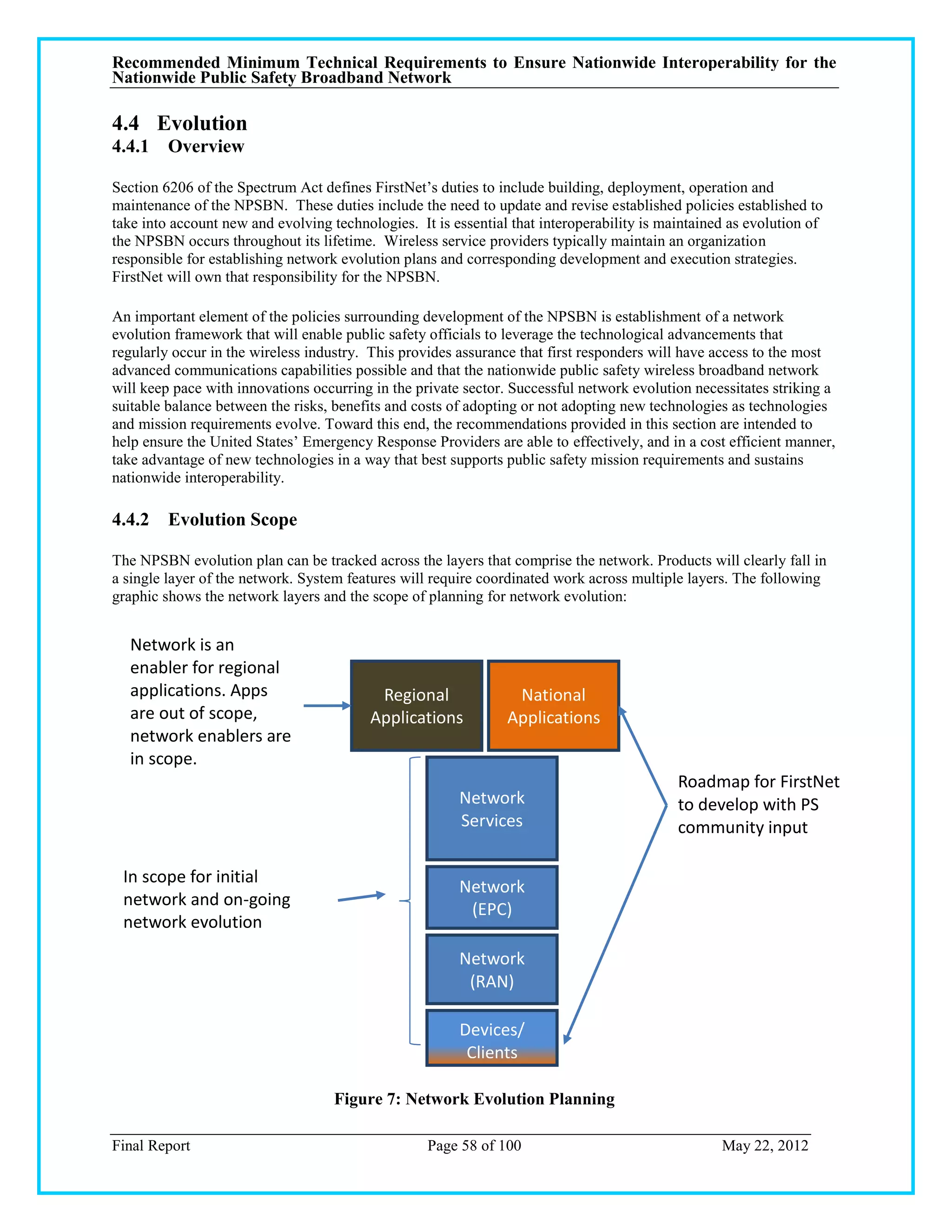
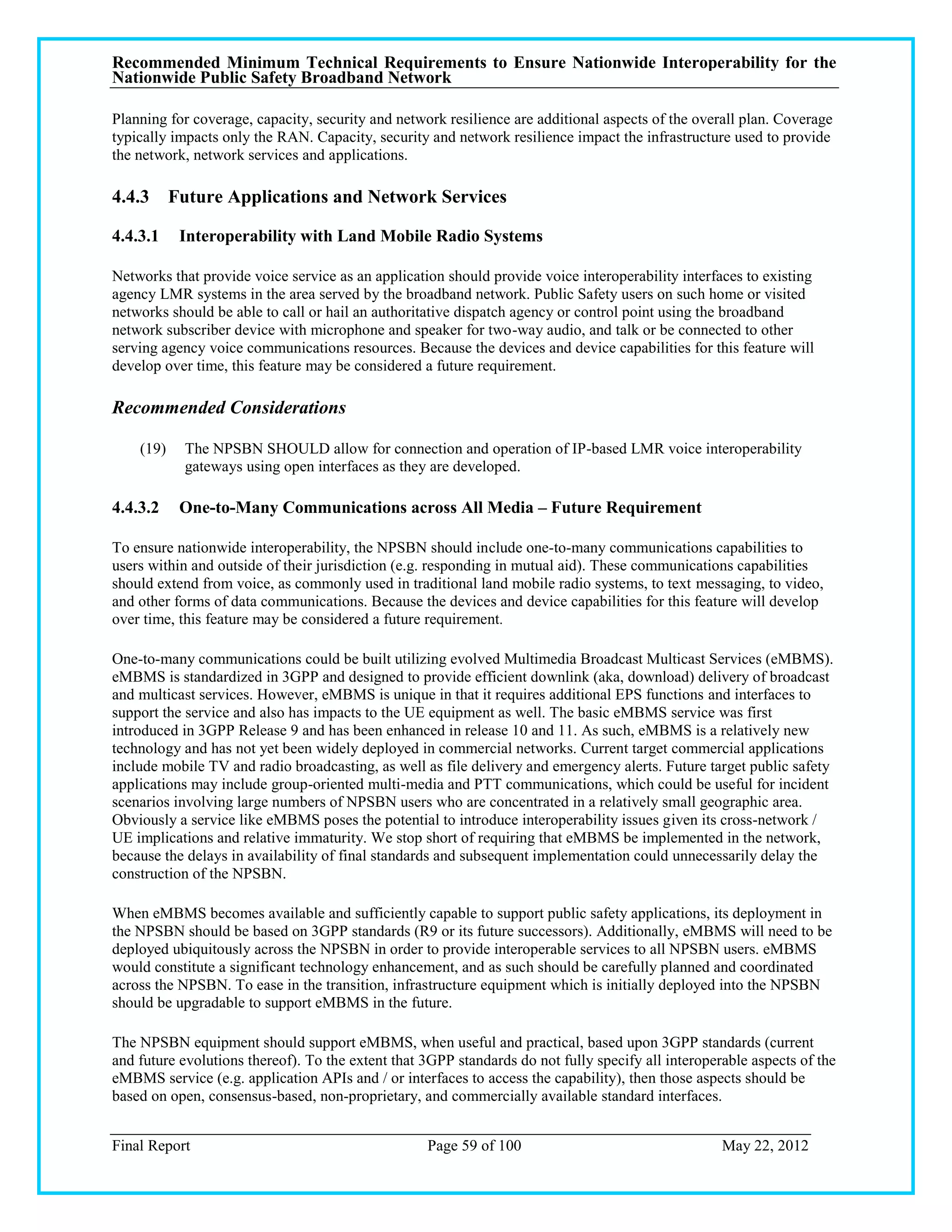
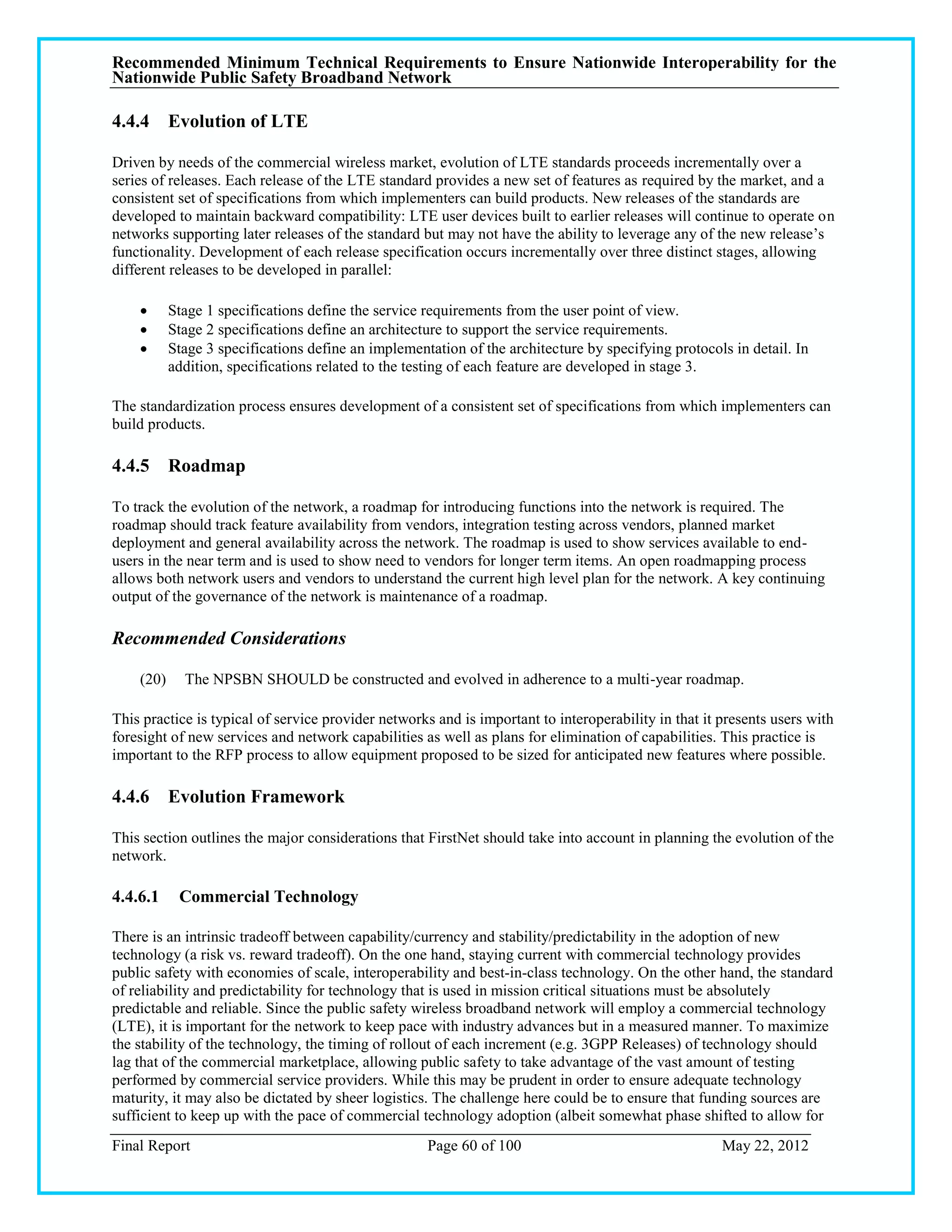
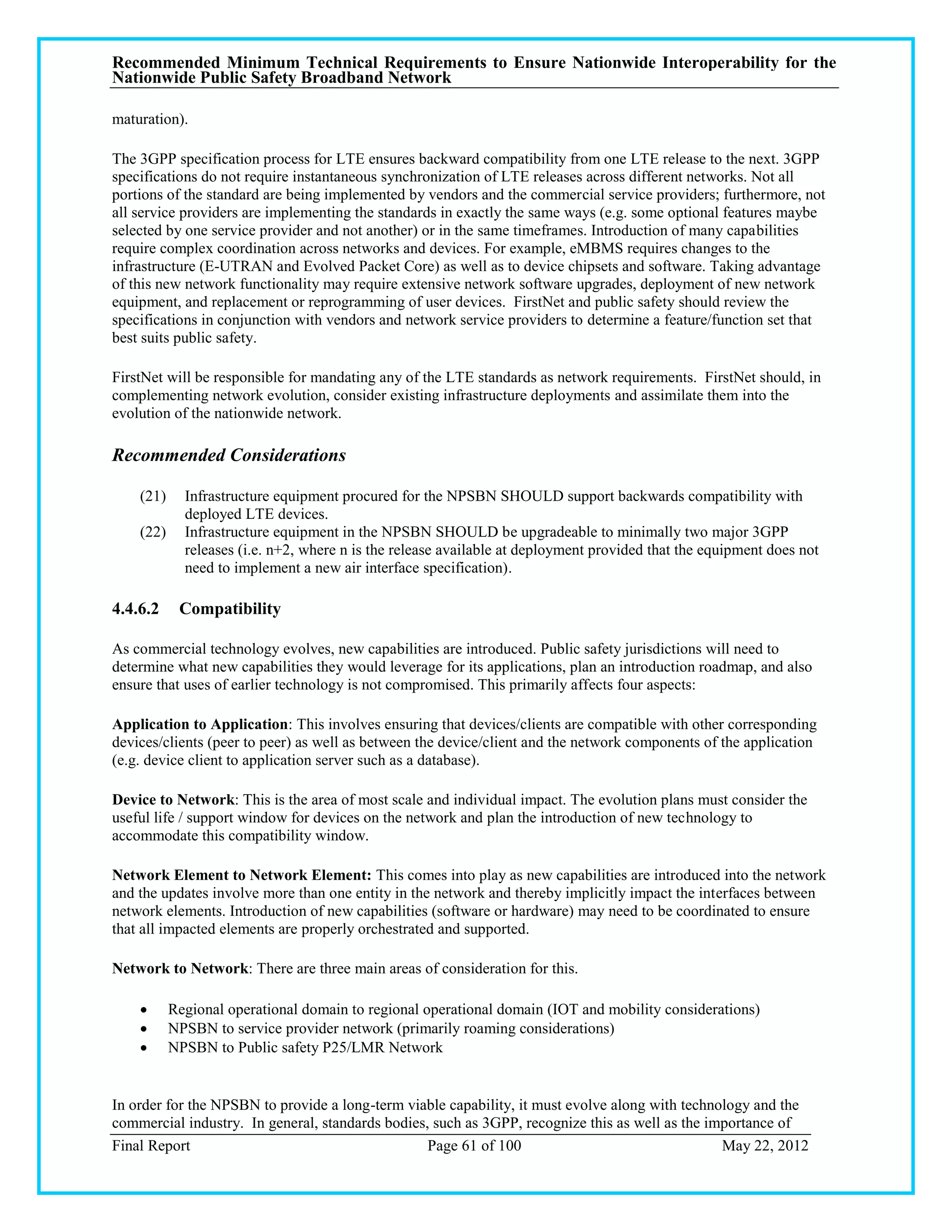
![Recommended Minimum Technical Requirements to Ensure Nationwide Interoperability for the
Nationwide Public Safety Broadband Network
managing this evolution for users of the network. Interfaces that are extended to users of the network (end-users,
application developers, state/agency IT, etc.) must be carefully managed in order to allow users to migrate their
dependencies gracefully as the network services evolve over time.
It will be necessary for the equipment comprising the NPSBN to be upgradable to support future features and
releases of the applicable standards (e.g. 3GPP). This is common industry-practice in order to ensure cost effective
and non-disruptive network evolution. Management of inter-network element (potentially inter-vendor) interfaces is
crucial to ensure that the equipment interoperates through successive releases and the evolution of the network.
Recommended Requirements
[23] The equipment comprising the NPSBN SHALL provide backwards compatibility of interfaces, from
time of deprecation, for a minimum of two full major release/upgrades of the network. This requirement
may be waived (i.e., interface obsolescence accelerated) if FirstNet can ascertain from the user
community that there are no dependencies on a given interface.
Recommended Considerations
(23) Hardware and software systems comprising the NPSBN SHOULD support industry practices for
management of standard network interfaces from each supplier. These industry practices include formal
publication of interface compliance, deprecation of interfaces, support for backwards compatibility and
graceful obsolescence of interfaces.
(24) The NPSBN SHOULD support industry practices for life cycle management of interfaces that it exposes
to applications or users of the network to ensure backward compatibility for a reasonable interval, using
industry-practice interface deprecation and obsolescence methods. The interfaces include, but may not
be limited to: Network messaging Protocols, Application Programming Interfaces, Web-based
Interfaces, Protocol/Messaging Interfaces, and User Interfaces such as Command Line Interfaces.
4.4.6.3 NG 911 Services
While not completely defined, NG (Next Generation) 9-1-1 services will have an effect on the NPSBN. The
following statistics indicate the possible potential to increase network traffic as these devices report public safety
events, accidents, injuries or whatever the call might be. Today in the United States, there are approximately 330
million wireless connections, while the U.S. population is slightly more than 312 million. Smartphones are in the
hands of about 43% of mobile phone users (62% if you are 25-34) and this number is growing rapidly. Voice
communications account for only 1/3 of mobile usage, with the remaining 2/3 of mobile traffic arises from text
messaging, applications, video calling, and so forth. Likewise, 32% of adults and 36% of children now live in
wireless-only households. In the 9-1-1 arena, 70-80 percent of 9-1-1 calls originate from mobile devices.
Consumers rightly and reasonably expect to be able to send data (pictures, video, and text messages) to 9-1-1 call
centers. As FirstNet develops the public safety wireless broadband network, it must ensure seamless and secure
communications paths exist from the individuals who originate 9-1-1 traffic, through the call/dispatch center, and
onto FirstNet‘s customers in the field. FirstNet must ensure that its network interoperates and interconnects with
Next Generation 9-1-1systems to meet the expectations of consumers who request service through 9-1-1. Finally,
FirstNet must ensure that its network includes location determination capabilities commensurate with those
available to consumers so that its own subscribers can be located when necessary.26
4.4.6.4 Coverage
As the network is initially built out, it is expected that it will incrementally expand to increase geographic coverage.
As regional networks ―grow‖ together, it will be important for the evolution to take into account a cohesive RF plan
26
The source of the statistics cited above is the 2011 Annual Report of CTIA – The Wireless Association.
Final Report Page 62 of 100 May 22, 2012](https://image.slidesharecdn.com/interopboardfinalreport052212-13388963580201-phpapp02-120605064116-phpapp02/75/FCC-Interop-Board-Final-Report-05-22-12-62-2048.jpg)
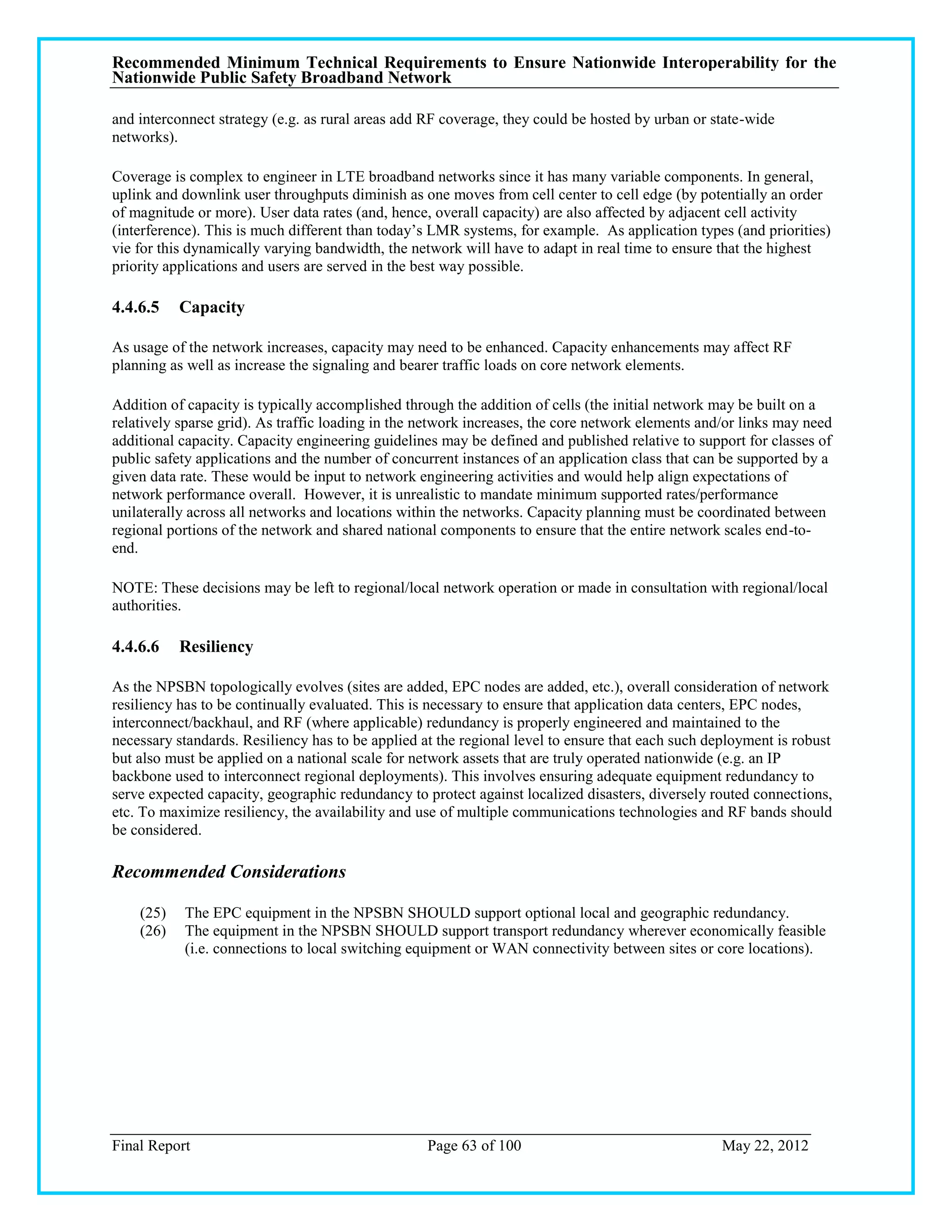

![Recommended Minimum Technical Requirements to Ensure Nationwide Interoperability for the
Nationwide Public Safety Broadband Network
and supported by RAN sharing features supported by LTE.
Recommended Requirements
[24] The NPSBN SHALL support user mobility across the entire NPSBN (including Opt-out states).
[25] The NPSBN SHALL support S1 and SHALL preferentially support X2 handover between adjacent
NPSBN cells (including cells owned by opt-out states) whose proximity supports a handover
opportunity.
4.5.2.1 Handover between cells in the NPSBN served by the same MME
Figure 9: Intra-MME Handover
As shown above, both cells are under the control of a common MME. (As of 3GPP R10, X2-based handovers are
only supported between eNBs served by a common MME.) In this scenario, the handover process leverages the X2
interface, supported by supplementary signaling carried over the S1-MME interface. Data forwarding for X2-based
handovers is supported via the X2 interface.
During the handover process, Information Elements and signaling messages defined by the 3GPP standards are
exchanged between source and target cells over the X2 interface. While X2 handovers use 3GPP‘s open standard
interface, X2 handovers between different vendors‘ eNBs require inter-vendor testing to ensure interoperability. To
reduce the amount of testing required during the early stages of introduction of a new wireless technology,
commercial service providers use a practice known as ―grouping‖ – grouping network elements from vendors in
their network deployments. The current best practice used by commercial service providers is grouping eNBs from
a common vendor into clusters of adjacent cells. These clusters, in turn, are served by a common MME for the
purpose of executing X2 handovers and supporting other air interface functions provided over the X2 interface (e.g.
scheduling, Inter-Cell Interference Coordination (ICIC), etc.). At the boundaries of these clusters, S1-based
handovers are used between eNBs provided by different vendors.
There is on-going work to perform the additional testing required to ensure the interoperability of inter-vendor X2
handovers. As and when commercial service providers start deploying inter-vendor X2 handovers, the NPSBN will
also be in a position to support inter-vendor X2 handovers as governed by the NPSBN‘s network evolution
planning. Such an approach will allow the NPSBN to leverage the testing performed by the commercial market.
An alternate and potentially resource-intensive approach is for the NPSBN to perform such testing on its own
initiative. Until this testing is completed, X2 handovers across vendors cannot be considered interoperable, and
hence should not be exclusively required in the NPSBN.
4.5.2.2 Handover between Cells in the NPSBN Served by Different MMEs
When a user/device moves into an adjacent region served by a different MME, the standardized S1 handover
mechanism, as shown below, provides seamless mobility.
Final Report Page 65 of 100 May 22, 2012](https://image.slidesharecdn.com/interopboardfinalreport052212-13388963580201-phpapp02-120605064116-phpapp02/75/FCC-Interop-Board-Final-Report-05-22-12-65-2048.jpg)
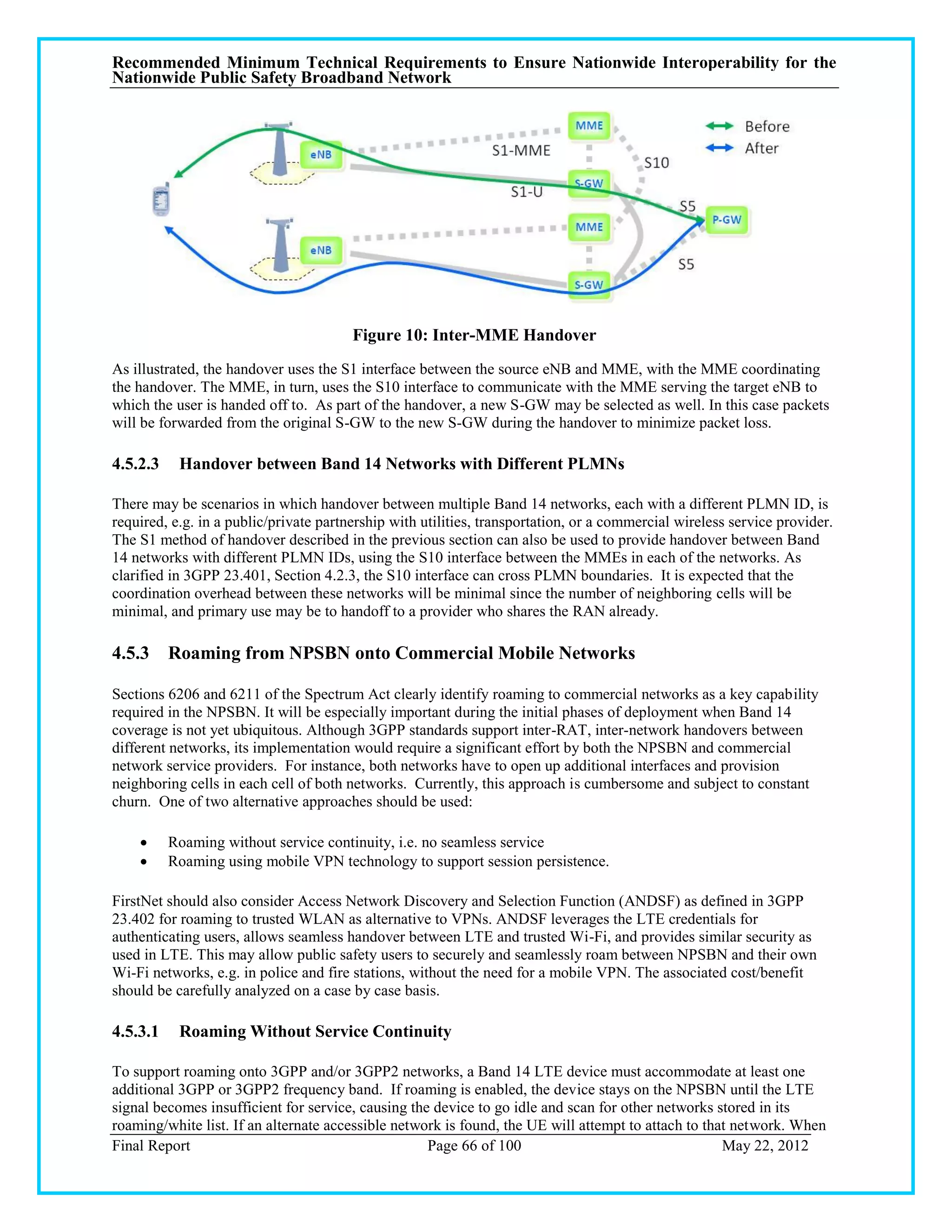

![Recommended Minimum Technical Requirements to Ensure Nationwide Interoperability for the
Nationwide Public Safety Broadband Network
Figure 12: Roaming Using Local Breakout APN
If roaming to 3GPP 2G/3G networks is supported, these networks require the HSS to act as an HLR to the 2G/3G
networks to provide an HLR view of subscriber‘s HSS data as defined in 3GPP TS 23.002. If roaming to 3GPP2
(eHRPD) networks is supported, the HSS needs to support the SWx interface as defined in 3GPP 23.402 to enable
an Authentication, Authorization and Accounting (AAA) view of the subscriber‘s HSS data, e.g. for authentication
of the user.
Recommended Requirements
[26] If roaming between the NPSBN and commercial LTE networks is implemented, the NPSBN SHALL
follow GSMA PRD IR.88.
[27] If roaming between the NPSBN and commercial 3GPP 2G/3G networks is implemented, the NPSBN
SHALL follow 3GPP TS 23.002 to support roaming into 3GPP 2G/3G networks.
[28] If roaming between the NPSBN and commercial 3GPP2 (eHRPD) networks is implemented, the
NPSBN SHALL follow 3GPP 23.402 to support roaming into 3GPP2 (eHRPD) networks.
Recommended Considerations
(27) If roaming between the NPSBN and commercial LTE networks is implemented, and IMS is
implemented in the NPSBN, the NPSBN SHOULD implement support for IMS while roaming into
other LTE PLMNs.
4.5.3.2 Use of Mobile VPN Technology to Provide Session Persistence when Users Roam
Support of session persistence when users roam to other RATs/networks can be provided using mobile VPN
solutions. However, the user may experience a short interruption depending on the specific mobile VPN selected.
Mobile VPN solutions are currently in use by public safety to, for example, support service continuity between
commercial wireless networks and Wi-Fi. In the NPSBN, the choice of whether to use mobile VPNs, and which
vendor equipment to use can continue to be made by the individual agencies. Typically this functionality resides in
a vehicle laptop or a trunk-mounted vehicle router. To support multiple wireless networks, the mobile VPN device
supports a wireless modem for each of the networks it needs to connect to. Each modem has its own wireless
subscription with associated monthly fees.
Final Report Page 68 of 100 May 22, 2012](https://image.slidesharecdn.com/interopboardfinalreport052212-13388963580201-phpapp02-120605064116-phpapp02/75/FCC-Interop-Board-Final-Report-05-22-12-68-2048.jpg)
![Recommended Minimum Technical Requirements to Ensure Nationwide Interoperability for the
Nationwide Public Safety Broadband Network
Today, mobile VPN is used with 2G/3G technologies to support best effort services only. When used for
guaranteed bit rate services with dedicated LTE bearers, a mobile VPN will be able to maintain service availability,
but the alternate access technology may not be able to provide the same quality of experience. For example, if a
user is sending real-time video on LTE and loses LTE connectivity, the new network may not have the bandwidth
available to continue this video service with the same quality of experience.
Recommended Requirements
[29] The NPSBN SHALL support the use of mobile VPN technology to support mobility between the
NPSBN and other networks.
Final Report Page 69 of 100 May 22, 2012](https://image.slidesharecdn.com/interopboardfinalreport052212-13388963580201-phpapp02-120605064116-phpapp02/75/FCC-Interop-Board-Final-Report-05-22-12-69-2048.jpg)
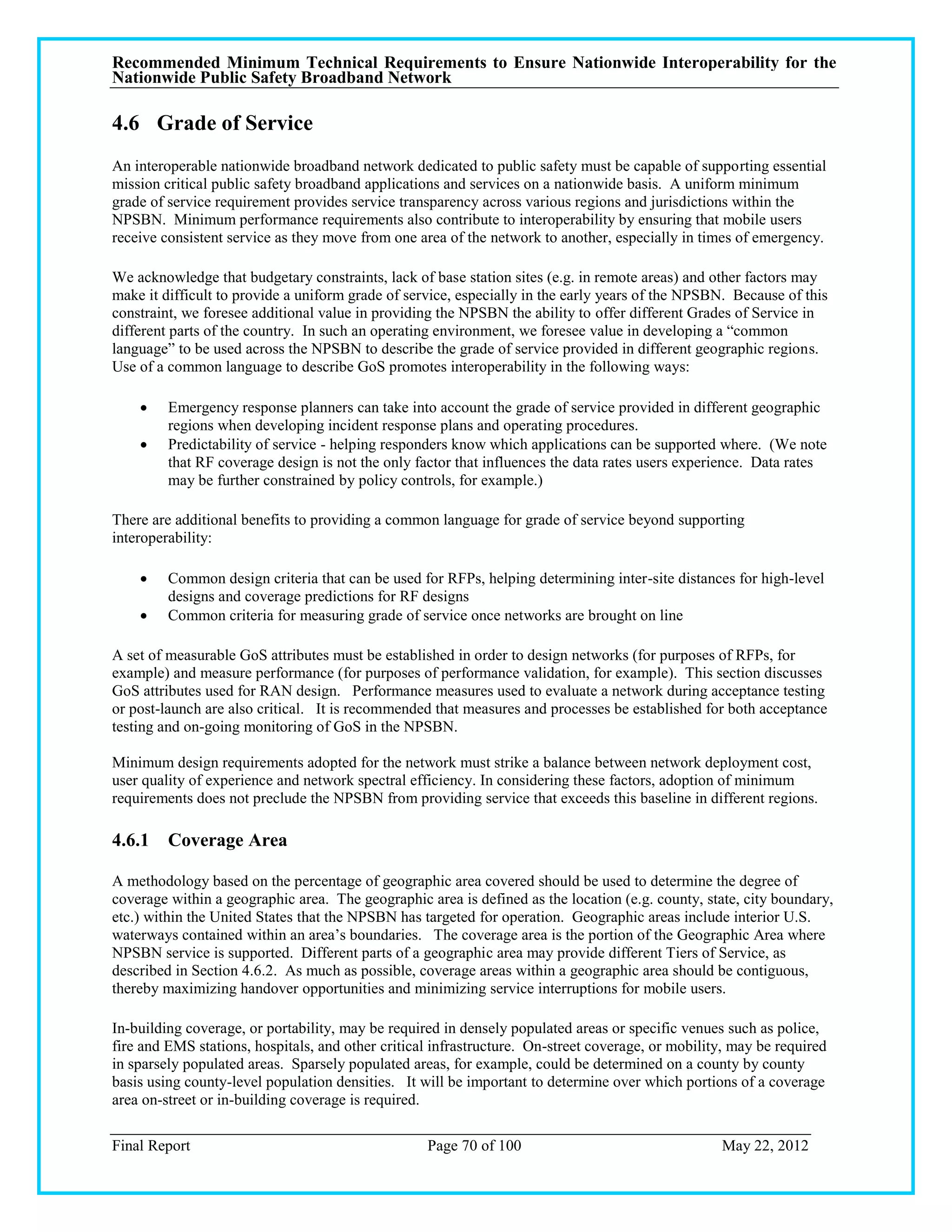
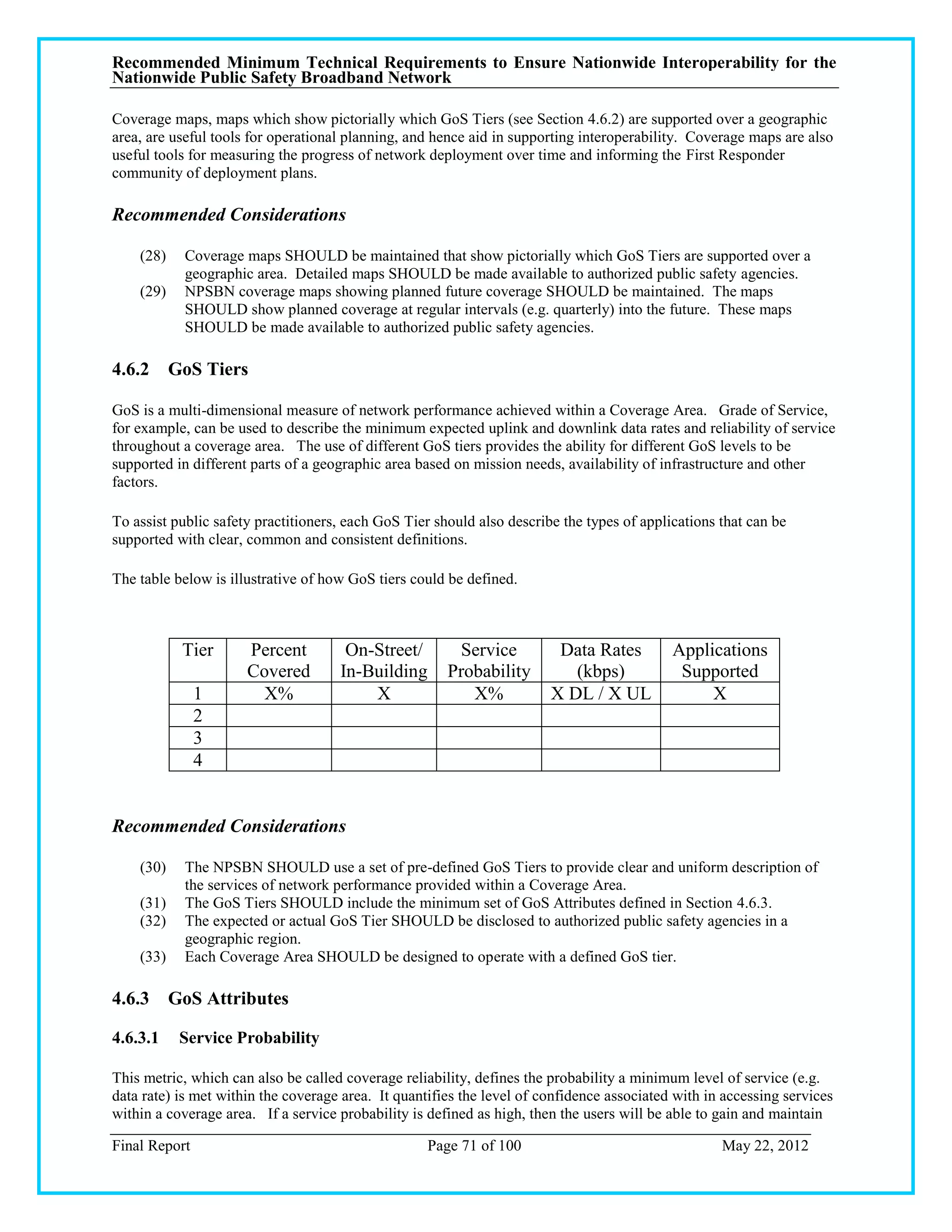
![Recommended Minimum Technical Requirements to Ensure Nationwide Interoperability for the
Nationwide Public Safety Broadband Network
access to the network more frequently and be refused or have difficulty maintaining service less often.27
RF engineering will have a significant impact on the performance of the network and therefore affect service
probability. Once a coverage area is specified, cell tower placement, system tuning and ongoing performance
maintenance among other factors are critical to achieving high service probability specifications.
Recommended Considerations
(34) Service probability SHOULD be specified for each GoS Tier, in order to specify the quality of the user
experience provided by the network.
4.6.3.2 Data Rates
Cell edge data rates, the minimum data rates achieved across a site coverage area with a certain confidence level,
are critical design metrics. Cell edge data rates determine the minimum required signal levels that must be
supported over a coverage area. The signal levels needed to achieve a target data rate vary across infrastructure and
device vendors because of their respective systems‘ specifications and resource allocation strategy.
Cell edge data rates should be utilized for engineering purposes as they provide a consistent measure of worst-case
performance over a coverage area. Minimum data rate is readily measurable, and therefore is a useful statistical
tool for quantifying system performance. 28 Due to protocol overhead bits inserted at different layers of the protocol
stack, data rates at different reference points in the protocol stack vary. Hence, when minimum data rates are
specified, they must also include the protocol layer at which the data rates are to be measured.
Recommended Considerations
(35) The expected minimum uplink (mobile to network) and downlink (network to mobile) rates of data
transmission SHOULD be specified for each GoS Tier. The specifications must also include the
protocol layer at which the data rates are to be measured.
4.6.3.3 Usage Models
The amount of traffic generated in a coverage area affects interference level, and hence, network performance.
Therefore, the NPSBN should be engineered to meet defined Usage Models for each Coverage Area, for example
Light, Medium, Heavy or Emergency.
Expected utilization of the network plays a key role in determining the design and effectiveness of the network. A
usage model should take into account different customer usage patterns and the data volumes of the applications
they will utilize (web browsing, FTP, VoIP, Streaming Video, etc.).
4.6.4 RAN Boundaries & Coordination
27
RFPs issued by FCC Waiver Recipients have largely specified a 95% probability of service for the Public Safety
network. [See LA RICS RFP Addendum 1 Sec. 8.20.5; also City of Mesa, AZ RFP #2010209 Sec. 1.9.1]
28
RFPs issued by FCC Waiver Recipients have largely specified 768k downlink [system-to-mobile] and 256k
uplink [mobile-to-system] for the Public Safety network. [See LA RICS Addendum 8 Section 8.3.3
Final Report Page 72 of 100 May 22, 2012](https://image.slidesharecdn.com/interopboardfinalreport052212-13388963580201-phpapp02-120605064116-phpapp02/75/FCC-Interop-Board-Final-Report-05-22-12-72-2048.jpg)
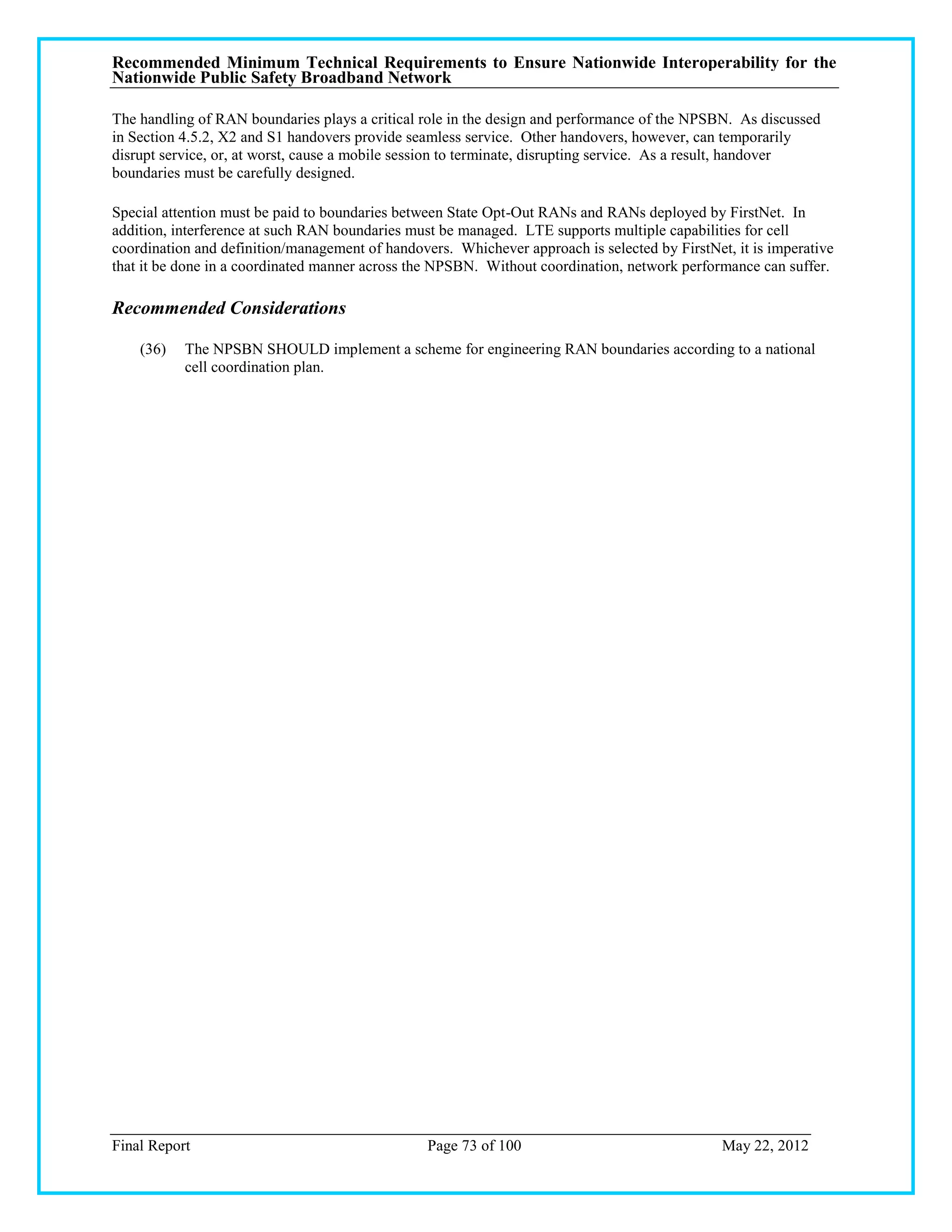
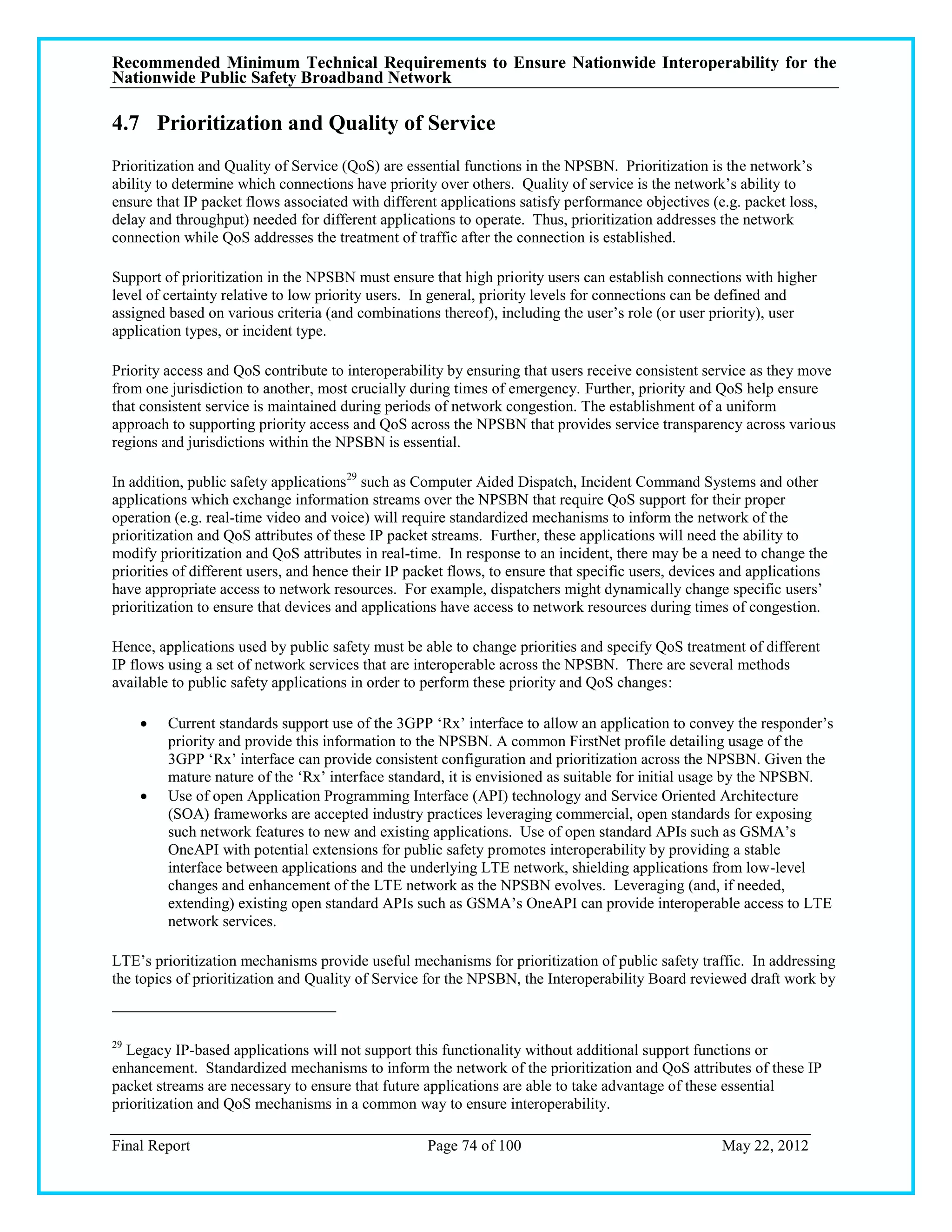
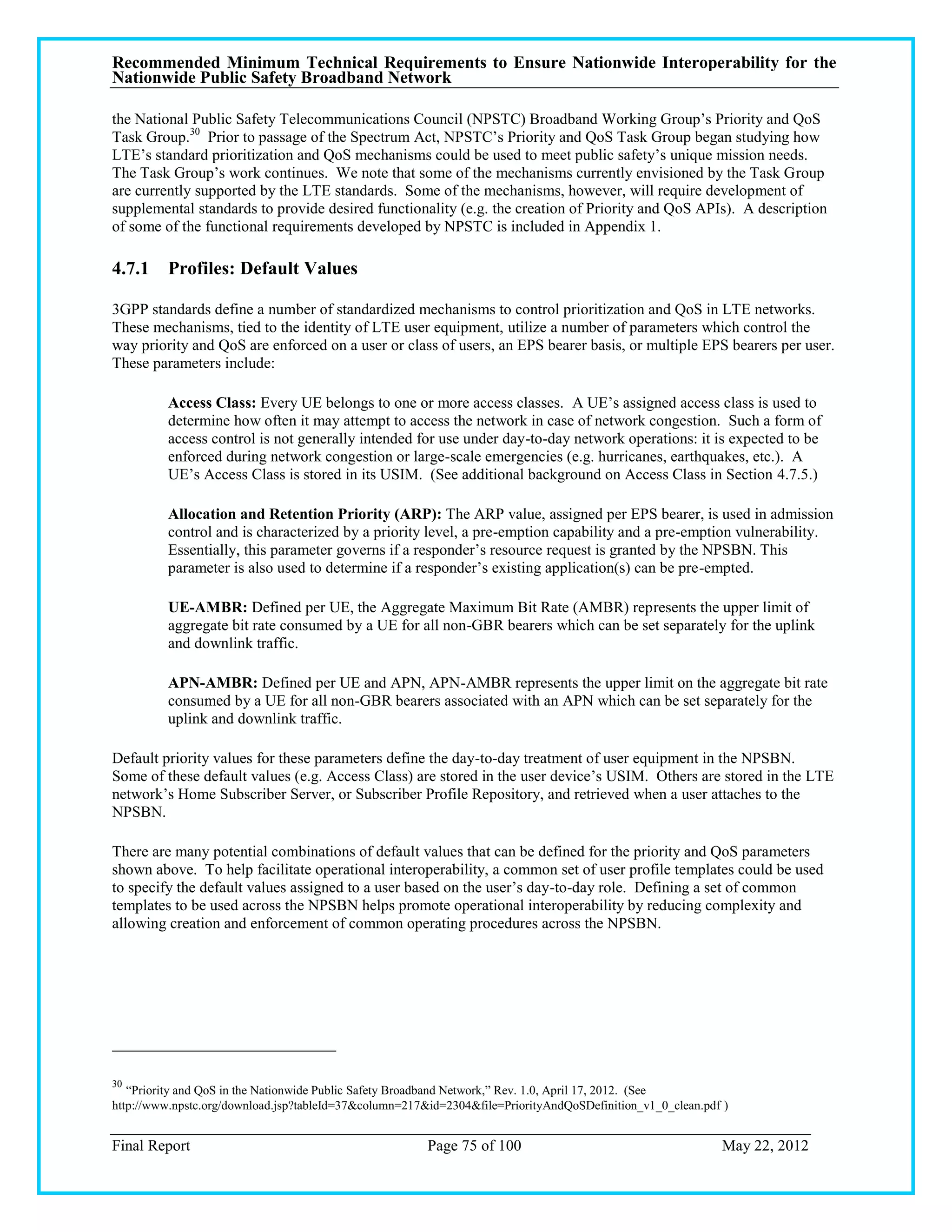
![Recommended Minimum Technical Requirements to Ensure Nationwide Interoperability for the
Nationwide Public Safety Broadband Network
Recommended Considerations
(37) A set of default QoS profile templates SHOULD be defined for each responder function (e.g. police,
fire, EMS) supported by the NPSBN.
(38) Each QoS profile template SHOULD contain a descriptive definition of the responder function and
default values for ARP, Access Class, UE-AMBR, and APN-AMBR.
(39) Since the NPSBN could also support secondary users, default QoS profile templates SHOULD be
defined for public safety and secondary users.
(40) Every user of the NPSBN (public safety and secondary users) SHOULD be assigned a default
prioritization and QoS profile using the set of pre-defined QoS profile templates.
(41) A process SHOULD be established and followed to manage the assignment of templates to users to
ensure template assignment rules are uniformly applied for all users using the NPSBN.
4.7.2 Profiles: Dynamic modification
Supporting public safety incident response, planned events, and other situations may require temporary changes to a
user‘s default prioritization and QoS treatment. Hence, the NPSBN must allow temporary override of the default
profiles.
Recommended Requirements
[30] The NPSBN SHALL provide the ability for national, regional, and local applications to dynamically
change a UE‘s prioritization and QoS using the 3GPP ‗Rx‘ interface.
Recommended Considerations
(42) FirstNet SHOULD make an API available to national, regional, and local applications to expose Priority
and QoS control.
4.7.3 QoS Class Identifiers (QCIs)
LTE has developed standardized mechanisms for defining the QoS requirements of different IP packet flows.
These mechanisms are used by the LTE network, for example, to determine how packets should be scheduled for
transmission and how other network resources should be assigned to users to ensure the delay, loss and throughput
requirements of the IP flows are met.
3GPP TS 23.203 defines a standardized set of QoS Class Identifiers (QCIs) (shown in the table below). This set of
QCIs describes the QoS characteristics of all applications that are currently envisioned to be carried over an LTE
network. Use of a common set of QCI definitions across the NPSBN facilitates interoperability by ensuring there is
a common way to describe the QoS requirements of all applications which use the NPSBN. Use of the standardized
set of QCIs defined in the table below also facilitates roaming onto commercial networks – as these networks also
use the same standard definitions of QCI defined in TS 23.203.
Final Report Page 76 of 100 May 22, 2012](https://image.slidesharecdn.com/interopboardfinalreport052212-13388963580201-phpapp02-120605064116-phpapp02/75/FCC-Interop-Board-Final-Report-05-22-12-76-2048.jpg)
![Recommended Minimum Technical Requirements to Ensure Nationwide Interoperability for the
Nationwide Public Safety Broadband Network
Table 4: QoS Class Identifiers (Excerpted from table 6.1.7 of 3GPP 23.203 V9.11)
QCI Resource Priority Packet Packet Example Services
Type Delay Error Loss
Budget Rate
1 2 100 ms 10-2 Conversational Voice
2 4 150 ms 10-3 Conversational Video (Live Streaming)
GBR
3 3 50 ms 10-3 Real Time Gaming
4 5 300 ms 10-6 Non-Conversational Video (Buffered
Streaming)
5 1 100 ms 10-6 IMS Signalling
6 Video (Buffered Streaming)
6 300 ms 10-6 TCP-based (e.g. www, e-mail, chat, ftp, p2p
file sharing, progressive video, etc.)
7 Non-GBR Voice,
7 100 ms 10-3 Video (Live Streaming)
Interactive Gaming
8 Video (Buffered Streaming)
8 TCP-based (e.g. www, e-mail, chat, ftp, p2p
300 ms 10-6 file sharing, progressive video, etc.)
9 9
Recommended Requirements
[31] The NPSBN SHALL support all 9 QCI classes specified in table 6.1.7 of 3GPP 23.203 v9.11 or future
equivalents.
[32] QoS mechanisms in the NPSBN SHALL comply with 3GPP TS 23.203.
4.7.4 Preemption
Pre-emption is an essential function in the NPSBN to allow appropriate management of the system resources,
especially during emergencies. Usage of all 15 ARP values by the NPSBN is essential to provide sufficient priority
differentiation for the default and dynamic priority requirements outlined in this section.
Recommended Requirements
[33] The NPSBN SHALL support the usage of all 15 ARP values defined in 3GPP 23.203.
[34] The NPSBN SHALL support the ARP pre-emption capability and vulnerability functions as defined in
3GPP 23.203.
4.7.5 Access Class
Per the 3GPP standards, every UE is assigned to one or more access classes. A UE‘s assigned access class is used
to determine how often it may attempt to establish communications with the LTE network. Per 3GPP standards,
Access Class Barring was designed to give certain classes of UE preferential access to the system (e.g. police get
preferential access over consumer users on a commercial system). The ultimate goal of the capability is to protect
against random access channel congestion at a site resulting from an ―access storm‖ by many UEs at one time.
Final Report Page 77 of 100 May 22, 2012](https://image.slidesharecdn.com/interopboardfinalreport052212-13388963580201-phpapp02-120605064116-phpapp02/75/FCC-Interop-Board-Final-Report-05-22-12-77-2048.jpg)
![Recommended Minimum Technical Requirements to Ensure Nationwide Interoperability for the
Nationwide Public Safety Broadband Network
Under heavy congestion, it is possible to engage Access Class Barring at a given site. Once engaged, certain classes
of UE may be substantially delayed from any communication with the NPSBN. This capability is required in the
NPSBN primarily in a public/private partnership arrangement where first responders/secondary users as well as
commercial users share the Band 14 spectrum and eNBs. Consequently, UEs homed to the NPSBN must be
provisioned with an appropriate access class.
Recommended Requirements
[35] The NPSBN SHALL implement a nationwide scheme for assigning Access Classes to public safety
users and secondary users following the 3GPP recommendations in TS 22.011, Section 4.2.
4.7.6 IP Network Priority
In order to provide consistent end‐to‐end treatment of Public Safety traffic, prioritization of NPSBN resources must
be provided both over the air as well as within the IP network infrastructure. A traditional practice is to align the
priority used by the NPSBN IP network and backhaul technology with the scheduling priority (QoS Class Identifier
priority, Section 4.7.3). Failure to align these priorities, for example, may result in low over-the-air packet loss rate,
but a high IP transport network packet loss rate. This would create a poor user experience, especially for voice and
video applications.
Recommended Requirements
[36] The NPSBN SHALL implement a nationwide scheme for assigning QoS Class Identifier priority to IP
network and backhaul priority across the entire NPSBN.
4.7.7 (M)VPN Priority and QoS
Public safety relies on VPN and Mobile VPN technology today to securely transport responder traffic from mobile
devices to application servers. For example, secure CJIS queries are encapsulated to provide confidentiality and
integrity of the transported citizen information. With (M)VPN technology, a variety of applications (CAD, tactical
video, surveillance video, etc.) are typically encapsulated into a single ‗tunnel‘. Because LTE technology is
expected to greatly expand the number and types of multimedia applications available, either multiple (M)VPN
tunnels or multiple application flows encapsulated within a tunnel are needed per user to account for the different
types of traffic.
The use of a VPN obscures the source of traffic flowing towards a UE. This creates a problem for an application
supporting an Rx interface that is unaware of the VPN. This requires an arbitrating function that is Rx and VPN
aware is introduced between the application and the EPC.
Recommended Requirements
[37] The NPSBN SHALL support the use of industry standard VPN and MVPN technology, while providing
priority and Quality of Service for encapsulated applications.
Final Report Page 78 of 100 May 22, 2012](https://image.slidesharecdn.com/interopboardfinalreport052212-13388963580201-phpapp02-120605064116-phpapp02/75/FCC-Interop-Board-Final-Report-05-22-12-78-2048.jpg)
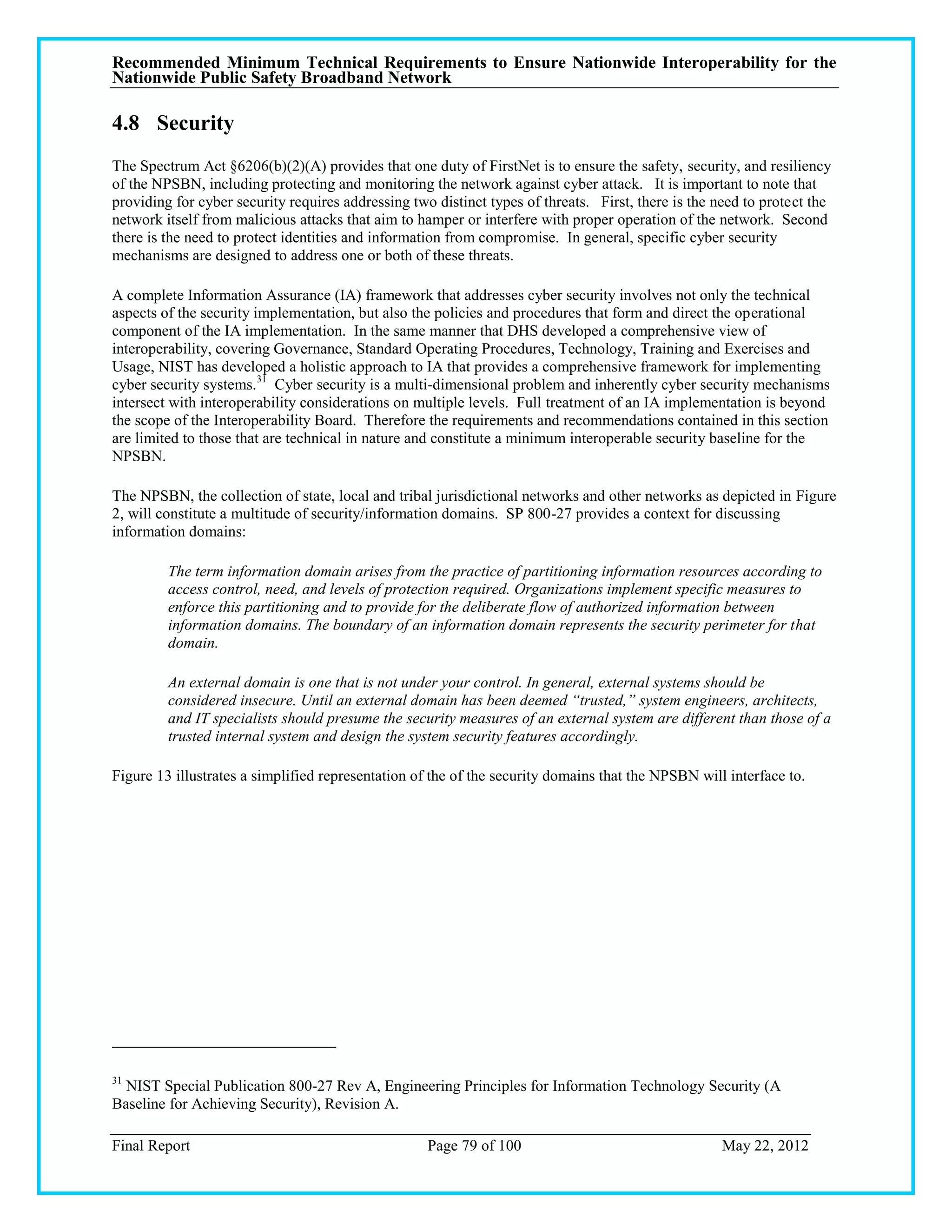
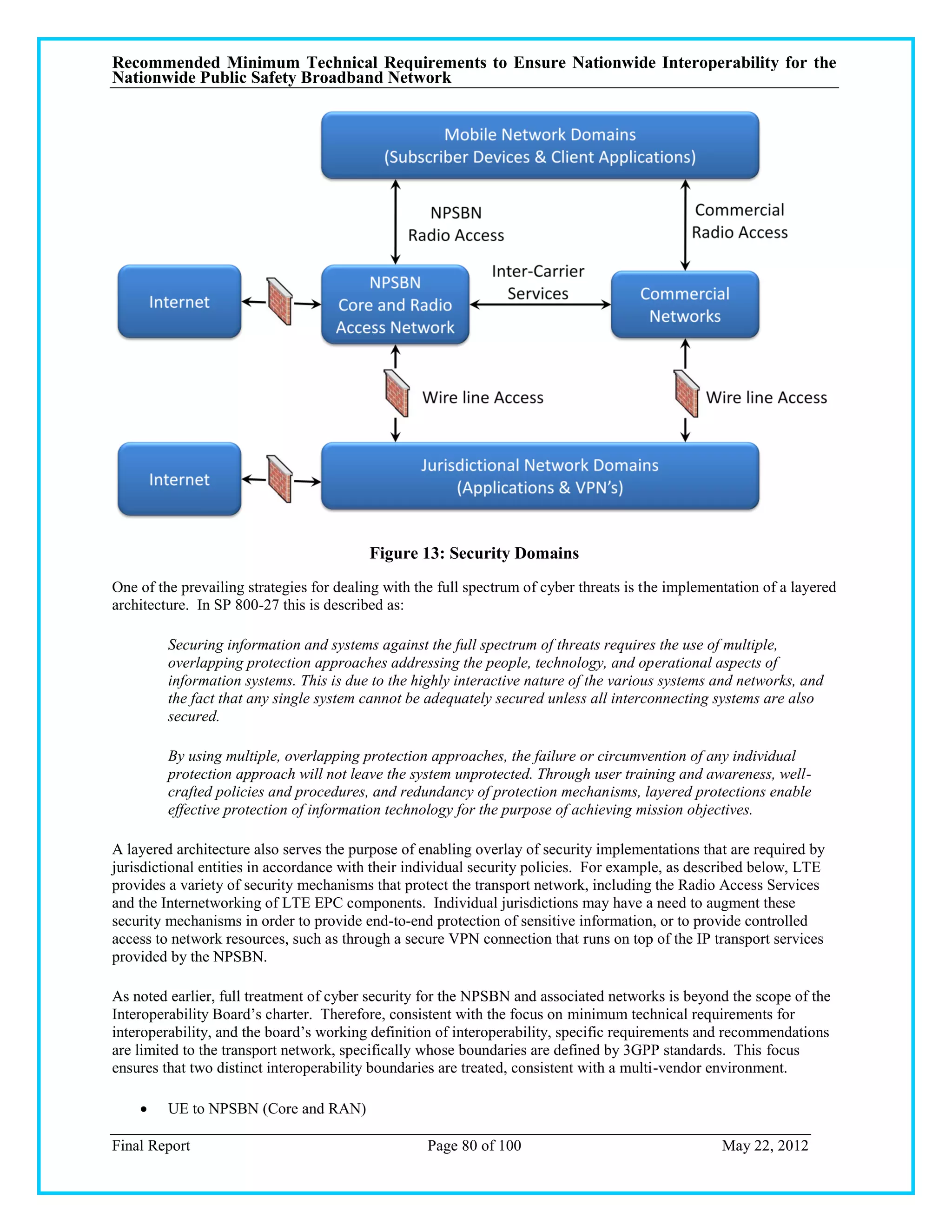
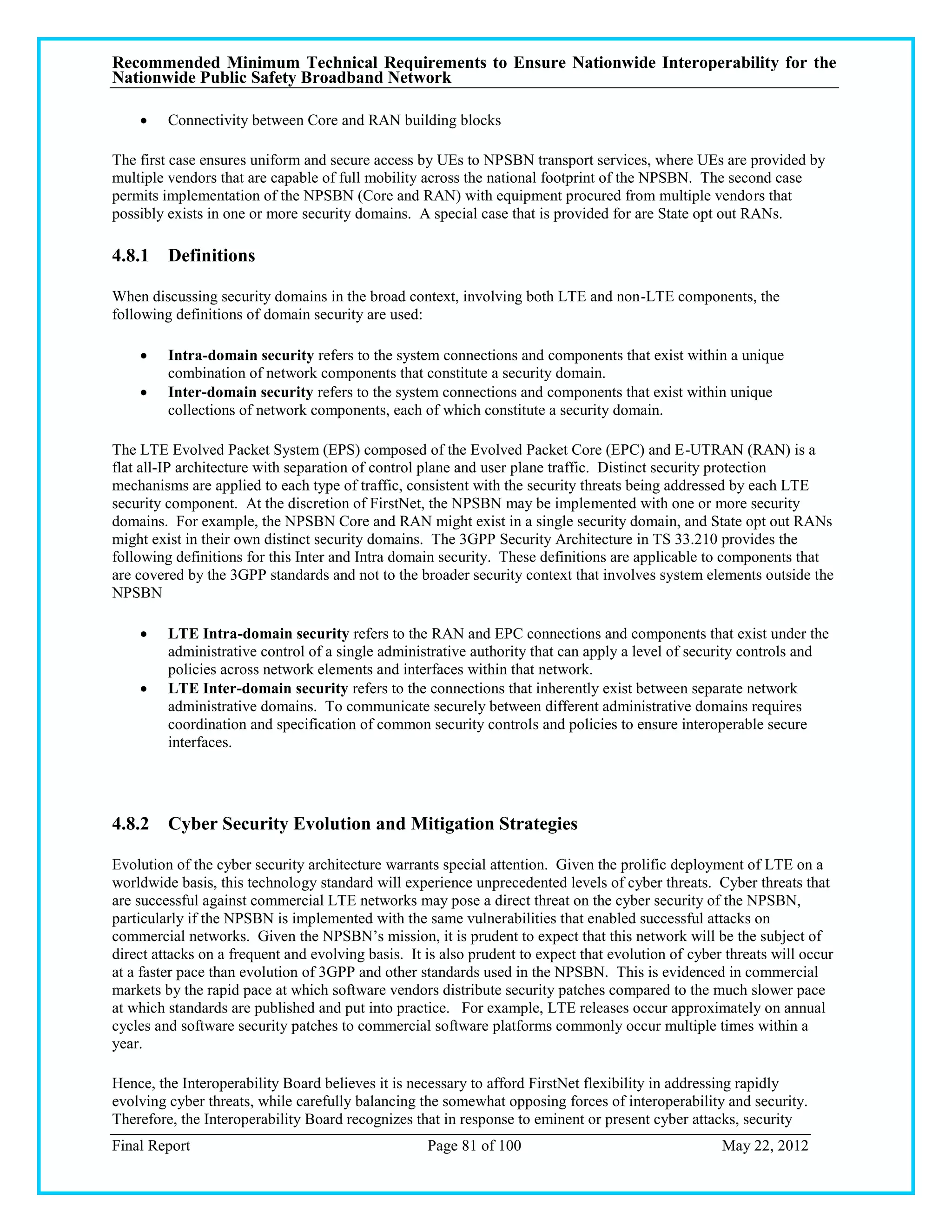
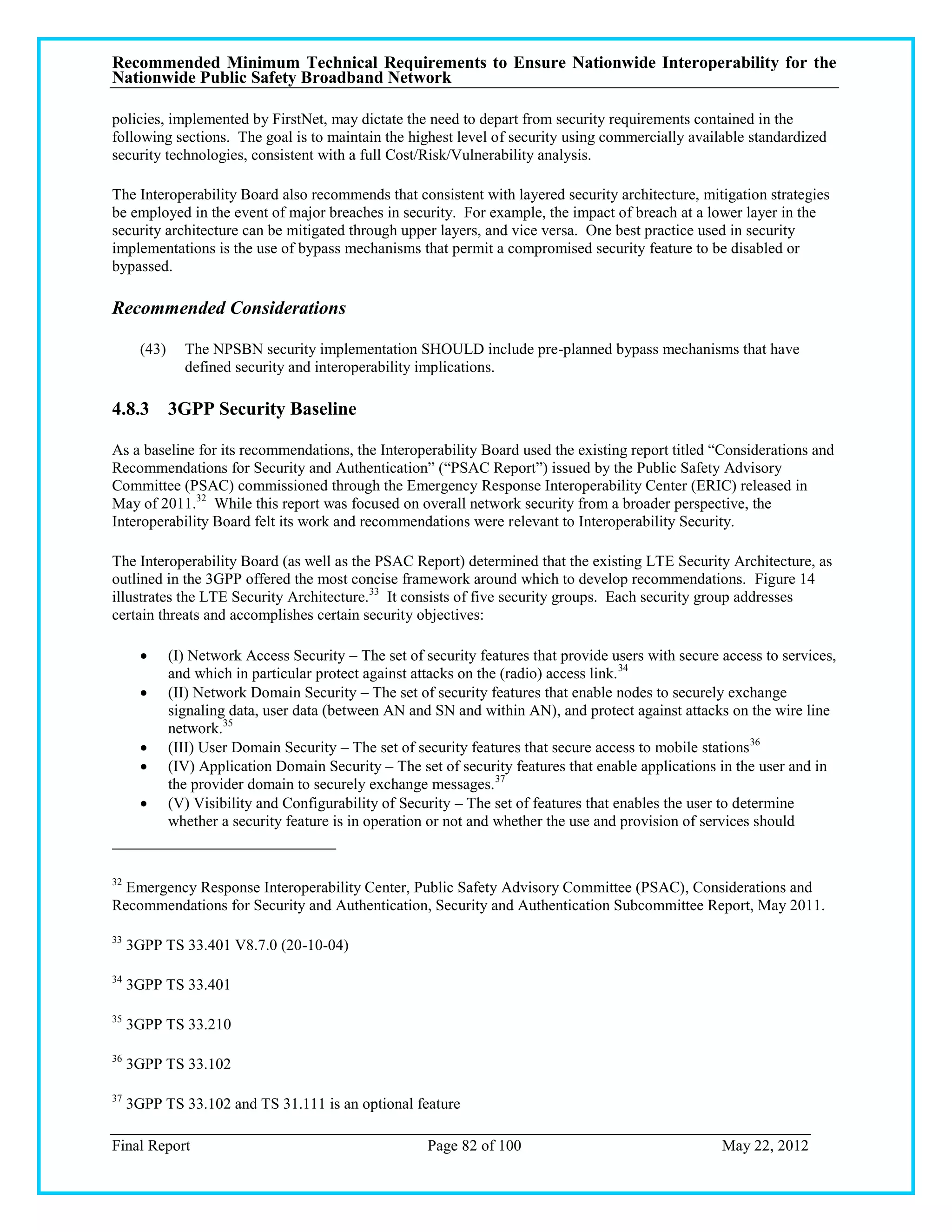
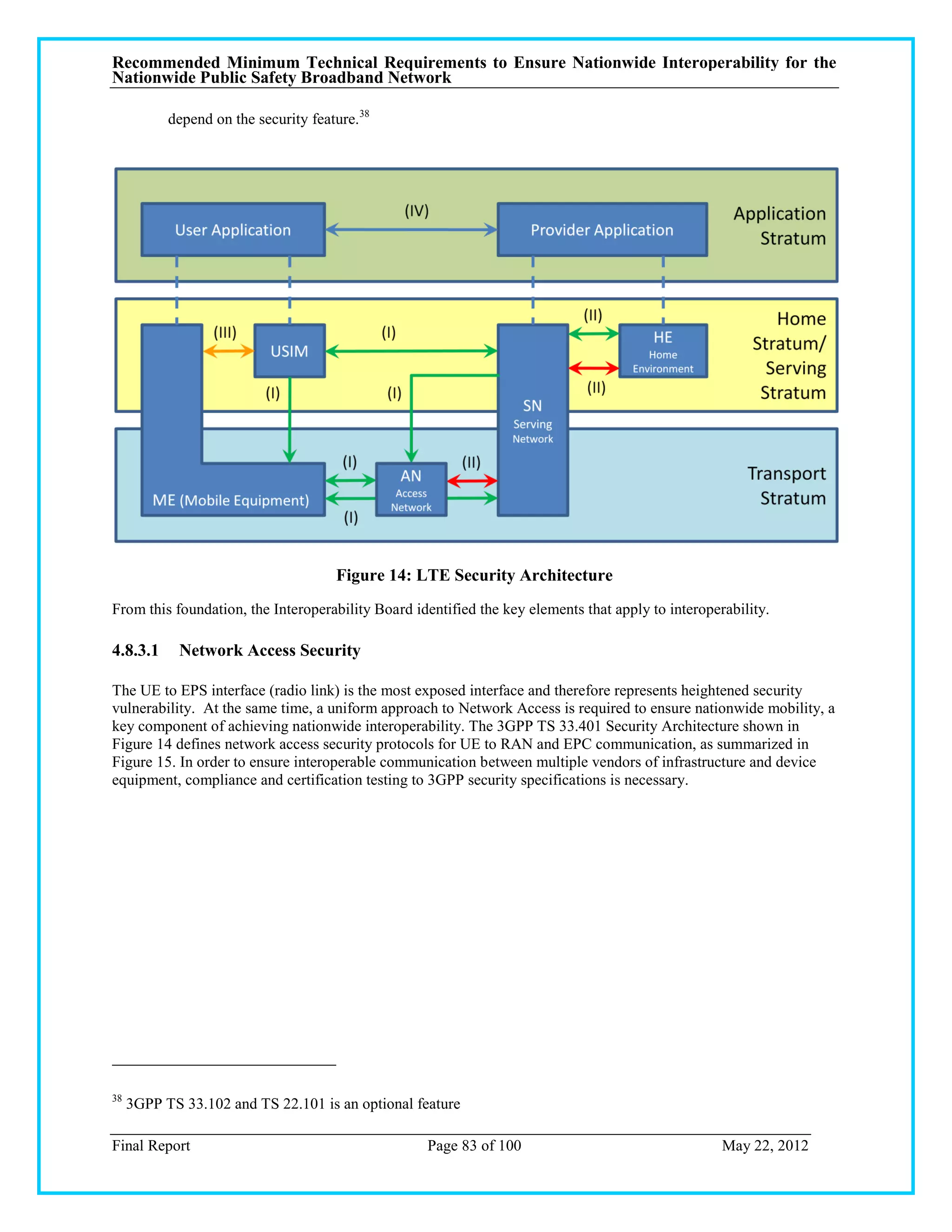
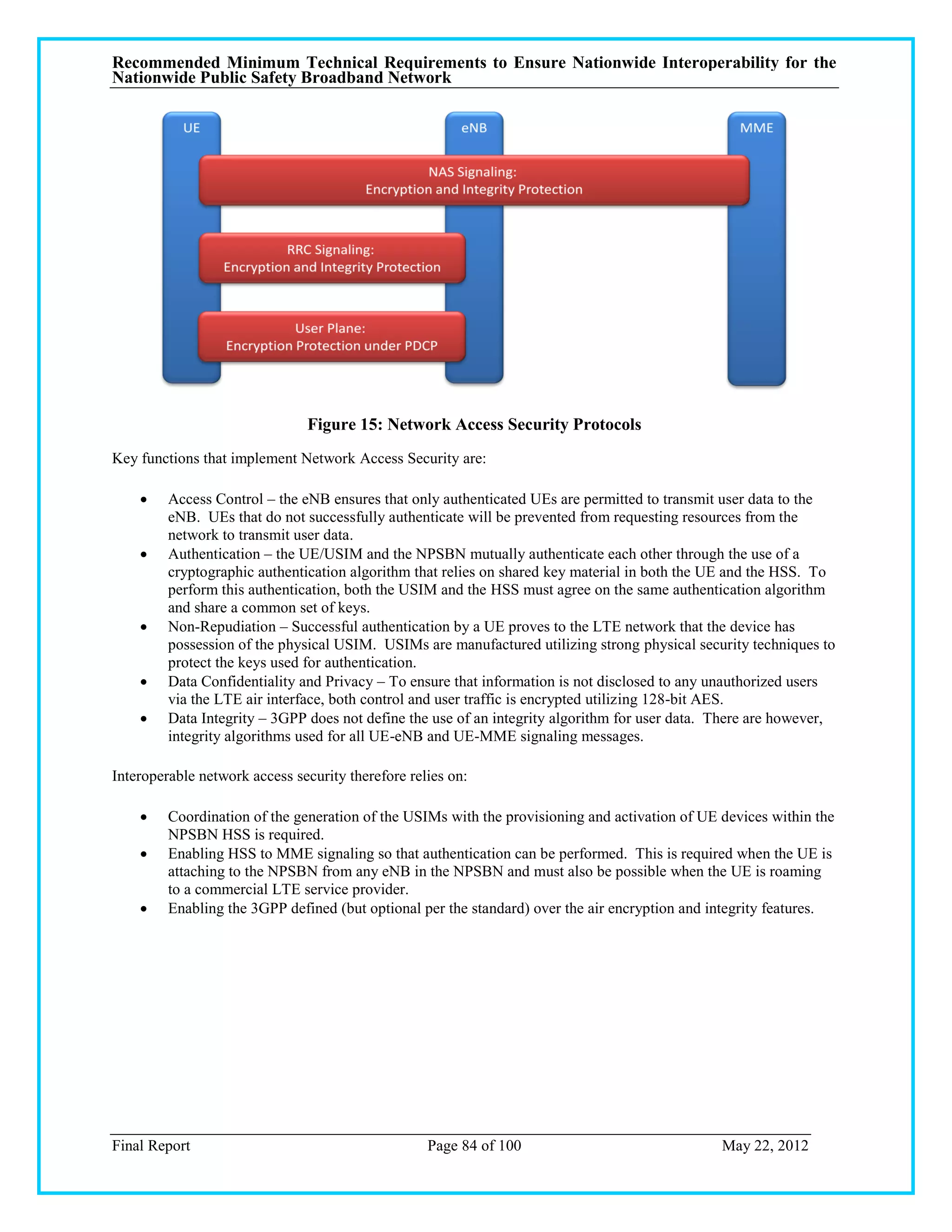
![Recommended Minimum Technical Requirements to Ensure Nationwide Interoperability for the
Nationwide Public Safety Broadband Network
Recommended Requirements
[38] The NPSBN SHALL use a nationwide common security profile for user plane and control plane traffic
between UEs, eNBs and MMEs, in accordance with 3GPP LTE Network Access Domain protocols.
The profile SHALL be based on 3GPP TS 33.401, and will be determined by FirstNet based on a system
design and other considerations as it deals with evolving cyber threats. As a minimum, the profile
SHALL include specification of ciphering algorithms (for example, use of AES-128 vs. SNOW 3G).
[39] The nationwide common security profile SHALL include ciphering of control plane traffic in order to
provide for interoperable cyber protection of the network. Ciphering of user plane traffic is optional and
is based on policy decisions that involve FirstNet and user agencies.
[40] To enable interoperable authentication, the USIM and HSS SHALL be capable of supporting the same
key derivation functions, such as Milenage per 3GPP TS 35.205, 35.206.
Recommended Considerations
As of the writing of this report, TS 33.401 specifies two different algorithms for 128-bit encryption and message
authentication, SNOW 3G and AES.
(44) Equipment used in the NPSBN SHOULD support AES and SNOW 3G algorithms.
The intention is to ensure cryptographically agile deployments that can be reconfigured to utilize an alternative
encryption standard (SNOW 3G) if exploits to the 128-bit AES algorithm are discovered.
4.8.3.2 Network Domain Security
The Interoperability Board recommends that FirstNet define the networks, identify the domains of the system, and
then apply consistent security policies for interfaces both internal to domains under the control of the NPSBN and
also between domains. In the following figure the administrative Domain A controls NE1, NE2 and NE3 and
determines the security controls and policies for communication between these network elements. The same is true
with the equipment in administrative Domain B for NE4, NE5 and NE6. The interface between these two distinct
administrative domains is governed by interoperable security controls and policies. 3GPP TS 33.210 specifies the
use of IPSec as the Inter-Domain security control.
Figure 16: Intra-Domain and Inter-Domain Illustration
Final Report Page 85 of 100 May 22, 2012](https://image.slidesharecdn.com/interopboardfinalreport052212-13388963580201-phpapp02-120605064116-phpapp02/75/FCC-Interop-Board-Final-Report-05-22-12-85-2048.jpg)
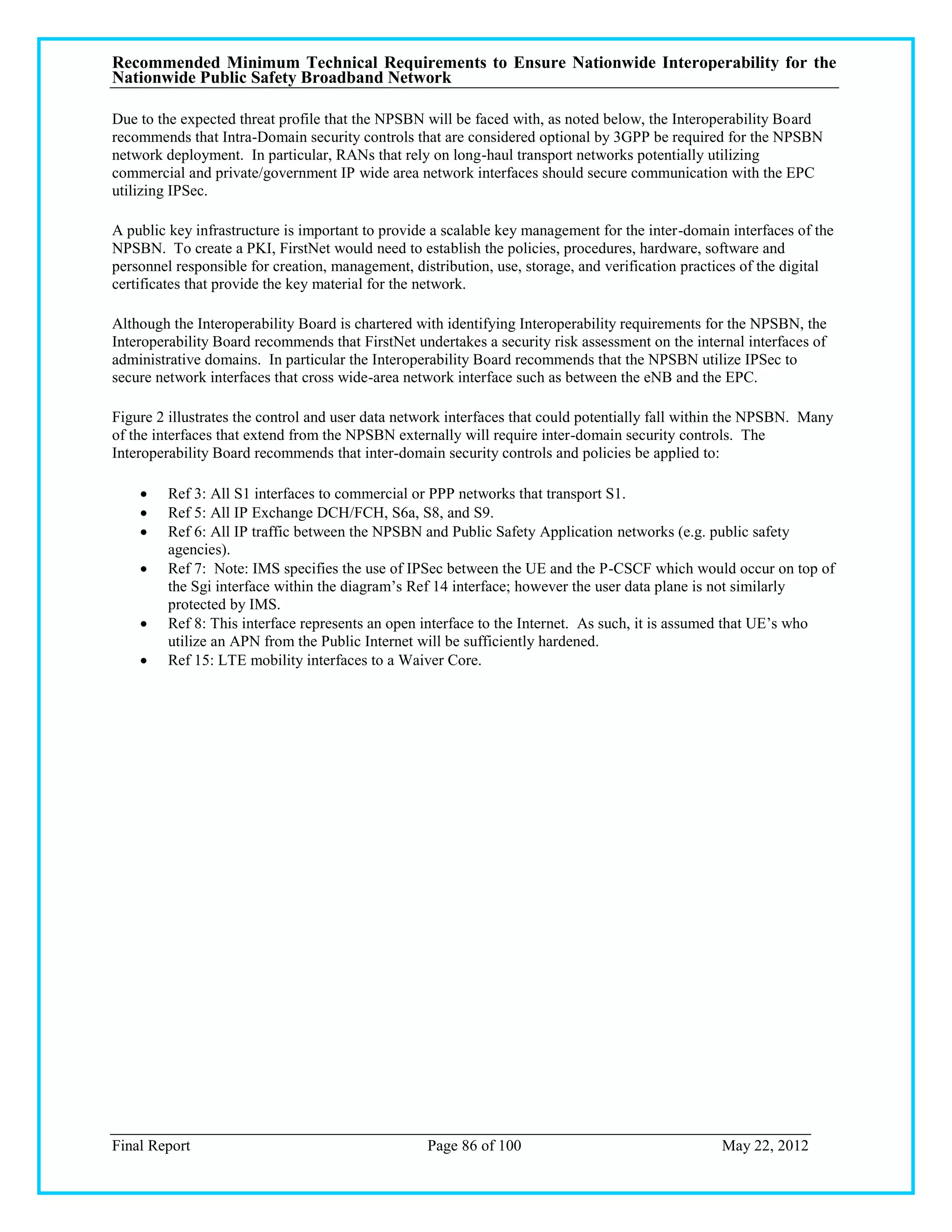
![Recommended Minimum Technical Requirements to Ensure Nationwide Interoperability for the
Nationwide Public Safety Broadband Network
Recommended Requirements
[41] Network Domain Security SHALL be implemented in accordance with 3GPP TS 33.210, which
stipulates the use of IPSec to protect IP communication between administrative domains (including all
network connections used to interconnect the domains).
[42] The NPSBN SHALL comply with TS 33.310 as the authentication framework for Public Key
Infrastructure to authenticate these network interfaces.
[43] In order to ensure secure and interoperable interfaces between the NPSBN and external elements (e.g.
all SGi, Rx and Srvs services as shown in Figure 2), these interfaces SHALL be protected with a
FirstNet-approved security mechanism.
Recommended Considerations
(45) FirstNet SHOULD establish the security controls and policy for inter-domain security and require that
all parties (e.g. public safety agencies) who connect to the NPSBN utilize FirstNet-approved cipher
suites.
(46) FirstNet SHOULD consider using IPSec interfaces that utilize IKEv2 and utilize PKI to authenticate the
peers of the IPSec Security Associations.
(47) When EPS elements are located in trusted locations without wide area communication links between
them, the use of network domain security SHOULD be optional.
(48) Network interfaces between domains SHOULD be monitored and intrusion detection/prevention tools
SHOULD be deployed.
(49) The developed security mechanisms SHOULD permit local entities to hide the topologies and address
spaces of their networks.
4.8.3.3 User Domain Security
Per 3GPP Standards, User Domain Security involves two features:
User-to-USIM authentication:
This feature provides the property that access to the USIM is restricted until the USIM has authenticated
the user. Thereby, it is ensured that access to the USIM can be restricted to an authorised user or to a
number of authorised users. To accomplish this feature, user and USIM must share a secret (e.g. a PIN)
that is stored securely in the USIM. The user gets access to the USIM only if he/she proves knowledge of
the secret. This security feature is implemented by means of the mechanism described in TS 31.101.
USIM-Terminal Link
This feature ensures that access to a terminal or other user equipment can be restricted to an authorised
USIM. To this end, the USIM and the terminal must share a secret that is stored securely in the USIM and
the terminal. If a USIM fails to prove its knowledge of the secret, it will be denied access to the terminal.
This security feature is implemented by means of the mechanism described in TS 22.022.
Final Report Page 87 of 100 May 22, 2012](https://image.slidesharecdn.com/interopboardfinalreport052212-13388963580201-phpapp02-120605064116-phpapp02/75/FCC-Interop-Board-Final-Report-05-22-12-87-2048.jpg)
![Recommended Minimum Technical Requirements to Ensure Nationwide Interoperability for the
Nationwide Public Safety Broadband Network
Recommended Requirements
[44] User Domain Security SHALL be implemented in accordance with 3GPP TS 33.102, TS 31.101, and
TS 22.022.
4.8.3.4 Application Domain Security
Application Domain Security enables for secure messaging between the USIM and the network (TS 33.102).
USIM Application Toolkit, as specified in TS 31.111 [15], provides the capability for operators or third
party providers to create applications which are resident on the USIM (similar to SIM Application Toolkit
in GSM). There exists a need to secure messages which are transferred over the network to applications on
the USIM, with the level of security chosen by the network operator or the application provider.
Security features for USIM Application Toolkit are implemented by means of the mechanisms described in
TS 23.048 [7]. These mechanisms address the security requirements identified in TS 22.048 [16].
Recommended Requirements
[45] USIM-based applications that require messaging between the USIM and network components SHALL
implement Application Domain Security in accordance with 3GPP TS 33.102 and TS 31.111.
4.8.3.5 Visibility and Configurability of Security
In some public safety use cases, it is desirable or even necessary to provide user feedback concerning the security
level that a user device is operating (such as Secure or Not Secure). 3GPP LTE standards provide mechanisms for:
indication of access network encryption: The property that the user is informed whether the confidentiality
of user data is protected on the radio access link, in particular when non-ciphered calls are set-up.
indication of the level of security: The property that the user is informed on the level of security that is
provided by the visited network, in particular when a user is handed over or roams into a network with a
lower security level.
The ciphering indicator feature is specified in 3GPP TS 22.101.
3GPP TS133.102 describes configurability as:
Configurability is the property that the user can configure whether the use or the provision of a service should
depend on whether a security feature is in operation. A service can only be used if all security features, which
are relevant to that service and which are required by the configurations of the user, are in operation. The
following configurability features are suggested:
Enabling/disabling user-USIM authentication: the user should be able to control the operation of user-
USIM authentication, e.g. for some events, services or use;
Accepting/rejecting incoming non-ciphered calls: the user should be able to control whether the user
accepts or rejects incoming non-ciphered calls;
Setting up or not setting-up non-ciphered calls: the user should be able to control whether the user sets
up connections when ciphering is not enabled by the network;
Accepting/rejecting the use of certain ciphering algorithms: the user should be able to control which
ciphering algorithms are acceptable for use.
As noted in the ERIC PSAC report, user control of security parameters or their usage is not a generally accepted
practice in public safety.
Final Report Page 88 of 100 May 22, 2012](https://image.slidesharecdn.com/interopboardfinalreport052212-13388963580201-phpapp02-120605064116-phpapp02/75/FCC-Interop-Board-Final-Report-05-22-12-88-2048.jpg)
![Recommended Minimum Technical Requirements to Ensure Nationwide Interoperability for the
Nationwide Public Safety Broadband Network
Recommended Requirements
[46] In such cases where visibility is required for devices on the NPSBN, the implementations SHALL
comply with 3GPP TS 33.102 and TS 22.101.
4.8.4 Support for Jurisdictional Security Policies
It is essential that the NPSBN support layered security policies that permit jurisdictions to implement their unique
security policies, provided that doing so does not compromise the overall security of the NPSBN. Inherently, a
jurisdictional security implementation, layered on top of the NPSBN will only be interoperable to users authorized
by the jurisdictional security authority. While these layered security mechanisms must be supported, doing so must
not be to the detriment of interoperability for users that are not part of that security domain. For example, a
jurisdiction may require a particular 2-factor authentication scheme in connection with a secure VPN, based on a
commercially available technology. The secure VPN will limit access to a network domain to only authorized
users. It is important that this VPN does not have a negative impact to users that are not part of that network
domain.
Recommended Considerations
(50) Security mechanisms layered by a jurisdiction on top of the NPSBN SHOULD NOT inhibit
interoperability for users visiting from outside of the security domain in which it is implemented.
4.8.5 Roaming
Section 6206(c)(5) of the Spectrum Act permits FirstNet to enter into roaming agreements with commercial
network providers. There are many security implications for these roaming agreements that will require robust
risk/threat/vulnerability analysis. Of particular concern is the possibility that implementation of these agreements
could undermine the security requirements contained in this document. As an example, with 3GPP technologies, a
user device is authenticated in the Home Network, and not in the visited network. Therefore, a user device homed
to a commercial network would be authenticated by the commercial network and not the NPSBN. If the
commercial network operates with an authentication implementation that is less stringent than the NPSBN, a form
of ―bidding-down‖ of security requirements will occur for users that are homed on a commercial network but
operating on the NPSBN RAN and Serving network. FirstNet will need to balance the security requirements with
meeting an interoperability goal of this board: to utilize commercially adopted standards.
Recommended Considerations
(51) As FirstNet enters into roaming agreements with commercial partners, security policies SHOULD be
implemented that ensure integrity of the NPSBN and that NPSBN security practices are not
compromised.
4.8.6 Identity Management and Identity Federation
3GPP standards implement security mechanisms such as authentication from a device perspective, specifically the
UE. While these mechanisms are built on sound security principles, they do not support many of the use cases that
are important in public safety. There is growing consensus at all levels of government that there is the need to
provide authentication not only for user devices, but also for individuals that have access to the NPSBN and for data
objects that are accessible by authorized users.
With the proliferation and mobility of devices it will be imperative that the NPSBN ensure that not only are devices
authenticated, but that those attempting to use those devices are also authenticated. Because first responders are
often asked to support other agencies in mutual aid scenarios, an open, standards based, federated identity
management framework is essential to enable users to have interoperable access to applications and data when
Final Report Page 89 of 100 May 22, 2012](https://image.slidesharecdn.com/interopboardfinalreport052212-13388963580201-phpapp02-120605064116-phpapp02/75/FCC-Interop-Board-Final-Report-05-22-12-89-2048.jpg)
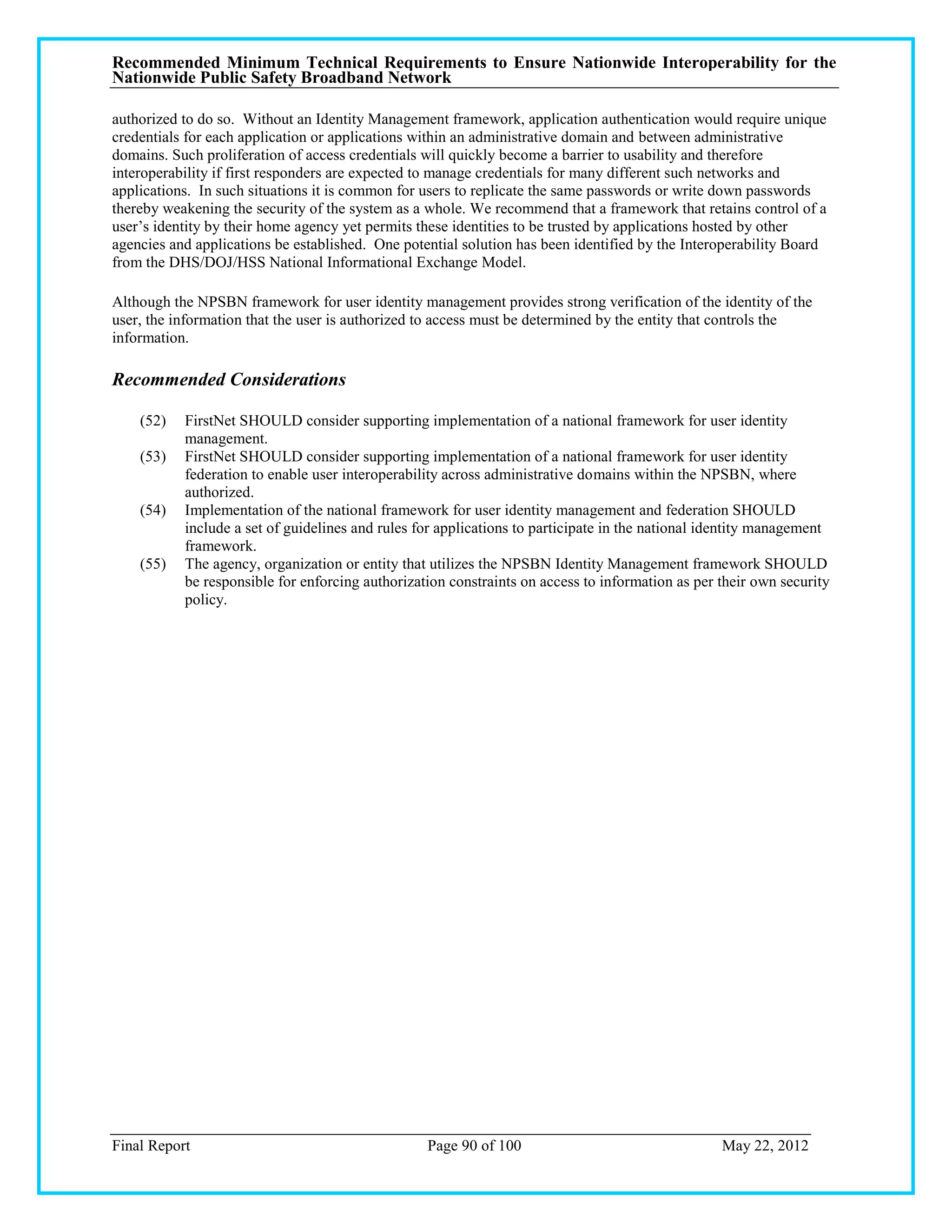
![Recommended Minimum Technical Requirements to Ensure Nationwide Interoperability for the
Nationwide Public Safety Broadband Network
5 Conclusions
The establishment of minimum technical requirements to ensure a nationwide level of interoperability may seem
like a relatively straightforward task. Long Term Evolution (LTE), after all, is based on a set of international
standards (3GPP) which are being widely deployed in functioning commercial networks around the world. When
one realizes the long term implication of these minimum requirements to the most critical function of government -
ensuring the safety of its citizens - the task takes on an added level of gravity and complexity.
This gravity and complexity was noted by Deputy Assistant Secretary Anna Gomez in her remarks before the
Interoperability Board on April 23, 2012. In describing the requirements the Interoperability Board was charged
with developing, Deputy Assistant Secretary Gomez said ―we [NTIA] view [them] as a constitution.‖ This analogy
was recalled at numerous times during the Interoperability Board‘s deliberations as it considered aspects of its work
that protected the constituency of the NPSBN (public safety) and the role of those that would govern the NPSBN
(FirstNet).
One of the most difficult issues the Interoperability Board dealt with throughout its deliberations was the very thin
line that often exists between operability and interoperability. Establishing minimum requirements without a clear
understanding of why they are important and how they should be used (operability) is analogous to the United
States Constitution without the Federalist Papers. Just as the Federalist Papers are key to the understanding of our
Constitution, the informative comments and recommendations made in this document are critical to understanding
and implementing the minimum technical requirements for interoperability in a way that ensures operability. While
these informative comments and recommendations do not rise to the level of an "incomparable exposition of the
Constitution‖ as historian Richard B. Morris said of the Federalist Papers, the Interoperability Board believes them
to be critical to the development of the NPSBN and to its overall success.
In finalizing its set of recommended requirements, the Interoperability Board carefully assessed the sometimes
competing components of its relevance tests. There were many discussions around the following topics:
Whether draft requirements could be considered ―minimum technical requirements‖ as mandated by the
Spectrum Act
Whether draft requirements addressed operability or interoperability
Whether draft requirements were technical or operational
Striking a proper balance between granting FirstNet the flexibility it will need to build and maintain the
NPSBN while providing the specificity needed to both set a proper course for FirstNet and give the FCC
useful tools to determine whether to approve State opt-out plans
The proper of level of detail to specify requirements in the absence of a nationwide network architecture
How best to ensure interoperability is maintained as FirstNet and LTE technology evolves
In all its discussions, the Interoperability Board members considered the valuable input it received through the
filings in the Docket and its Public Workshop, and the important contributions made by the Consulting Agencies. 39
The Interoperability Board expresses its gratitude to the Consulting Agencies and subject matter experts that gave
many hours of their time to this effort. The Interoperability Board extends a special thanks to the staff of the Public
Safety and Homeland Security Bureau of the FCC, without whose support the Interoperability Board could not have
accomplished its task. Through this unique collaboration between 15 Interoperability Board members, many SMEs,
the Consulting Agencies and the public, the Interoperability Board was able to achieve its legislative mandate in the
allotted 60 days. The Interoperability Board is confident that its recommended minimum technical requirements
will provide a solid foundation for the successful development of the NPSBN.
39
Federal Communications Commission Public Notice DA 12-474.
Final Report Page 91 of 100 May 22, 2012](https://image.slidesharecdn.com/interopboardfinalreport052212-13388963580201-phpapp02-120605064116-phpapp02/75/FCC-Interop-Board-Final-Report-05-22-12-91-2048.jpg)
